Dr Rajiv Desai
An Educational Blog
TORTURE
TORTURE:
_
_
Mohammed C., a Chadian born in Saudi Arabia, was just 14 when arrested in Pakistan in October 2001. After three weeks he was handed to US officials. He says he was hooded, shackled, beaten and threatened with death. In January 2002 he was transferred to Guantánamo Bay, where he says he was beaten, deprived of sleep, racially abused and burned with a cigarette. In September 2005 Mohammed, by now an adult, was still being held without charge in Guantánamo Bay. Torture is one of the most extreme forms of human violence, resulting in both physical and psychological consequences. Torture has been used for thousands of years, and is still widespread, occurring throughout much of the world (Amnesty International, 2009). Research has shown that torture can have enduring negative effects on both survivors and perpetrators, and is ineffective for obtaining reliable information in interrogation. Survivors of torture from the former Yugoslavia, Turkey, the Middle East, Southeast Asia, and other regions require medical, social, and psychotherapeutic assistance. Unfortunately, torture survivors often meet with silence and disbelief from others—a profound unwillingness to confront the reality of their suffering. The very nature of torture, which destroys the dignity and well-being of its victims, often makes survivors themselves doubt this reality: as a result, they feel completely alone and may no longer believe in the possibility of human communication. Whether torture of terror suspect is justified or not? Does torture work or not? These are the questions in my mind but torture certainly spread fear in Afghanistan and Iraq. Torture is not just responsive, it is productive. It produces enemies. Abu Ghraib prison abuse made Muslim world hate Americans. One example of torture is sufficient to provoke outrage. “Detainee No. 063 was forced to wear a bra. He had a thong placed on his head. He was massaged by a female interrogator who straddled him like a lap dancer. He was told that his mother and sisters were whores.”
_
Former President George W Bush was forced to cancel a highly paid speaking engagement to an Israeli group in Switzerland. For the first time in American history, a former president is not free to travel, even to peaceful Switzerland, because of the fear of being arrested. A 2500 page criminal indictment of George W Bush was said to be awaiting Bush if he entered Switzerland. This was not reported in any American mainstream media. Bush has admitted of ordering “waterboarding” of terror suspects, which obligate the 147 nations that are signatory to the United Nations Convention on Torture to arrest Bush.
_
A joke that made the rounds in Chile following the military coup went like this: “A terrified bunny rabbit runs off to the border. The guard who stops him on the other side asks, ‘what are you running away from?’ He answers, ‘They’re killing all the elephants in Chile.’ The border guard soothes him, saying ‘That’s OK, you’re a bunny.’ The bunny answers, “And how am I supposed to prove that?” The joke reflects the popular knowledge that seemingly random victims were arrested and tortured and killed.
_
Torture is an ancient art of inflicting physical, mental, and/or emotional pain on somebody for information, as punishment, or just sheer sadistic pleasure. Torture is not limited to humans; disturbed sickos will also torture innocent animals. However, I will not discuss torturing of animals by humans in this article. Torture is not limited to history; it’s still around. Torture has been carried out in every way possible; you name it, it’s been done.
_
Torture is the intentional infliction of severe physical or psychological torment as an expression of cruelty, a means of intimidation, deterrent, revenge or punishment, or as a tool for the extraction of information or confessions. The common concept of torture is that torture causes pain (or a threat of pain) to the body, but it can also cause terrible effects and associated damage to the psyche. Torture is the deliberate infliction of pain to extract information or to punish opponents. Today, torture continues to be used throughout the world for political purposes. Repressive governments use torture against individuals, such as political and religious leaders, judges, journalists, educators and health professionals, as well as whole communities, in order to terrorize and control them. Torture is common in situations where disparities in interpersonal power and control occur. It is a well known theme in religious, political, and military histories. It is less well known in social contexts such as domestic abuse, child abuse, incest, rape, mobbing and elder abuse. Torture to children, in particular, can induce particularly terrible traumas because, in addition to the suffering, children absorb torture with little ability to limit its effects, lose childhood development opportunities forever and often encode the torturer’s distortions instead.
_
Modern torture is designed to enhance pain–both physical and mental–while leaving a minimum of physical marks. Victims are commonly caged in excessively small places, beaten repeatedly on the soles of the feet (often resulting in permanent physical damage), or made to hear loved ones tortured. Their heads are put in plastic bags or submerged in liquid usually contaminated with vomit or feces. Their bodies are burned with cigarettes. It’s estimated that 80% of women taken into custody are raped–often in front of other family members. Men frequently have electrodes attached to their penises.
_
Torture is infliction of severe physical pain as a means of punishment or coercion or an instrument or a method for inflicting such pain. In a broad sense, torture might be regarded as any instance in which pain is inflicted by one human being on another, either for personal gratification or to demonstrate power. But historically, torture has most often been defined more narrowly, as an aspect of legal systems or of state repression. The third century Roman jurist, Ulpian noted that by torture ‘we are to understand the torment and suffering of the body in order to elicit the truth’. In 1600 Anton Praetorius fought against torture and against the hunting of witches. Almost all countries agree that torture is a violation of human rights. This has been stated in the Universal Declaration of Human Rights. It is more difficult for people to agree what things are tortures and what things are okay to do to prisoners. Torture is a crime in many countries and it was made against the law on December 10th, 1948.
_
Torture is the act of inflicting severe pain (whether physical or psychological) as a means of punishment, revenge, forcing information or a confession, or simply as an act of cruelty. Throughout history, torture has taken on a wide variety of forms, and has often been used as a method of political re-education, interrogation, punishment, and coercion. In addition to state-sponsored torture, individuals or groups may be motivated to inflict torture on others for similar reasons to those of a state; however, the motive for torture can also be for the sadistic gratification of the torturer. The word ‘torture’ comes from the French torture, originating in the Late Latin tortura and ultimately deriving the past participle of torquere meaning ‘to twist’. Many characteristically Christian tortures rely on a twisting of the limbs, twisting ligatures, or turning screw mechanisms as the Church discouraged the shedding of blood. The word is also used loosely to describe more ordinary discomforts that would be accurately described as tedious rather than painful; for example, “making this spreadsheet was torture!”
_
Definition of torture:
Torture, according to the 1984 United Nations Convention Against Torture (an advisory measure of the UN General Assembly) is:…any act by which severe pain or suffering, whether physical or mental, is intentionally inflicted on a person for such purposes as obtaining from him, or a third person, information or a confession, punishing him for an act he or a third person has committed or is suspected of having committed, or intimidating or coercing him or a third person, or for any reason based on discrimination of any kind, when such pain or suffering is inflicted by or at the instigation of or with the consent or acquiescence of a public official or other person acting in an official capacity. It does not include pain or suffering arising only from, inherent in, or incidental to, lawful sanctions. This definition was restricted to apply only to nations and to government-sponsored torture and clearly limits the torture to that perpetrated, directly or indirectly, by those acting in an official capacity. There are some significant shortcomings in this definition such as it only applies to states and not non-state actors, it only applies to torture done for certain reasons (information gathering, intimidation, coercion, and discrimination), and it does not include sexual crimes as constituting a form of torture. It appears to exclude:
1. Torture perpetrated by gangs, hate groups, rebels or terrorists who ignore national or international mandates;
2. Random violence during war;
3. Punishment allowed by national laws, even if the punishment uses techniques similar to those used by torturers such as mutilation or whipping when practiced as lawful punishment. Some professionals in the torture rehabilitation field believe that this definition is too restrictive and that the definition of politically motivated torture should be broadened to include all acts of organized violence.
__
_
_
In 1986, the World Health Organization working group introduced the concept of organized violence, which was defined as: “The inter-human infliction of significant, avoidable pain and suffering by an organized group according to a declared or implied strategy and/or system of ideas and attitudes. It comprises any violent action that is unacceptable by general human standards, and relates to the victims’ feelings. Organized violence includes “torture, cruel inhuman or degrading treatment or punishment” as in Article 5 of the United Nations Universal Declaration of Human Rights (1984). Imprisonment without trial, mock executions, hostage-taking, or any other form of violent deprivation of liberty, also fall under the heading of organized violence.”
_
An even broader definition was used in the 1975 Declaration of Tokyo regarding the participation of medical professionals in acts of torture: For the purpose of this Declaration, torture is defined as the deliberate, systematic or wanton infliction of physical or mental suffering by one or more persons acting alone or on the orders of any authority, to force another person to yield information, to make a confession, or for any other reason. This definition includes torture as part of domestic violence or ritualistic abuse, as well as in criminal activities.
_
Since 1973 Amnesty International has adopted the simplest, broadest definition of torture: “Torture is the systematic and deliberate infliction of acute pain by one person on another, or on a third person, in order to accomplish the purpose of the former against the will of the latter”.
__
The Encyclopedia of Ethics defines torture as “the deliberate infliction of violence, and through violence, severe mental and/or physical suffering upon individuals. It may be inflicted by individuals or groups and for diverse ends, ranging from extracting information, confession, admission of culpability or liability, and self-incrimination to general persuasion, intimidation, and amusement.” Notably, torture is not necessarily a form of punishment, though it could be—both deterrence and retribution theorists could advance arguments in its support. Rather, torture can also be used instrumentally in order to achieve important aims, such as the acquisition of important information. A related concern has to do with the definition of “torture”; while some practices might clearly violate our anti-torture stance; there are others whose standing is less clear. A recent Washington Post article detailed American interrogation methods and quoted American officials who admit to the beating of prisoners, the withholding of medical treatment, and “stress and duress” techniques, such as sleep deprivation, hooding, and forcing prisoners to hold awkward positions for hours. Prisoners may be placed in environments which resemble those of hostile countries (e.g., Arabs may be distraught to observe an Israeli flag flying overhead), or they may be subjugated to interrogations by female agents—this is psychologically traumatic for men raised in conservative Muslim cultures. The officials have maintained that these practices, while certainly unpleasant, have nevertheless fallen short of torture; they maintain that all treatments of prisoners is consistent with the Third Geneva Convention of 1949 which delineated acceptable practices of confinement and interrogation. Despite the interesting legal and policy questions inherent in a debate regarding torture, I am more concerned with the morality of torture than the legality but, insofar as legality tracks morality, if torture could be shown to be morally permissible then there might be cause for legal reform.
_
_
_
UN definition-1975
_
_
_
The figure below shows torture related concepts:
_
Torture as per American law:
1)“Torture” means an act committed by a person acting under the color of law specifically intended to inflict severe physical or mental pain or suffering (other than pain or suffering incidental to lawful sanctions) upon another person within his custody or physical control;
2) “Severe mental pain or suffering” means the prolonged mental harm caused by or resulting from—
(A) The intentional infliction or threatened infliction of severe physical pain or suffering;
(B) The administration or application, or threatened administration or application, of mind-altering substances or other procedures calculated to disrupt profoundly the senses or the personality;
(C) The threat of imminent death; or
(D)The threat that another person will imminently be subjected to death, severe physical pain or suffering, or the administration or application of mind-altering substances or other procedures calculated to disrupt profoundly the senses or personality; and
3) “United States” means the several States of the United States, the District of Columbia, and the commonwealths, territories, and possessions of the United States.
_
Torture and democracy:
_
Torture and public authority:
_
So in the nutshell, Torture is:
(a) The intentional infliction of extreme physical and/or psychological suffering on some non-consenting, defenseless person;
(b) The intentional, substantial curtailment of the exercise of the person’s autonomy [achieved by means of (a)];
(c) In general, undertaken for the purpose of breaking the victim’s will.
_
Torture during interrogation consists of a physical act – the infliction of pain and a verbal act – the interrogation. The verbal act in its turn consists of:
1. The question, which is mistakenly understood to be the motive; and
2. The answer which is mistakenly understood to be the betrayal.
The mistaken idea of question as motive provides the torturer with a justification and an explanation for his cruelty. The second mistaken belief in “betrayal” discredits the victim rather than the torturer. The victim’s voice and words rather than his pain are identified as the cause of his loss of world and self. These misunderstandings are not accidental. They turn the moral reality of torture upside down. They shift the focus from the physical, repugnant act of torture, to the verbal arena of confession thereby accommodating and crediting the torturers. It is the victim’s steadily shrinking ground that wins for the torturer his swelling sense of territory and power. As the victim’s voice diminishes, that of the torturer and regime doubles. The larger the prisoner’s pain the larger, by comparison, is the torturer’s world. This extension of the torturer’s power and the insignia of the regime attempts to explain how one human being can, not only be in the presence of another’s excruciating pain and appear oblivious to it but, be the cause of the existence and the continuation of this pain.
_
History of torture:
_
Amazingly, the horrific torture by wheel depicted here did not stop the monks pictured from waiting for the martyr’s confession with quill in hand.
_
For most of recorded history, capital punishments were often deliberately painful. Severe historical penalties include the breaking wheel, boiling to death, flaying, disembowelment, crucifixion, impalement, crushing, stoning, execution by burning, dismemberment, sawing, scaphism, or necklacing. The ancient Greeks and Romans used torture for interrogation. Until the 2nd century AD, torture was used only on slaves (with a few exceptions). After this point it began to be extended to all members of the lower classes. A slave’s testimony was admissible only if extracted by torture, on the assumption that slaves could not be trusted to reveal the truth voluntarily. In the Middle Ages torture was used to extract information, force confessions, punish suspects, frighten opponents, and satisfy personal hatred. Historically, ancient Greeks and Romans used torture for interrogation.
_
_
Torture has been used by governments throughout history for punishment, coercion, and intimidation and for extracting confessions and information. A common practice in ancient times, it was defended by Aristotle but eloquently opposed by Cicero, Seneca, and St. Augustine. Beginning in the 12th century, torture was increasingly used in Europe; from the mid-14th through the 18th century it was a common part of the legal proceedings of most European countries.
_
_
Over time the conceptual definition of torture has been expanded and remains a major question for ethics, philosophy, and law, but clearly includes the practices of many subsequent cultures. Modern scholars find the concept of torture to be compatible with society’s concept of Justice during the time of Jesus Christ. Romans, Jews, Egyptians and many others cultures during that time included torture as part of their justice system. Romans had crucifixion, Jews had stoning and Egyptians had desert sun death. All these acts of torture were considered necessary (as to deter others) or good (as to punish the immoral). Medieval and early modern European courts used torture, depending on the crime of the accused and his or her social status. Torture was deemed a legitimate means to extract confessions or to obtain the names of accomplices or other information about a crime. Often, defendants already sentenced to death would be tortured to force them to disclose the names of accomplices. Torture in the Medieval Inquisition began in 1252 and ended in 1816 when a papal bull (formal statement by the Pope) forbade its use. By 1800 torture was illegal in many European countries, but it became common again in the 20th century, notably in Nazi Germany and the Soviet Union, and it is still widely practiced in Latin America, Africa, and the Middle East. Universal prohibition against torture was realized only in the aftermath of WWII in 1948 and in 1984 the United Nations adopted an international convention against torture and other forms of cruel, inhuman, and degrading treatment. By the early 21st century some 130 countries were party to the convention.
__
Modern sensibilities have been shaped by a profound reaction to the war crimes and crimes against humanity committed by the Axis Powers in the Second World War, which have led to a sweeping international rejection of most if not all aspects of the practice. Even as many states engage in torture, few wish to be described as doing so, either to their own citizens or to the international community. A variety of devices bridge this gap, including state denial, “secret police”, “need to know”, a denial that given treatments are torturous in nature, appeal to various laws (national or international), the use of jurisdictional argument and the claim of “overriding need”. Throughout history and today, many states have engaged in torture, albeit unofficially. According to scholar Ervand Abrahamian, although there were several decades of prohibition of torture that spread from Europe to most parts of the world, by the 1980s, the taboo against torture was broken and torture “returned with a vengeance,” propelled in part by television and an opportunity to break political prisoners and broadcast the resulting public recantations of their political beliefs for “ideological warfare, political mobilization, and the need to win ‘hearts and minds.'” According to professor Darius Rejali, although dictatorships may have used tortured “more, and more indiscriminately”, it was modern democracies, “the United States, Britain, and France” who pioneered and exported techniques that have become the lingua franca of modern torture: methods that leave no marks.” Torture has become distressingly common in liberal democracies despite several international treaties such as the International Covenant on Civil and Political Rights (ICCPR) and the UN Convention Against Torture (CAT) making torture illegal. Despite such international conventions, torture cases continue to arise such as the 2004 Abu Ghraib torture and prisoner abuse scandal committed by military police personnel of the United States Army. The US Constitution and US federal law prohibits the use of torture, yet such human rights violations occurred. Soldiers involved in the violations have been tried and sentenced to prison, and additional court cases are pending on other persons who engaged in such violations. At least one alleged person who engaged in a violation, an alleged homicide, was granted qualified immunity.
_
Triple use of pain from medieval historical times:
There are three historical ways in which individuals and populations with little power are made to interact with those who are in power, where those in power have as their purpose the control or acquisition of information. The common element has been “pain”:
(1) Pain used as punishment,
(2) Pain used for religious or ideological confession, and
(3) Pain used to elicit “truthful” information and/or intelligence.
Pain administered publicly as punishment has been used for its demonstration effect: It is designed to deter opposition, control populations, and display the power of the government, or of rulers. Individuals have been punished to deter others from proscribed acts; entire groups have been executed in painful, public ways in order to maintain control over empires. Of course, the effect of such a public spectacle has depended on the character of the viewing audience. The public might find it simply fascinating. Some well-known examples include Aztec flaying, Roman circuses, group beheadings by Genghis Khan, and public tortures known to the Hindu dynasties in early India. It is said that Nero enjoyed watching people being thrown off the city walls; the Nazis took pictures of their victims for later viewing; and drawing and quartering as well as hanging in medieval England were accepted public spectacle. Most recently and instructively, the number of people who tried to access pictures of Abu Ghraib prisoner mistreatment numbered in the millions within 48 hours after they were posted. Evidently, public fascination with the infliction of pain on others is not merely an historical phenomenon. The second focus is on the use of pain to elicit confession. Between the 12th and 14th centuries, punishment was given a religious quality by associating it with purification before a Supreme Being, or God. The individuals inflicting pain were only instruments in the hands of the Almighty, performing a service for the targeted individual. It was reasoned that if the tortured individual suffered sufficiently on this earth, he would not have to undergo the sufferings of eternal damnation. The purification of each individual helped society in turn by exorcising the evil from within it – the cancer could not spread. Infliction of physical pain was rationalized, justified, and blessed by the more powerful in a society and even by God Himself. The use of pain to elicit truth in these centuries and those to follow was focused on truth as an ideological belief system congruent with church and political authority. The church was considered to have failed if the heretic refused to confess and recant. Only after the religious confession and ruling might the accused be turned over to the political/secular government for punishment and public execution, called “releasing” the prisoner to (non-ecclesiastical) authority. The secular authorities then applied punishment – ranging from public humiliation to public execution. This saved the poor soul from eternal damnation and only incidentally reinforced the power of religious and secular authorities. In addition, specific guidance regarding “evasive discourse” or how to tell when suspects are not telling the truth is found in the 13th-century manuals. Information can be obtained by the use of pain. Torture is centuries old. In medieval times, as a few examples, victims were stretched on a rack, burned with hot branding irons, stoned, or uncomfortably shackled. But over the past century, techniques and technologies of physical and psychological torture have been “refined.” Information can now be obtained without leaving a physical trace of the trauma of torture. Newer methods of torture have been driven by the need for speed in obtaining the information, and, in the case of governments, in disguising the torture from organizations like Amnesty International that can hinder the information-gathering process.
_
The table below shows Evolution of Information Elicitation by Authorities in the Common Era:
| PURPOSE | AUTHORITY | VENUE | TECHNIQUE | RESULT | EDUCER | |
| PUNISHMENT | Group repression | Empire | Public | Physical brutality | Fear toelicit obedience | Autocrat |
| CONFESSION | Cleanse; define in-group and out-group | Church and state | Private, secret, then public | Mental and physical | Promote loyalty and group cohesion | Zealot |
| TRUTH | Information, Intelligence to prevent further violence | State | Secret | Mental | Useful and timely information | Professional interrogator |
_
The goal of the interrogation process is to develop the truth.
_
The historical background of judicial torture:
All civilizations are known to have practiced torture. However, it was only during the Middle Ages that its programmatic deployment began. In antiquity, when there existed restrictions regarding the applicability of torture, humans were divided into torturable and non-torturable individuals (Amnesty International 1973, p. 31). In ancient Greece and Rome (the first empires, after the Egyptian one, to have partially systematized torture), slaves were the most likely victims of torture, though in certain cases of “treason,” free citizens could also incur such punishment. Furthermore, Roman law permitted the torturing of Christians in public spectacles. In time, the leaders of the empire collapsed all “plebeian” types under the category of torturable humans. Torture was extensively resumed and gradually legalized during the Middle Ages. That in the twelfth century the victim’s confession should have served as the “queen of proofs” (regina probationem) only further enhanced the legitimacy of torture. The Inquisition frantically used it against “heretics,” engendering thus the paradoxical phenomenon of Christian torturers. Since heretics pertained to the category of “infamous” defectors from God, torture could be regulated under criminal law; from the thirteenth century onwards, a certain doctrine of suffering started gaining acceptance. A further essential element emerged in the fourteenth century: the professional, state-authorized accuser, who specialized in exercising physical coercion in order to gather evidence for judicial proceedings. The prosecutor was thus a clog in the wheel of both the penal and the religious systems. Judicial torture was no medieval or early modern invention. The Roman third-century lawyer Ulpian defined torture as “the torment and suffering of the body in order to elicit the truth.” The actual jurisprudence of torture, however, only developed in connection with the twelfth-century “legal revolution,” as the revival of Roman law at the newly founded universities of Northern Italy is often called. Before this, crimes were mostly prosecuted privately, with no public officials taking an active role in criminal investigations. The predominance of private prosecution came under threat as popes, kings, and princes increasingly centralized their political authority in the twelfth century. The process began in Northern Italy in the twelfth century and gradually spread to most other parts of Europe in the remaining centuries of the Middle Ages. In the seventeenth century, the system of judicial torture began to lose its practical significance, although it formally remained part of the law in most European countries until the late eighteenth and early nineteenth centuries. An important reason for its gradual disappearance was the erosion of its theoretical basis, the statutory theory of proof. European states abolished torture from their statutory law in the late eighteenth and early nineteenth centuries. Prussia was the first to abolish it in 1754; Denmark abolished it in 1770, Austria in 1776, France in 1780, and the Netherlands in 1798. Bavaria followed the trend in 1806 and Württemburg in 1809. In Spain the Napoleonic conquest put an end to the practice in 1808. Norway abolished it in 1819 and Portugal in 1826. The Swiss cantons abolished torture in the first half of the nineteenth century. By the mid-nineteenth century, European legislators had thus harvested the fruits that the early modern revolution of proof, followed by Enlightenment philosophy, had produced. As Langbein and Peters observe, the final abolition of torture occurred gradually and in close connection with a general revision of criminal law. Legislative reforms took place partly simultaneously with, but in general slightly after, the Enlightenment philosophers’ attack on judicial torture.
_
Distinguishing and differentiating torture from other similar practices:
_
Interrogation:
Interrogation (also called questioning or interpellation) is interviewing as commonly employed by officers of the police, military, and Intelligence agencies with the goal of extracting a confession or obtaining information. Subjects of interrogation are often the suspects, victims, or witnesses of a crime. Interrogation seeks to acquire information from a person. Since the person being interrogated is often not comfortable with the process or even willing to divulge information, the interrogation process is different from a conversation. Conversationally, information is freely exchanged and offered. However, interrogation is a less compliant process. Interrogate means to question or quiz, especially in a thorough or aggressive manner. The police interrogated the suspect at some length before they let him go. Interrogation is not necessarily to force a confession, but rather to develop sufficient rapport as to prompt the source to disclose valuable information. Interrogation can take different forms, but these all have a similar aim: to control the subject in such a way that he or she yields to pressure and provides the information being asked for. There are multiple techniques employed in interrogation including deception, torture, increasing suggestibility, and the use of mind-altering drugs.
_
Interrogation Techniques:
1. Suggestibility:
The methods used to increase suggestibility are moderate sleep deprivation, exposure to constant white noise, and using GABAergic drugs such as sodium amytal.
2. Reid:
One notable interrogation technique is the Reid technique. However, the Reid technique (which requires interrogators to watch the body language of suspects to detect deceit) has been criticized.
3. Deception:
Deception can form an important part of effective interrogation. In the U.S., there is no law or regulation that forbids the interrogator from lying, from making misleading statements or from implying that the interviewee has already been implicated in the crime by someone else.
4. Torture:
Interrogations may involve torture, which is judged to be ineffective at producing accurate information but is effective in getting false confessions which might be useful for political reasons for the officer and organization in question by raising the number of successful investigations.
_
Custodial interrogation of suspects by police:
The police interrogation is primarily directed at obtaining an admission of guilt from a suspect who the police believe committed the offense that is attributed to him. Indeed, many suspects make incriminating statements as the result of an interrogation. A suspect’s admission of guilt during a police interrogation plays a major role in the criminal process. Such a confession constitutes decisive evidence at trial leading, in the overwhelmingly majority of cases, to a conviction. Detention is a major investigative tool for the purpose of eliciting confessions from suspects. The Supreme Court has recognized that “in the United States, ‘interrogation’ has become a police technique, and detention for purposes of interrogation a common, although generally unlawful practice.” In contrast to the grounds of endangering public safety or obstruction of justice, detention for the purposes of interrogation does not attribute a future improper act to the suspect. Detention on these grounds is primarily designed to ensure the convenience and effectiveness of the investigation. Detention serves two main purposes for police interrogators. The first is to act as a means of pressure designed to induce the suspect to cooperate with the interrogators. As the Court stated in Miranda, “… such an interrogation environment is created for no purpose other than to subjugate the individual to the will of his examiner.” The second objective of detention is to enable investigative measures or ruses that must be conducted within the confines of the detention facility. These include planting an undercover agent in the suspect’s cell, in order to get him to make an incriminating statement, and eavesdropping on the conversation of several persons suspected of having being involved in the commission of an offense, who have been brought together for this purpose. Undoubtedly, an interrogation in a custodial setting is easier and more effective for investigators than one conducted while the suspect is free. Detention itself operates to undermine the suspect’s will to resist. It isolates the suspect and deprives him of contact with his family and friends, who could provide him with moral support that enables him to cope with the interrogation. It disrupts the suspect’s daily routine and activities, such as: regular employment, normal dietary habits, sleeping in a comfortable bed and taking a bath. The disruption of his daily routine and the removal of the suspect from his normal environment create a sense of isolation and anxiety, causing him to become dependent on his interrogators. The suspect loses control over his life and it is the interrogators who determine the timing and length of the interrogation, as well as the degree of pressure exerted. When he is in this state of alienation and helplessness, it is easier for interrogators to exert psychological pressure on the suspect in order to induce his cooperation, primarily by confessing. The harsh conditions of detention also operate to undermine the suspect’s will to resist. It is no wonder, therefore, that custodial interrogations yield many more confessions from suspects than interrogations conducted while suspects are free. Custodial interrogation inherently violates the autonomy of the individual. As already indicated, the suspect is interrogated under circumstances in which he lacks power, control and dignity. The separation from family and friends; the disruption of daily routine; the confinement in a cell, in isolation or with others, some of whom may be hardened criminals, in conditions constantly reminding the detainee of his pitiful state – all of this is most certainly capable of undermining the suspect’s will. Under such circumstances, a waiver of rights cannot truly be considered voluntary.
_
When police officers torture, they know what the crime is and all they want is the confession. When intelligence officers torture, they must gather information about what they don’t know. However, many times police torture suspects to solve crimes. Many police officers believe that they have to deal with hardened criminals and only third-degree methods work for them. Corollary to this logic is that an innocent person who happens to be at the site of crime by sheer coincidence or a mistaken identity may be tortured by police to retrieve information or confession.
_
An analysis of these critical factors would suggest that interrogators operating what ultimately informs the methodology employed to collect data from a source is, in large measure, the nature of the information sought. It is critical, then, to understand the vital differences between gathering information to support a criminal case and gathering information to support foreign intelligence production.
_
| Criminal case | Foreign intelligence | |
| Objective: | Conviction | Understanding |
| Standard: | Legal Code | Analytical Methodology |
| Limits: | Rules of Evidence | None |
| Protections: | Fifth Amendment | None |
| Confession: | Considerable Value | Relative Value |
__
Torture versus interrogation:
The boundary between torture and legitimate interrogation techniques is not universally agreed. In a separate opinion, at the end of the 1978 in the European Court of Human Rights (ECHR) trial “Ireland v. the United Kingdom” (Case No. 5310/71), Judge Zekia stated that “It seems to me permissible, in ascertaining whether torture or inhuman treatment has been committed or not, to apply not only the objective test but also the subjective test. As an example I can refer to the case of an elderly sick man who is exposed to a harsh treatment—after being given several blows and beaten to the floor, he is dragged and kicked on the floor for several hours. I would say without hesitation that the poor man has been tortured. If such treatment is applied on a wrestler or even a young athlete, I would hesitate a lot to describe it as an inhuman treatment and I might regard it as a mere rough handling”.
_
When does torture begin? Where do you draw the line?
1. Questioning
2. Interrogation including lying, good cop/bad cop, some discomfort (bright light, thirst, pressure for need for restroom, isolation)
3. Enhanced Interrogation Techniques
4. Cruel, inhumane, and degrading treatment (CIDT)
5. Severe pain and suffering or equivalent in intensity to the pain accompanying serious physical injury, such as organ failure, impairment of bodily function, severe loss of mental faculty or even death.
__
Enhanced interrogation techniques:
Enhanced interrogation techniques or alternative set of procedures are terms that describe a George W. Bush administration authorization and use of certain severe interrogation methods including hypothermia, stress positions and waterboarding. These techniques were used by the Central Intelligence Agency (CIA) and the Department of Defense (DoD) in secret prisons, the Guantanamo Bay detention camps and Abu Ghraib prison on untold thousands of prisoners after the September 11 attacks in 2001 including notably Khalid Shaikh Mohammed, Abu Zubaydah and Mohammed al-Qahtani. American and European officials have called “enhanced interrogation” a euphemism for torture. In 2009 both President Barack Obama and Attorney General Eric Holder stated that certain of these techniques are torture, and repudiated their use. The CIA interrogation strategies were based on work done by James Elmer Mitchell and Bruce Jessen in the Air Force’s Survival Evasion Resistance Escape (SERE) program. These psychologists relied heavily on experiments done by American psychologist Martin Seligman in the 1970s on learned helplessness. In these experiments caged dogs were exposed to severe electric shocks in a random way in order to completely break their will to resist. Mitchell and Jessen applied this idea to the interrogation of Abu Zubaydah. Many of the interrogation techniques used in the SERE program, including waterboarding, cold cell, long-time standing, and sleep deprivation were previously considered illegal under U.S. and international law and treaties at the time of Abu Zubaydah’s capture. According to ABC News, former and current CIA officials have come forward to reveal details of interrogation techniques authorized in the CIA. These include:
1. Waterboarding: The prisoner is bound to an inclined board, feet raised and head slightly below the feet. Material is wrapped over the prisoner’s face and water is poured over them, asphyxiating the prisoner.
2. Hypothermia: The prisoner is left to stand naked in a cell kept near 50 degrees Fahrenheit (10 degrees Celsius), while being regularly doused with cold water in order to increase the rate at which heat is lost from the body. (A water temperature of 10 °C (50 °F) often leads to death in one hour.)
3. Stress positions: Prisoners are forced to stand, handcuffed and with their feet shackled to an eye bolt in the floor (and/or wall), for more than 40 hours, causing the prisoners weight to be placed on just one or two muscles. This creates an intense amount of pressure on the legs, leading first to pain and then muscle failure.
4. Abdomen strikes: A hard, open-handed slap is dealt to the prisoner’s abdomen. Doctors consulted over the matter advised against using a punch, which could cause lasting internal damage.
5. Slapping: An open-handed slap is delivered to the prisoner’s face, aimed at causing pain and triggering fear.
6. Shaking: The interrogator forcefully grabs the front of the prisoner’s shirt and shakes them.
_
Coercive interrogation practices:
_
Rather than one single universal practice, there is a hierarchical arrangement of coercive practices. To capture the multiple behaviors used by those conducting interrogation, any of which may casually be referred to as torture, so researchers created a pyramid of coercive interrogation practices as seen in Figure above. This is not a “torture” pyramid, since most scholars and laypersons would probably agree that not all of these practices amount to “torture.” The pyramid depicted here is arranged in a way to represent both the frequency with which practices are used and their severity-that is, how much pain the procedures cause. Thus, practices become less brutal and more common as one travels toward the pyramid’s base. At the top of the pyramid is “classic torture,” the least common practice (at least in Western industrialized nations). Classic torture, prohibited under international law and U.S. law, inflicts severe pain or suffering on the suspect. To fall into this first level, the behavior may either be directed at affecting the detainee’s physical body or psyche but must be severe in intensity and/or duration. Physical behavior of this type would include beatings that break bones, whipping, burning, electric shock, and violent shaking of the suspect. Because it involves detainees in custody, classic torture may also involve acute limitations on food or sleep and even sensory deprivation or extreme discomfort, such as that caused by forcing the detainee to occupy a physically uncomfortable position for a prolonged period of time. Located directly below classic torture is cruel, inhuman, and degrading treatment. Cruel, inhuman, and degrading treatment (CIDT) is a category that has legal meaning grounded in international law. Like classic torture, it is prohibited by international law. Cruel, inhuman, and degrading treatment amounts to behavior that, while similar to torture, lacks its severity. Cruel, inhuman, and degrading treatment might include beatings in which detainees sustain fewer injuries, beatings that are not repeated, or beatings that do not last for a long time. I would include in this category behavior that some distinguish from classic torture by calling it torture “lite,” which involves behaviors that apply “moderate physical pressure” and do not cause lasting physical damage. Psychologically coercive interrogation practices occupy the bottom level of the pyramid. Behavior in this category is not severe, cruel, inhuman, or degrading. Widely practiced in U.S. police departments, advocated by top interrogation manuals, and used by experienced interrogators the world over, techniques in this group do not degrade the detainee. Interrogations in this category may involve befriending the detainee to gain his/her trust, appealing to the detainee’s conscience, using praise or flattery, identifying contradictions in the detainee’s story, trickery and other deception, misleading the detainee with elaborate lies or the use of stool pigeons, or placing listening devices in detainees’ cells.
_
The need for distinction between torture and cruel, inhuman or degrading treatment (CIDT):
A research article seeks to clarify the distinction between torture and cruel, inhuman or degrading treatment. The author argues that the decisive criteria for distinguishing torture from CIDT is not, as argued by the European Court of Human Rights and many scholars, the intensity of the pain or suffering inflicted, but the purpose of the conduct and the powerlessness of the victim and that as such the distinction is primarily linked to the question of personal liberty. He concludes that the “scope of application” of CIDT is a relative concept, that outside a situation of detention and similar direct control, the prohibition of CIDT is subject to the proportionality principle. Here, only excessive use of police force constitutes CIDT. In a situation of detention or similar direct control, however, no proportionality test may be applied. Any use of physical or mental force against a detainee with the purpose of humiliation constitutes degrading treatment or punishment and any infliction of severe pain or suffering for a specific purpose as expressed in Art.1 CAT amounts to torture. In various national and international laws, e.g. Convention against Torture (CAT), a distinction is made between torture and inhumane treatment, albeit torture is a species of inhumane treatment. Such a distinction needs to be made. For one thing, some treatment, e.g. flogging, might be inhumane without being sufficiently extreme to count as torture. For another thing, some inhumane treatment does not involve physical suffering to any great extent, and is therefore not torture (albeit, the treatment in question may be as morally bad as, or even morally worse than, torture), e.g. causing a prisoner to pretend to have sex with an animal.
_
For an act to constitute “torture”, it must satisfy each of the following five elements in the definition of torture:
(1) The act must cause severe physical or mental pain or suffering;
(2) The act must be intentionally inflicted;
(3) The act must be inflicted for a proscribed purpose;
(4) The act must be inflicted by (or at the instigation of or with the consent or acquiescence of) a public official who has custody of the victim; and
(5) The act cannot arise from lawful sanctions.
_
Torture vis-à-vis crime against humanity:
Crimes against humanity, as defined by the Rome Statute of the International Criminal Court Explanatory Memorandum, “are particularly odious offenses in that they constitute a serious attack on human dignity or grave humiliation or a degradation of one or more human beings. They are not isolated or sporadic events, but are part either of a government policy (although the perpetrators need not identify themselves with this policy) or of a wide practice of atrocities tolerated or condoned by a government or a de facto authority. Murder; extermination; torture; rape; political, racial, or religious persecution and other inhumane acts reach the threshold of crimes against humanity only if they are part of a widespread or systematic practice. Torturous inflictions of severe physical or mental sufferings are frequently a component of systematic policies and attacks against individuals or groups, in peacetime or in time of war. Torture is used variously as a weapon of war, as a means of soliciting information or confession, as a technique to humiliate or punish, as a tool of repression or intimidation, and as a form of sexual violence. It’s typical victims include political opponents; particular national, racial, ethnic, religious or other groups; women; prisoners of war; detainees; and ordinary criminal suspects. In response, international law has prohibited torture and other cruel, inhuman or degrading treatment in absolute terms. The prohibition of torture and other forms of ill treatment ranks among the most firmly entrenched principles of international law regarding human rights and of international humanitarian law. The right not to be tortured is based on the principles of human dignity and integrity of the person that underlie these bodies of law. Torture is also considered a crime under international law. It is one of a small number of acts considered so heinous that all countries must play their part in pursuing the perpetrators.
_
We need to distinguish torture from the following practices.
1. Coercion:
We need to distinguish torture from coercion. In the case of coercion, people are coerced into doing what they don’t want to do. This is consistent with their retaining control over their actions and making a rational decision to, say, hand over their wallet when told to do so by a robber who threatens to shoot them dead (albeit painlessly) if they don’t do so. As this example shows, coercion does not necessarily involve the infliction of physical suffering (or threat thereof). So coercion does not necessarily involve torture. Nor does coercion, which does involve the infliction of physical suffering as a means, necessarily constitute torture. Consider, for example, a South African police officer in the days of apartheid who used a cattle prodder which delivers an electric shock on contact as a means of controlling an unruly crowd of South African blacks. Presumably, this is not torture because the members of the crowd are not under the police officer’s control; specifically, they are not defenseless in the face of the cattle prodder. On the other hand, if—as also evidently took place in apartheid South Africa—a person was tied to a chair and thereby rendered defenseless, and then subjected to repeated electric shocks from a cattle prodder this would constitute torture. Does torture necessarily involve coercion? No doubt the threat of torture, and torture in its preliminary stages, simply functions as a form of coercion in this sense. However, torture proper has as its starting point the failure of coercion or that coercion is not even going to be attempted. As we have seen, torture proper targets autonomy itself, and seeks to overwhelm the capacity of the victims to exercise rational control over their decisions—at least in relation to certain matters for a limited period of time—by literally terrorizing them into submission. Hence there is a close affinity between terrorism and torture. Indeed, arguably torture is a terrorist tactic. However, it is one that can be used by groups other than terrorists, e.g. it can be used against enemy combatants by armies fighting conventional wars and deploying conventional military strategies. In relation to the claim that torture is not coercion, it might be responded that at least some forms or instances of torture involve coercion, namely those in which the torturer is seeking something from the victim, e.g. information, and in which some degree of rational control to comply or not with the torturer’s wishes is retained by the victim. This response is plausible. However, even if the response is accepted, there will remain instances of torture in which these above-mentioned conditions do not obtain; presumably, these will not be instances of coercion.
2. Painful medical procedures:
Torture needs to be distinguished from excruciatingly painful medical procedures. Consider the case of a rock-climber who amputates a fellow climber’s arm, which got caught in a crevice in an isolated and inhospitable mountain area. These kinds of case differ from torture in a number of respects. For example, such medical procedures are consensual and not undertaken to break some persons’ will, but rather to promote their physical wellbeing or even to save their life.
3. Corporal punishment:
Corporal punishment is, or ought to be, administered only to persons who have committed some legal and/or moral offence for the purpose of punishing them. By contrast, torture is not—as is corporal punishment—limited by normative definition to the guilty; and in general torture, but not corporal punishment, has as its purpose the breaking of a person’s will. Moreover, unlike torture, corporal punishment will normally consist of a determinate set of specific, pre-determined and publicly known acts administered during a definite and limited time period, e.g. ten lashes for theft (flogging).
4. Ordeals:
There are ordeals involving the infliction of severe pain. Consider Gordon Liddy who reportedly held his hand over a burning candle till his flesh burnt in order to test his will. Ordeals have as their primary purpose to test a person’s will, but are not undertaken to break a person’s will. Moreover, ordeals—as the Liddy example illustrates—can be voluntary, unlike torture.
_
Motivation to torture:
It was long thought that “good” people would not torture and only “bad” ones would, under normal circumstances. Research over the past 50 years, starting with the Milgram experiment (vide infra), suggests that under the right circumstances and with the appropriate encouragement and setting, most people can be encouraged to actively torture others. When torture takes place, people believe they are on the high moral ground, that the nation is under threat and they are the front line protecting the nation, and people will be grateful for what they are doing. Confidence in the efficacy of torture is based upon the behaviorist theory of human behavior. When American and Indian media started blocking my comments on internet, they were mentally torturing me. So even educated persons with good family background can torture innocents for their sadistic goals.
_
Torture motivation from evolutionary perspective:
People only do things that on some level they get a ‘reward’ for. If on some level there is an evolutionary benefit to being able to inflict suffering on another sentient being then evolution will favor those who ‘enjoy’ such behavior. Human beings are predators. We are at the top of every food chain and we know it. The reward of the hunt and the human ability to devise new challenges to exercise this instinct is a natural state for us. On top of this is our intellect demands to be stimulated by understanding how things work. Our own children are well known to be cruel to each other and must be taught to be civilized. Look at our mammal cousins. Competing chimp groups will attack each other and feast upon the losing party’s bodies, idly passing choice pieces of meat to each other. Cats will toy with their rodent victims. So when cats play with their pray this ritual is probably useful from an evolutionary perspective and it makes a lot of sense. Also torture is a term that is only sensible with regard to beings with higher cognitive powers. It only makes sense to talk about torture if the main objective is to inflict pain but at the same time, cruel non-consensual human experiment is a torture even if the main objective might not be to inflict pain. So I would not call the rituals cats perform torture since their main objective is not to inflict pain. I am not sure concerning other apes though. I have read articles that suggest chimps for example can be very vindictive. They for example seem to do raids against other flocks that are probably some form of vendettas and take revenge on each other. Hence, it’s at least possible that other apes might at times deliberately inflict pain on others and it might even be that it’s the main purpose. In other words, I hypothesize that there is an innate animal desire to seek pleasure by dominating over prey/evolutionary lower species which is hardwired in animal brain and animal part of human brain.
_
Fear and torture:
Some traditional notions of interrogation suggest that fear can be a powerful motivator, and that fear of an aversive consequence often affects behavior even more than actually delivering the consequence. Research — not conducted in interrogation contexts — seems to suggest that under certain conditions fear can facilitate compliance; however, it does not adequately address whether fear leads to more accurate and useful information (in, for example, an intelligence interrogation situation). That is, fear may motivate an enemy source to “talk,” but not necessarily to provide accurate intelligence. Research in social science, particularly in marketing and health education, suggests that the effectiveness of a threat appears to be determined largely by the perceived magnitude of the threat, the recipient’s perceived vulnerability, and the perceived effectiveness of the proposed alternative to the feared outcome. Compliance seems most likely when the appeal to fear is high and the recommended behavior is perceived to be highly effective (Witte and Allen, 2000). This means the source must consider the threat credible and must believe that the educer will withdraw it if the source complies. For example, some experienced interrogators have suggested that threatening a source with death is not particularly effective because the source may believe that an educer who is willing to kill him might be willing — even likely — to kill him whether he complies or not. The source’s motivation to comply therefore diminishes.
_
Sadism as torture motivator:
Sadism is the derivation of pleasure as a result of inflicting pain or watching pain inflicted on others. Aspects of it include:
1. Sadomasochism
2. Sadism and masochism as medical terms, sadism and masochism as paraphilia
3. Sadistic personality disorder, nonsexual sadism
4. Masochistic personality disorder
_
Sadist personality of torturer:
Sadistic personality disorder is a pervasive pattern of cruel, demeaning, and aggressive behavior, beginning by early adulthood, as indicated by the repeated occurrence of at least four of the following:
1.Has used physical cruelty or violence for the purpose of establishing dominance in a relationship (not merely to achieve some non-interpersonal goal, such as striking someone in order to rob him/her).
2. Humiliates or demeans people in the presence of others.
3. Has treated or disciplined someone under his/her control unusually harshly.
4. Is amused by, or takes pleasure in, the psychological or physical suffering of others (including animals).
5. Has lied for the purpose of harming or inflicting pain on others (not merely to achieve some other goal).
6. Gets other people to do what he/she wants by frightening them (through intimidation or even terror).
7. Restricts the autonomy of people with whom he or she has a close relationship, e.g., will not let spouse leave the house unaccompanied or permit teenage daughter to attend social functions.
8. Is fascinated by violence, weapons, injury, or torture.
The behavior has not been directed toward only one person (e.g., spouse, one child) and has not been solely for the purpose of sexual arousal (as in sexual sadism). Sadism here refers to gratification in the infliction of pain or humiliation upon another person.
_
Purpose of torture:
Torture has been used in the past as a means of extracting false or true confessions from malefactors, imagined or real, for compelling men and women to acknowledge or to disavow God Almighty and the Church, and for making witnesses bear false testimony against accused persons. Authorities have two main purposes for torture, either information or punishment. Intimidation and cruelty might be two more possible motives for torture. Intimidation would seek to discourage people from certain behaviors or beliefs through the fear that they also might be tortured. Some authorities might simply enjoy inflicting pain on others (sadism). Civilized people would probably claim to avoid such uses of torture; although it seems human nature easily slips into the torturer mentality. Authorities might also conceivably use torture for behavior modification, as per fictional accounts such as A Clockwork Orange or 1984. Such methods, however, could be properly included under the punishment (and rehabilitation) aspects of torture.
_
Torture can have four functions:
1) The extraction of information (this is always the justification given after the fact),
2) Reducing or reversing the political effectiveness of a prisoner (brain washing),
3) Preparation for show trials,
4) Creating a climate of fear in order to intimidate opponents.
The extraction of information (for the protection of the state from internal and/or external enemies) is often the purpose given for torture but its actual purpose is usually more about the imposition of one person (or ideology’s or group’s) power over another.
_
Torture is the systematic destruction of person, family, neighborhood, school, work, formal and informal organizations, and nation, with the purpose of controlling a population the state perceives to be dangerous. …. Torture is the worst experience a human being can endure and survive. Torture’s purpose is to change the behavior, the thinking patterns, and the personalities of the victims –many do not survive it. By taking advantage of the person’s values and fears, torturers cut the sources of personal strength needed to resist and recover. Torture is a deliberate and systematic dismantling of a person’s identity and humanity through physical or psychological pain and suffering. Torture’s purpose is to destroy a sense of community, eliminate leaders, create a climate of fear and produce a culture of apathy. Torture is not an effective means of interrogation and does not yield useful or truthful information. It is, however, a highly effective means of controlling populations. Torture and war trauma also affect five basic human needs: the need to feel safe, the need to trust, the need to feel of value (self worth), the need to feel too close to others, and the need to feel some control over one’s life.
_
The process of torture is designed to invade and destroy the belief of the subjects in their independence as a human being, to destroy presumptions of privacy, intimacy, and inviolability assumed by the subjects, and to destroy their unspoken trust that these things (or indeed society as a whole) cares, or can save them. Beyond merely invading the subjects’ mental, physical independence on a one-to-one level, such acts can be made more damaging via public humiliation, incessant repetition, depersonalization, and sadistic glee, and, on occasion, their opposites, false public praise, insidious pandering, false personalization, and masochistic manipulation. The purpose of all coercive techniques is to induce psychological regression in the subject by bringing a superior outside force to bear on his will to resist. Regression is basically a loss of autonomy, a reversion to an earlier behavioral level. As the subject regresses, his learned personality traits fall away in reverse chronological order. He begins to lose the capacity to carry out the highest creative activities, to deal with complex situations, or to cope with stressful interpersonal relationships or repeated frustrations.
_
There are several purposes which torture can serve but the broad objectives include the maintenance of social control, the defense of ruling regimes and the suppression & punishment of political opponents and suspected criminals. In practice this means that torture is frequently used in interrogations to force confessions. In some police and security forces, torture is a short-cut to “effective” policing through which officers can quickly gain convictions via confessions. However, torture is also used for other purposes: to disable political or social activists by intimidation or the infliction of serious trauma, to ensure compliance and collaboration from people so that they will infiltrate and/or testify against suspected “enemies” of the government. Torture and other forms of violence can be perpetrated to assist ethnic cleansing, the expulsion of one or more ethnic groups from the territory claimed by another. The social views or political stance or ideology of people who have thus been brutally tortured are immaterial to those perpetrating the torture. More generally, torture can be used to induce in a population a sense of terror. And of course, where torture has become institutionalized or where police can act with complete impunity, the threshold at which torture is seen as an appropriate tool can decrease. Moreover, torture can occur where there is no obvious purpose. There have been numerous examples recorded of individuals being arrested and tortured solely because they were, by chance, present in a location where alleged criminals or political targets of the authorities were present. No amount of torture would make them reveal information they do not have (though of course they could be induced to confess to some illegal activity in which they have not participated).
_
The true purpose of torture is to terrorize – not only the people in Guantánamo’s cages and Syria’s isolation cells but also, and more importantly, the broader community that hears about these abuses. Torture is a machine designed to break the will to resist – the individual prisoner’s will and the collective will. This is not a controversial claim. In 2001 the US NGO Physicians for Human Rights (PHR) published a manual on treating torture survivors that noted: “Perpetrators often attempt to justify their acts of torture and ill-treatment by the need to gather information. Such conceptualizations obscure the purpose of torture … The aim of torture is to dehumanize the victim, break his/her will, and at the same time set horrific examples for those who come in contact with the victim. In this way, torture can break or damage the will and coherence of entire communities.”
_
Torture as punishment of prisoners:
We routinely treat prisoners like animals. We brutalize and degrade them, both men and women. . . . Very few citizens have raised their voices in opposition to our shameful prison policies. And I’m convinced that’s primarily because the inmates are viewed as less than human.
_
Torture as political repression:
The use of torture as a political weapon, enforced through state policy and administered by means of the law . . . raises . . . fundamental problems for the people of the world as a whole, and indicates a new responsibility. . . . It is part of mankind’s long struggle to lift itself out of the primal swamps and to shape a civilization that permits the full flowering of the human spirit. How does the state come by its powers [to torture]? Through its monopoly on force and its capacity to incarcerate. Therefore it has always had them, relinquished them only after long campaigns of agitation produced certain restraints which eventually curtailed them. But only for a while, since vigilance is the price of this type of freedom. Torture and other cruel, inhuman, or degrading treatment or punishment harms individuals, sends a message of fear and intimidation to prisoners and members of minority political, ethnic, religious and belief groups, and undermines state legitimacy.
_
Torture as religious conformity:
No organization looms larger in the history of torture than the Inquisition . . . . With the right to arrest and interrogate whomsoever they chose, the Inquisition’s authority quickly outstripped that of local bishops and clergy. And, like all great institutions, it was in no hurry to surrender any of its accumulated powers. . . . Who can tell how closely the Inquisition adhered to the strict regulations supposedly governing its use of torture? Our experience of human nature suggests that, once granted, such license is only too readily abused. The word “Inquisition” means “inquiry” and all modern courts of law are inquisitions. The Holy Inquisition was a court set up by the Church of Rome to inquire into cases of heresy, though its use was later extended to include such crimes as witchcraft and ecclesiastical offences committed by members of the Church.
_
Torture as racial/ethnic “superiority”:
Many civilizations used a perverse rationale for torture: The victims were seen as less than fully “human,” and thus could be treated inhumanely. Courts in ancient Greece, for example, prohibited torture of free citizens — but would trust the testimony of a slave only if it had been secured by torture. In the American States . . . the law was so constituted that slave-owners had . . . a good deal of latitude in the matter of punishment. Like all laws made by one section of society for imposition upon another subservient section having neither the right to take a hand in the making of them nor the power to resist them when made, these laws were unilateral, unjust and noxious. They were deliberately made to aid the exploitation of one party by the other. The history of torture among the Indians does not commence till after the arrival of the white races in America, as, previous to this, enemies not killed in battle were adopted into the tribe and in very rare instances tortured. No tortures were used by the Indians, even in the later days, other than those which had been used on them by the Spaniards. We know now that it is not a question of punishing or re-educating certain individuals, and that the Algerian war cannot be humanized. Torture was imposed here by circumstances and demanded by racial hatred. In some ways it is the essence of the conflict and expresses its deepest truth. The first victims of torture in Algeria were Arabs, less-than-human “others” . . . indigenous to the colonialized [French] territory. The torturers . . . want to convince themselves and their victims of their invincible power: sometimes they present themselves as supermen who have other men at their mercy, and sometimes as men, strong and severe, who have been entrusted with the most obscene, ferocious, and cowardly of animals, the human animal. The lesson in the images . . . of Abu Ghraib prison abuse is not that they reveal the depravity of American whites . . . but that we are all capable of horrendous acts toward demonized “others.” We were pretty much told that they [prisoners in Iraq & Afghanistan] were nobodies, that they were just enemy combatants. I think that giving them the distinction of soldier would have changed American attitudes toward them. A lot of it was based on racism, really. Americans called them hajjis, and that psychology was really important.
_
Torture as intimidation:
The military government that ruled Greece for more than seven years regularly inflicted physical and mental torture on its political prisoners. . . . Torture was conducted by the security police . . . and the military police. The purpose at first seemed to be getting information. But the torture was additionally meant to intimidate those who suffered it and those who heard about it.
_
Torture as humiliation:
The pillory and the stocks . . . represent variations of one principle: that of exposing the culprit to public degradation. Although, in many cases, confinement [on] either . . . could not be said to involve torture. . . . The prisoner was not only helpless, but he was at the mercy of anyone who wished to injure or humiliate him. It is a bitter and tragic fact that, for the Europeans in Algeria, being a man means first and foremost superiority to the Muslims. . . . The need is . . . to humiliate them, to crush their pride and drag them down to animal level. The body may live, but the spirit must be killed. . . . Therefore, they are undressed; they are beaten; they are mocked; soldiers come and go, proffering insults and threats with a nonchalance which they want to make as terrible as possible. Nudity is considered particularly shameful in Muslim culture, a violation of religious principles. While nudity as a disciplinary or coercive tool may be especially objectionable to Muslims, they are hardly the only victims of the practice. Soldiers in Nazi Germany paraded naked prisoners in daylight, and human rights groups have documented the use of nudity during conflicts in Egypt, Chile, and Turkey, and in Afghanistan during the Soviet occupation. Central Intelligence Agency training manuals from the 1960’s and 1980’s taught the stripping of prisoners as an interrogation tool. It is a shame to have foreigners break down their doors. It is a shame for them to have foreigners stop and search their women. It is a shame for the foreigners to put a bag over their heads, to make a man lie on the ground with your shoe on his neck. This is a great shame, you understand? This is a great shame for the whole tribe. . . . The shame is a stain, a dirty thing; they have to wash it. No sleep — we cannot sleep until we have revenge.
__
One cannot ignore the social context of torture. For example, in India, men torture their wives to extract money (Dowry) and laws have been made to stop this practice. Also mother in law torturing daughter in law and vice versa is common in India where the motive is not material benefit but to dominate over or simply because the daughter in law is delivering girls rather than boys. So the purpose of torture could be material benefit or dominance or female child in social context.
_
Torture nomenclature:
Various terms used in torture nomenclature would include:
1. Torturing persecution – the act of persecuting (especially on the basis of race or religion)
2. Falanga, bastinado – a form of torture in which the soles of the feet are beaten with whips or cudgels
3. Boot – a form of foot torture in which the feet are encased in iron and slowly crushed
4. Burning – a form of torture in which cigarettes or cigars or other hot implements are used to burn the victim’s skin
5. Excruciation, crucifixion – the infliction of extremely painful punishment or suffering
6. Genital torture – blunt or penetrating trauma or rape (vaginal or anal)
7. Judicial torture – torture that is sanctioned by the state and executed by duly accredited officials; the British renounced judicial torture in 1640
8. KIA quen – a form of foot torture used by the Chinese in which the victim’s foot was placed between three pieces of bamboo and systematically squeezed
9. Kittee – a form of torture used by American Indians in which sensitive parts of the body were squeezed between two boards until the victim could bear no more
10. Nail pulling, nail removal – a form of torture in which the fingernails or toenails are removed
11. Piquet, picket – a form of military punishment used by the British in the late 17th century in which a soldier was forced to stand on one foot on a pointed stake
12. Prolonged interrogation – a form of psychological torture inflicted by questioning the victim for hours
13. Rack – a form of torture in which pain is inflicted by stretching the body
14. Sensory deprivation – a form of psychological torture inflicted by depriving the victim of all sensory input
15. Sleep deprivation – a form of psychological torture inflicted by depriving the victim of sleep
16.Strapado, strappado – a form of torture in which the hands are tied behind a person’s back and they are lifted off the ground by a rope tied to their wrists, and then allowed to drop until their fall is checked with a jerk by the rope
17. Electric shock – the use of electricity to administer punishment or torture
18. Dismemberment, taking apart – the removal of limbs; being cut to pieces
_
Methods and types of torture:
A survey was conducted on 322 respondents (269 men and 53 women) who have survived captivity during wars in Croatia and Bosnia Herzegovina, only 9 (2.8%) of them did not experience any of the 80 types of torture outlined below in table. The table below shows relative frequency of specific types of torture.
_
_
F*=factor the item belongs to (ignore it) and the number before each torture type is the number giver by study surveyor to each of 80 different torture sub-types. The issue is that 80 different torture types were used on torture victims of Bosnian war by Serbian militia.
_
The figure below shows various torture experiences of torture survivors:
_
Methods of torture:
Physical torture
Psychological torture
Sexual torture (may be classified as physical plus psychological torture)
Pharmacological torture (may be classified as psychological torture)
_
Torture can be physical and/or psychological. Physical torture is well known, is sometimes brutal, and can be either very obvious, or extremely hard to detect, depending upon methods used. Psychological torture is less well known, and tends to be subtle and much easier to conceal. Torturers often inflict both types of torture in combination to compound the associated effects. It is important to distinguish physical torture from psychological torture, although in practice these distinctions often become blurred. Physical torture is the inflicting of pain on the body. In contrast, psychological torture is directed at the psyche with calculated violations of psychological needs, along with deep damage to psychological structures and the breakage of beliefs underpinning normal sanity. Psychological torture also includes deliberate use of extreme stressors and situations such as mock execution, shunning, violation of deep-seated social or sexual norms and taboos, or extended solitary confinement. Because psychological torture needs no physical violence to be effective, it is possible to induce severe psychological pain, suffering, and trauma with no externally visible effects.
_
Physical torture methods have been used throughout recorded history and can range from a beating with nothing more than fist and boot, through to the use of sophisticated custom designed devices such as the rack. Remarkable ingenuity has been shown in the invention of instruments and techniques of physical torture, exploiting medical knowledge of the vulnerabilities of the human body (e.g., the sensitivity of the nail beds to pressure, or of the soles of the feet to heat). Other types of torture can include restraint or being held in awkward or damaging positions, uncomfortable extremes of heat and cold, electric shocks, loud noises or any other means that inflicts severe physical pain.
_
Psychological torture (PT) is a set of practices that are used worldwide to inflict pain or suffering without resorting to direct physical violence. Psychological torture uses non-physical methods that cause psychological suffering. Its effects are not immediately apparent unless they alter the behavior of the tortured person. Since there is no international political consensus on what constitutes psychological torture, it is often overlooked, denied, and referred to by different names. PT includes deceit, insults, blindfolding, witnessing torture of others (including one’s own family), being forced to torture or kill others, the withholding of medication or personal items, the use of sleep deprivation, sensory disorientation, forced self-induced pain, solitary confinement, mock execution, severe humiliation, mind-altering drugs, religious desecration and threats of violence—as well as the exploitation of personal or cultural phobias. The psychiatric sequelae of PT are severe. They include delirium, psychosis, regression, self-mutilation, cognitive impairment, and anxiety disorders, including post-traumatic stress disorder (PTSD). Neuroscience research on these and related mental disorders continues to establish their neurobiological underpinnings, thus challenging the popular view that PT is not physical, not serious, and perhaps not even torture at all.
_
Psychological torture is less well known than physical torture and tends to be subtle and much easier to conceal. In practice the distinctions between physical and psychological torture are often blurred. Torturers often inflict both types of torture in combination to compound the associated effects. Rape and other forms of sexual abuse are often used as methods of torture for interrogative or punitive purposes. In medical torture, medical practitioners use torture to judge what victims can endure, to apply treatments that enhance torture, or act as torturers in their own right. Josef Mengele and Shirō Ishii were infamous during and after World War II for their involvement in medical torture and murder. Pharmacological torture is the use of drugs to produce psychological or physical pain or discomfort.
_
|
Summary of Most Common Types of Torture |
|
_
Taxonomy of torture:
What is torture? Euphemisms like “stress position” cover a wide range of practices, from the merely uncomfortable to the wickedly cruel and painful. The taxonomy follows the legal maxim of res ipsa loquiturlet the thing speak for itself. The tactics below are listed in order from least to most severe.
_
Direct questioning:
_
Description: Verbal questioning of a detainee. The Army’s field manual for interrogation stresses the utility of this method, saying that it works in 95 percent of situations, especially with low-ranking soldiers who believe they have nothing worth concealing.
Physical, Psychological, or Other Effects: None
Legal Opinion: Considered legal for all prisoners of war. A prisoner who gives his name, rank, and serial number may still be questioned under reasonable conditions.
_
Fear up:
_
Description: For example, the “dagger on the table” technique, in which an interrogator places a military knife on the table in plain view to make the implicit threat of stabbing the detainee. Or if an interrogator knows that a detainee is religious, he might focus on the detainee’s fear of damnation by exposing the detainee to pornographic materials. In the most explosive form of this approach, the interrogator behaves in an overpowering manner with a loud and threatening voice. The interrogator may even feel the need to throw objects across the room to heighten the source’s implanted feelings of fear.
Physical, Psychological, or Other Effects: Such questioning may rise to the level of psychological coercion or mental duress.
Legal Opinion: Generally acceptable up to a point. In its manual for interrogators, the Army recognizes the legal risk of violating the Geneva Convention’s prohibition against the use of coercion and threats. Article 17 of the 3rd Geneva Convention does not allow “physical or mental torture, nor any other form of coercion” in interrogation. Article 31 of the 4th Geneva Convention states that “no physical or moral coercion shall be exercised to obtain information.” The conventions also prohibit “outrages upon personal dignity, in particular humiliating and degrading treatment.” In deciding to withhold Geneva protection for al-Qaida detainees, President Bush removed these prophylactic rules. Without Geneva, the limits on interrogation come from the 1984 UN Convention Against Torture, the International Covenant on Civil and Political Rights, the federal anti-torture statute for civilian personnel, and the Uniform Code of Military Justice for military personnel..
_
Pride and ego:
Description: “Pride and ego up” involves flattering a detainee and tricking him into talking about the greatness of his military or terrorist organization. This approach typically works best on sources who have been looked down upon by giving them a chance to show they have brains or military acumen. “Pride and ego down” works in the opposite fashion. The interrogator attacks the source’s intelligence, loyalty, military skill, leadership qualities, and questions his manhood to make him talk in order to redeem himself.
Physical, Psychological, or Other Effects: If the trickery works, detainees may feel remorseful afterward.
Legal Opinion: This technique presents no obvious legal problems.
_
Futility:
_
Description: On a conventional battlefield, an interrogator might try to convince a detainee that his side has no hope, and therefore he should talk to help the U.S. win quickly so more of his buddies’ lives will be spared. At a detention facility like Guantanamo, the futility approach means making detainees think they will be held forever unless they tell the Americans what they know. As the Army’s manual puts it, “making the situation appear hopeless allows the source to rationalize his actions, especially if that action is cooperating with the interrogator.”
Physical, Psychological, or Other Effects: The futility approach itself has no effects, but detainees who actually believe their existence to be futile may become depressed to the point of suicide. Guantanamo detainees have made at least 460 attempts at self-injury and 34 suicide attempts since the camp opened in January 2002.
Legal Opinion: The futility approach does not itself offend the law.
_
Good cop/Bad cop:
Description: The “bad cop” threatens the subject or acts in a way that creates fear or anxiety. The “good cop” comes in to displace the bad cop, sometimes by physically ejecting him from the room to protect the detainee. The intercession is supposed to build rapport and trust and induce the detainee to tell the good cop what he knows, lest the bad cop come back.
Physical, Psychological, or Other Effects: Negligible
Legal Opinion: This is, quite literally, one of the oldest tricks in the book. As a mental ruse, it rarely rises to the level of illegality.
_
Dietary manipulation:
Description: Interrogators have altered quality, quantity and timing of meals, along with a detainee’s sleep cycle, to induce a sense of disorientation that accelerates the psychological breakdown of the detainee. Adjusting the sleep and food cycles can also be used to foster dependence by harnessing the detainee’s innate desire for rest and nutrition. According to the CIA’s interrogation manual: “The point is that man’s sense of identity depends upon a continuity in his surroundings, habits, appearance, actions, relations with others, etc. Detention permits the interrogator to cut through these links and throw the interrogatee back upon his own unaided internal resources.”
Physical, Psychological, or Other Effects: Sleep and diet modification can induce psychological effects of the kind described in the CIA manual.
Legal Opinion: Extreme forms of food deprivation, malnutrition or starvation clearly violate Geneva and the Convention Against Torture, because starvation meets the standard for severe pain and suffering. Army Field Manual 34-52 categorizes food deprivation as a form of “physical torture.
_
Exploiting individual phobias (e.g. use of dogs):
_
Description: When “fear up” doesn’t work, interrogators may actively stimulate a detainee’s fears. Pentagon lawyers described this tactic as “increasing anxiety by use of aversions.” Photos from Abu Ghraib show a detainee seated before a large, snarling military police dog (a full-grown German shepherd, for example). This technique may be followed by a threat to repeat the scare session or to let the dog off the leash so it could tear into the detainee’s flesh. The tactic can also be conducted in public areas to scare other detainees.
Physical, Psychological, or Other Effects: Severe emotional distress; paranoia; physical manifestations of the fear such as high heart rate, increased blood pressure, and uncontrolled urination and defecation.
Legal Opinion: Army intelligence doctrine does not directly speak to dog use because the dogs belong to military police units. Military police doctrine does not allow threatening use of dogs. The Geneva Conventions’ prohibitions on physical and mental coercion also prohibit the use of dogs in this manner.
_
Mild, non-injurious physical contact:
_
Description: Physical contact can result in mild injuries such as cuts, bruises, and abrasions. In some cases, it can also result in broken or dislocated limbs.
Physical, Psychological, or Other Effects: Severe emotional distress; paranoia; physical manifestations of the fear such as high heart rate, increased blood pressure, and uncontrolled urination and defecation.
Legal Opinion: International law is relatively permissive about actions at the point of capture. Unless it reflects a serious breach of the rules of engagement or a wanton act of cruelty, physical force used at the point of capture rarely rises to the level of a crime. But the law generally assumes that the need for force declines as the detainee is transported away from the front line. Physical force in the confines of a detention facility may quickly rise to a level of physical coercion that violates the Geneva Conventions.
_
Mock executions:
_
Description: Interrogator brandished his pistol in front of the detainee and fired it near his head in a mock execution or interrogator ordered a sergeant to fire a bullet over the detainee’s head, so that the other prisoners would think he’d been executed.
Physical, Psychological, or Other Effects: Severe mental suffering.
Legal Opinion: This tactic clearly violates the law. FM 34-52 categorizes “mock executions” as a form of “mental torture.”
_
Sleep deprivation:
Description: According to the Pentagon, “sleep adjustment” means altering the sleep cycles of detainees by reversing day and night to induce disorientation similar to jet lag. Commanders at Abu Ghraib were authorized to implement sleep-adjustment techniques for up to 72 hours. The DOD Working Group defined “sleep deprivation” as “keeping the detainee awake for an extended period of time (allowing individual to rest briefly and then awakening him, repeatedly) not to exceed four days in succession.”
Physical, Psychological, or Other Effects: Moderate sleep deprivation can impair cognitive functions including memory, learning, logical reasoning, arithmetic skills, verbal processing, and decision-making. Prolonged sleep deprivation causes attention deficits, short-term memory problems, speech impairment, and other ailments. According to a study by Physicians for Human Rights, a group based in Cambridge, Mass., this tactic can also cause high blood pressure and cardiovascular disease and exacerbate existing ailments. Another study found that sleep deprivation can reduce an individual’s tolerance for pain and ability to resist suggestion. Sleep deprivation can adversely affect the brain and cognitive function. Among the numerous physical consequences of sleep deprivation, deficits in attention and working memory are perhaps the most important; such lapses in mundane routines can lead to unfortunate results, from forgetting ingredients while cooking to missing a sentence while taking notes.
_
Sleep loss/deprivation is associated with:
1. General cognitive slowing (Dinges and Kribbs, 1991)
2. Impaired attention (Hockey, 1970; Norton, 1970)
3. Diminished concentration (Williams, Lubin, and Goodnow, 1959)
4. Impairment in cognitive functions associated with right anterior hemisphere or subcortical areas such as motor, rhythm, receptive and expressive speech, memory, and complex verbal arithmetic functions (Kim et al., 2001)
5. Impaired decision making involving the unexpected, innovation, revising plans, competing distractions, and effective communication (Harrison and Horne, 2000)
6. Reduced capacity for logical and sequential thought (Blagrove, Alexander, and Horne, 1995; Horne, 1988b; Williams and Lubin, 1967)
7. Decreased accuracy in time estimation, and both immediate and delayed recall (Taylor and McFatter, 2003)
8. Negative effects on mood (Lieberman et al., 2002)
9. Alteration of the body’s immune system (Everson, 1997)
10. Increased perception of physical pain (hyperalgesia) (Kundermann et al., 2004)
11. Decreased motivation (Wilkinson, 1961, 1964; Horne and Pettitt, 1985; Meddis, 1977)
12. Increased suggestibility (Blagrove, Cole-Morgan, and Lambe, 1994; Blagrove, 1996).
_
Legal Opinion: Interference with sleep likely violates the Geneva Conventions. FM 34-52 describes “abnormal sleep deprivation” as a form of mental torture. The European Court of Human Rights and the Supreme Court of Israel have ruled sleep deprivation inhumane and unlawful.
_
Sexual humiliation:
Description: Guards at Abu Ghraib used various kinds of sexual humiliation to break down detainees. According to the Taguba report, such acts included “photographing naked male and female detainees; forcibly arranging detainees in various sexually explicit positions; forcing groups of male detainees to masturbate while being photographed.” Detainees were frequently paraded around Abu Ghraib without their clothing, often wearing hoods. An October 2003 visit by the International Committee of the Red Cross found a number of detainees held in solitary confinement who were naked. At least one female interrogator sexually humiliated detainees on her own at Guantanamo, according to U.S. government reports and the statements of former detainees. After learning that one detainee was a devout Muslim, she stripped off pieces of her uniform and writhed on top of him. She also reached down into her pants and pulled her hands up covered with a reddish substance that she said was menstrual blood (but which more likely paint was). She then smeared it on the detainee.
Physical, Psychological, or Other Effects: Sexual degradation is a particularly effective tool for attacking the personalities of devout Muslims, because of their taboos concerning women and overt sexual behavior.
Legal Opinion: Sexual humiliation tactics violate the Geneva Conventions. When the military learned of the female interrogator’s actions at Guantanamo, it launched an investigation. Sexual pranks may also violate the UCMJ’s criminal provisions relating to cruelty and maltreatment of detainees.
_
Religious desecration:
_
Description: There are plenty of examples of Holy Quran desecration by throwing it on ground, stepping on it or flushing it in toilet by American interrogators in Iraq and Afghanistan. At Guantanamo, reports indicate that alleged desecration of the Quran in 2002 led to a detainee hunger strike there and induced the International Committee of the Red Cross to formally express concern to the United States.
Physical, Psychological, or Other Effects: severe psychological pain, suffering, humiliation and shame.
Legal Opinion: Under The Hague and Geneva Conventions, “the personal convictions and religious practices of the detained must be respected,” subject to reasonable regulation designed to maintain military “order and discipline.”
_
Stress positions:
_
Description: There are many stress positions including posing a detainee in an erect standing position for a period of several hours. No restraints or external devices are used. Variations of this technique include the extension of one’s arms outward to the side. In one position reportedly improvised by soldiers in the field, known as a “short shackle,” detainees are bound at the wrist and ankle with metal or plastic handcuffs and then doubled over with their wrists bound to their ankles, either while lying on the ground or sitting. Other stress positions documented by Army investigators include the suspension of detainees from a shackle in the ceiling, with the arms extended, sometimes without their feet touching the ground. This practice bears a striking resemblance to the “strappado” first used in the 13th and 14th century during the Italian Inquisition, in which victims were suspended from the ceiling with a system of ropes and weights to induce pain in a series of five degrees of increasing intensity.
Physical, Psychological, or Other Effects: In 1956, the CIA commissioned two Cornell Medical Center researchers to study Soviet interrogation techniques, including standing for extended periods of time. They concluded, “The KGB simply made victims stand for eighteen to twenty-four hours producing ‘excruciating pain’ as ankles double in size, skin becomes ‘tense and intensely painful,’ blisters erupt oozing ‘watery serum,’ heart rates soar, kidneys shut down, and delusions deepen. In 1999, the Supreme Court of Israel ruled the use of sleep deprivation and stress positions to be forms of torture. Specifically, that court forbade Israeli security agencies from using the “shaback” position, in which a detainee’s hands are tied behind the back of a chair in a painful position while he is hooded; and the “frog crouch,” in which a detainee is forced to crouch on his toes with his hands bound behind his back for a long period of time.
Legal Opinion: These tactics violate Geneva’s proscriptions against physical abuse and probably against humiliating and degrading treatment. FM 34-52 recognizes this by stating that it is physical torture to force “an individual to stand, sit, or kneel in abnormal positions for prolonged periods of time.” In 1978, the European Court of Human Rights decided in a case from Northern Ireland that “five techniques” used to interrogate suspected Irish Republican Army members were unlawful. The techniques were “wall-standing” (a stress position); hooding; subjection to noise; sleep deprivation; and deprivation of food and drink. The court held that such tactics were not torture under the European human rights convention but constituted “inhuman and degrading treatment,” a standard analogous to the one in the CAT and ICCPR.
_
Isolation (up to 30 days):
Description: Isolation can mean sequestering an inmate in a cell by himself with no outside contact for up to 30 days. It can also be applied in conjunction with tactics like “deprivation of light and auditory stimuli” and/or hooding.
Physical, Psychological, or Other Effects: During the 1950s, a U.S. intelligence community study analyzed Soviet methods of interrogation and found that “the effect of isolation on the brain function of the prisoner is much like that which occurs if he is beaten, starved, or deprived of sleep.” Solitary confinement is used frequently as a disciplinary or security measure in civilian prisons and has been found to result in psychological harm if used to excess.
Legal Opinion: Article 90 of the 3rd Geneva Convention limits to 30 days disciplinary punishment meted out without a trial but does not speak to confinement or isolation for interrogation purposes. Isolation that results in severe mental anguish or suffering, for example in conjunction with light and sound deprivation, probably violates the CAT and ICCPR.
_
Prolonged isolation is the denial of contact with other human beings, including through segregation from other prisoners, for prolonged periods of time, i.e. solitary confinement. Sensory deprivation refers to the reduction or removal of stimuli from one or more of the senses for prolonged periods.
_
Sensory Deprivation (perceptual isolation):
Sensory deprivation is the deliberate reduction or removal of stimuli from one or more of the senses. Simple devices such as blindfolds or hoods and earmuffs can cut off sight and hearing respectively, while more complex devices can also cut off the sense of smell, touch, taste, thermoception (heat-sense), and ‘gravity’.
Sensory deprivation is associated with:
1. Impairment in higher mental functions and complex intellectual tasks (Myers, Murphy, Smith, and Goffard, 1966; Kitamura, 1967)
2. Increased susceptibility to influence (under some conditions) (Myers et al., 1966)
3. Heightened hypnotic susceptibility (Sanders and Reyher, 1969)
4. Diminished EEG activity correlated with apathetic, lethargic behavior, and a reduction in stimulation seeking behavior (Scott and Gendreau,1969)
5. Behaving in a way that is more boring and unlikable (Zuckerman et al.,1970)
6. Increased anxiety and depression (Zuckerman et al., 1970)
7. Greater instability of beliefs and of both peripheral and central attitudes (Tetlock and Seudfeld, 1976; Seudfeld and Borrie, 1978)
8. Cognitive disorganization (Seudfeld and Borrie, 1978)
9. Increased persuadability (Seudfeld and Borrie, 1978)
10. Increased compliance behavior (beyond usual social influence conditions) (Moscovici and Doms, 1982)
_
Deployment of the Immediate Reaction Force (IRF):
_
Description: Guantanamo has an “Immediate Reaction Force,” ostensibly to respond to threats like a riot. According to interviews with former detainees and declarations filed in lawsuits by former detainees, military police sent the IRF into cells to punish detainees for slight infractions, like having an extra water cup or talking back to a military police guard. A team of heavily armored military police would rush into a cell to grab a detainee, forcibly subdue him, bind him, and take him out. In one IRF training session, a U.S. soldier was beaten so badly that he was eventually medically discharged from service with a permanent brain injury.
Physical, Psychological, or Other Effects: The use of physical force, particularly by well-trained and armored soldiers against unprotected detainees, has frequently resulted in severe physical injuries.
Legal Opinion: According to military police doctrine, detention facilities should have a “quick reaction force” capable of responding to threats. The Geneva Conventions recognize that force is sometimes needed to maintain order inside prisons. But according to international and military law, guard forces must be trained to abide by rules of engagement that specify and limit the circumstances under which they can use force. The extreme incidents documented at Guantanamo could stray beyond these rules of engagement and violate international law, as well as the UCMJ.
_
Waterboarding:
_
Description: According to University of Wisconsin history professor Alfred McCoy, this technique was first developed by the French and published in a 16th – century interrogation manual. Practitioners of “water torture,” or “question de l’eau,” placed a piece of cloth over the victim’s mouth and nose, and then poured water into the mouth to force the cloth down the victim’s throat. The effect was to make breathing impossible, thus creating the psychological perception of drowning. Waterboarding is a form of torture in which water is poured over the face of an immobilized captive, thus causing the individual to experience the sensation of drowning. Waterboarding can cause extreme pain, dry drowning, damage to lungs, brain damage from oxygen deprivation, other physical injuries including broken bones due to struggling against restraints, lasting psychological damage and death. Adverse physical consequences can manifest themselves months after the event, while psychological effects can last for years. The CIA confirms using waterboarding on three Al-Qaeda suspects, Khalid Sheikh Mohammed, Abu Zubaydah, and Abd al-Rahim al-Nashiri, in 2002 and 2003. During the presidency of George W. Bush, U.S. government officials at various times said they did not believe waterboarding to be a form of torture. To justify its use of waterboarding, the Bush administration issued classified legal opinions that argued for a narrow definition of torture under U.S. law, including the Bybee memo, which it later withdrew. In January 2009 President Barack Obama banned the use of waterboarding.
Physical, Psychological, or Other Effects: Severe mental suffering; near drowning, suffocation, damage to lungs, anoxic brain damage etc.
Legal Opinion: The Geneva Conventions surely prohibit this method as torture and as a form of cruel or degrading treatment. The ICCPR and CAT also forbid water boarding because it inflicts severe mental suffering, as does the UCMJ and federal criminal law.
_
Physical beatings:
_
Description: In a number of cases, U.S. personnel have beaten captives during interrogation until they were seriously injured, or in some cases, died. Confirmed homicide victims include Mullah Habibullah and Dilawar, who were hung from the ceiling and beaten at Bagram Airforce Base. Detainees have also been beaten outside the interrogation context. One incident occurred in November 2003, when five former Iraqi generals suspected of inciting a prison riot at Abu Ghraib were shackled, blindfolded, and beaten by MPs “until they were covered with blood.”
Physical, Psychological, or Other Effects: Several physical abuses have resulted in soft-tissue damage, orthopedic injuries, neurological damage, and death.
Legal Opinion: This tactic is illegal, regardless of the circumstances. FM 34-52 lists “any form of beating” as a type of physical torture. Abuse allegations have resulted in criminal charges, for example against several members of an elite U.S. Navy Seal team who were charged with assault and manslaughter in connection with the beating death of a detainee in Iraq.
_
New torture technologies:
While methods of torture are often quite crude, a number of new technologies of control have been used by torturers in recent years. The Brazilian government devised a number of new electrical and mechanical means of torture during the military dictatorship from 1964 to 1985, and proceeded to train military officials from other Latin American countries in their techniques. One is the use of tasers and electro-shock devices now widely sold to prison authorities around the world. Minor refinements of ancient techniques, including tearing out fingernails and toenails with iron appliances and burning the soles of the feet with clothes irons, are also widely applied.
__
Effects of Electro-Shock Torture
Electo-shock weapons are one of the most common tools of torture. Electro-shock weapons are appealing because they leave no mark, although the physical and psychological effects are crippling. Shocks are often applied to sensitive areas like the soles of feet or genitals. Effects include severe pain, loss of muscle control, nausea, convulsions, fainting, and involuntary defecation and urination. Internationally, electro-shock torture is used on children, pregnant women, and other vulnerable populations. A Uigher ethnic minority member was tortured in a detention center in Ürümqi, China in 1999. He was restrained in a painful position, shocked in the mouth and on the penis, and beaten with a wooden baton. Interrogators placed a metal helmet on his head to prevent him from bashing his head against the wall in an attempt to kill himself and stop the pain.
_
Torture trade:
In 2001, Amnesty International released the report “Stopping the Torture Trade.” The term torture trade refers to the manufacture, marketing, and export of tools commonly used for torture, like restraints and high-voltage electro-shock weapons. More than 150 companies worldwide are involved in the manufacturing or marketing of torture devices, almost half of which are in the US. Selling torture devices is a profitable business. From 1997 to 2000, US companies earned over $13 million exporting stun guns, electro-shock batons and optical sighting devices to Eastern Europe and the Middle East. High-voltage electro-shock weapons were first developed in the US in the 1990s. They include electro-shock batons, stun guns, stun shields, dart-firing stun guns, and stun belts.
_
White torture:
White torture is a type of psychological torture that includes extreme sensory deprivation and isolation. Carrying out this type of torture makes the detainee lose personal identity through long periods of isolation. Ebrahim Nabavi the well known Iranian journalist, regarding why this type of torture is referred to as White torture has claimed that: It is terrible. The loneliness never leaves you, long after you are “free.” Every door that is closed on you … This is why we call it “white torture.” They get what they want without having to hit you. They know enough about you to control the information that you get: they can make you believe that the president has resigned, that they have your wife, that someone you trust has told them lies about you. You begin to break. And once you break, they have control. And then you begin to confess.
_
Stealth torture:
Darius Rejali’s thoughtful and well-researched Torture and Democracy traces the migration of “clean torture” techniques, defined as physical torture that leaves no evidence on the victims’ bodies, from western democracies to authoritarian regimes since the 1970s. Through the exacting consultation of military and police torture manuals in over ten languages, Rejali dispels the notion, already weakened considerably in the wake of Abu Ghraib, that democracies do not torture. Rejali argues that “clean” or “stealth” torture was developed first in the democracies of France, the United States, and Britain over the past two hundred years. Rejali concludes that the presence of public monitoring and a free press in democracies has led leaders to opt for torture techniques that cannot be traced. He writes, “Public monitoring leads institutions that favor painful coercion to use and combine clean torture techniques to evade detection, and, to the extent that public monitoring is not only greater in democracies, but that public monitoring of human rights is a core value in modern democracies, it is the case that where we find democracies torturing today we will also be more likely to find stealthy torture”. Rejali thus implies that while all regimes engage in torture, democracies were the first to pioneer the use of stealth techniques to avoid detection.
_
Brain washing:
Mind control (also known as brainwashing, coercive persuasion) refers to a process in which a group or individual “systematically uses unethically manipulative methods to persuade others to conform to the wishes of the manipulator(s), often to the detriment of the person being manipulated”. The term has been applied to any tactic, psychological or otherwise, which can be seen as subverting an individual’s sense of control over their own thinking, behavior, emotions or decision making. In psychology, the study of brainwashing, often referred to as thought reform, falls into the sphere of “social influence.” Social influence happens every minute of every day. It’s the collection of ways in which people can change other people’s attitudes, beliefs and behaviors. For instance, the compliance method aims to produce a change in a person’s behavior and is not concerned with his attitudes or beliefs. Thought reform contains elements which are evident in Chinese culture (emphasis on interpersonal sensitivity, learning by rote and self-cultivation); in methods of extracting confessions well known in the Papal Inquisition (13th century) and elaborated through the centuries, especially by the Russian secret police; in methods of organizing corrective prisons, mental hospitals and other institutions for producing value change; in methods used by religious sects, fraternal orders, political elites or primitive societies for converting or initiating new members. Thought reform techniques are consistent with psychological principles but were not explicitly derived from such principles.
_
During the Korean War, Korean and Chinese captors reportedly brainwashed American POWs held in prison camps. Several prisoners ultimately confessed to waging germ warfare — which they hadn’t — and pledged allegiance to communism by the end of their captivity. At least 21 soldiers refused to come back to the United States when they were set free. It sounds impressive, but skeptics point out that it was 21 out of more than 20,000 prisoners in communist countries. Does brainwashing really work in any reliable way? There are psychologists who say the apparent conversion of American POWs during the Korean War was the result of plain-old torture, not “brainwashing.” Many experts believe that even under ideal brainwashing conditions, the effects of the process are most often short-term — the brainwashing victim’s old identity is not in fact eradicated by the process, but instead is in hiding, and once the “new identity” stops being reinforced the person’s old attitudes and beliefs will start to return.
_
Interrogation droid:
_
Interrogation droids are used as torture devices in coercive interrogation. Various varieties existed, equipped with various implements of torture. Sometimes, they were modified medical droids. The use of a droid rather than a biological interrogator could increase the fear in the subject, which was usually the goal of torture in the context of interrogation. The alien and mechanical quality of a droid could make it more frightening than an organic torturer. A droid was also more capable of finely judging a subject’s reactions to torture, and of applying various “treatments” precisely. From the standpoint of the interrogators, use of a droid was sometimes less troubling than performing the torture oneself. If the interrogator wished to resume a bargaining tone with the subject after the coercive phase, the use of a droid also helped redirect the subject’s anger towards the droid, rather than the interrogator.
_
Tickle torture:
Tickle torture is the use of tickling to abuse, dominate, humiliate or even “prank” someone. The victim laughs even if he or she finds the experience unpleasant because the laughter is an innate reflex rather than social conditioning. The term is often used to describe the act of tickling a sensitive area of the body for a prolonged period of time. Tickle torture has become the subject of many fetish/sexual publications. The term “tickle torture” can apply to many different situations that do not include the acts of either sexual gratification or malicious torture. An article in the British Medical Journal about European tortures describes a method of tickle torture in which a goat was compelled to lick the victim’s feet because they had been dipped in salt water. Once the goat had licked the salt off, the victim’s feet would be dipped in the salt water again and the process would repeat itself.
_
Torture prevalence:
_
Torture is widely practiced throughout the world. Recent studies indicate that 50% of all countries, including 79% of the G-20 countries, continue to practice systematic torture despite a universal ban. In preparing for its third international campaign to stop torture, Amnesty International conducted a survey of its research files on 195 countries and territories. The survey covered the period from the beginning of 1997 to mid-2000. Information on torture is usually concealed, and reports of torture are often hard to document, so the figures almost certainly underestimate its extent. The statistics are shocking. There were reports of torture or ill-treatment by state officials in more than 150 countries. In more than 70 countries, they were widespread or persistent. In more than 80 countries, people reportedly died as a result. The international treaties and similar domestic laws in many nations prohibit the use of torture elsewhere throughout the world. Yet, contrary to popular understanding, the use of torture remains widespread: existing data show that roughly 80% of the countries in the world tortured at least one person in the government’s control in any given year over the period from 1981-1999. Indeed, the prohibition against torture is the most widely violated of the human rights to the physical integrity of the person. Torture is a worldwide, man-made epidemic. Human rights organizations report that over 120 countries in the world today routinely use torture to control their citizens. Among the refugees from these countries in the Bay Area, it is estimated that 5 to 35% of them have been tortured, and up to 90% have witnessed torture or seen its effect upon others. Cambodian, Iraqi and Bosnian refugees report even higher torture statistics.
__
Exactly 60 years after the signing of the UN Convention relating to the Status of Refugees, today there are more than 27.5 million internally displaced persons and nearly 15.5 million refugees, says the UN Refugee Agency (UNHCR). Because torture is a covert practice and its victims are often unable to report the crime, no comprehensive statistics exist on the extent to which refugees and other displaced persons have experienced torture. However, health professionals and researchers commonly estimate that up to 35 percent of asylum seekers and refugees worldwide have been subjected to torture. These figures demonstrate that this is not a marginal problem of a marginal community, but a substantial problem that must be duly addressed.
_
Statistics regarding public approval of torture:
A 2006 BBC poll held in 25 nations gauged support for each of the following positions:
1. Terrorists pose such an extreme threat that governments should be allowed to use some degree of torture if it may gain information that saves innocent lives.
2. Clear rules against torture should be maintained because any use of torture is immoral and will weaken international human rights.
_
_
More than 27,000 people in 25 countries were asked if torture would be acceptable if it could provide information to save innocent lives. Although 59% were opposed to torture, 29% thought it acceptable to use some degree of torture to combat terrorism. While most polled in the US are against torture, opposition there is less robust than in Europe and elsewhere. An average of 59% of people worldwide rejected torture. However there was a clear divide between those countries with strong rejection of torture (such as Italy, where only 14% supported torture) and nations where rejection was less strong. Often this lessened rejection is found in countries severely and frequently threatened by terrorist attacks. E.g., Israel, despite its Supreme Court outlawing torture in 1999, showed 43% supporting torture, but 48% opposing, India showed 37% supporting torture and only 23% opposing. “The dominant view around the world is that terrorism does not warrant bending the rules against torture,” said Steven Kull, director of the Program on International Policy Attitudes (PIPA), whose organization helped conduct the survey. Within nations there is a clear divide between the positions of members of different ethnic groups, religions, and political affiliations, sometimes reflecting distinctions between groups considering themselves threatened or victimized by terror acts and those from the alleged perpetrator groups.
_
_
In contrast with Europeans, who strongly reject the use of torture, the American public is pretty evenly divided about its use to extract information from terrorists as seen in the figure above. But President Barack Obama, for one, is clear. No sooner had he been sworn into office than he banned torture, rescinded legal opinions allowing simulated drowning and other harsh methods, ordered all American agencies to comply with the army’s field manual on interrogation, announced he would close the prison at Guantánamo Bay within a year (not yet closed) and ordered a series of policy reviews on detention and interrogation.
_
In April 2011, to mark the 150 anniversary of the American Civil War, the American Red Cross released a survey of US attitudes to international humanitarian law which revealed a shocking tolerance of torture across American society. The Red Cross survey found that 59% of the 502 teenagers and 51% of the 1,019 adults polled believed that it was sometimes acceptable to torture enemy fighters to obtain important military information. 41% of teenagers and 30% of adults also accepted the logical corollary that it might therefore sometimes be acceptable for enemy forces to torture captured American POWs. The survey powerfully suggests just how far the norm against torture in American public life has been eroded. Giants of American public life like George Washington and Abraham Lincoln have spoken out against torture but the evidence seems to suggest that, for now at least, the ants have carried the day.
_
A Pew survey in 2009 similarly found that the religiously unaffiliated are the least likely (40 percent) to support torture, and that the more a person claims to attend church, the more likely he or she is to condone torture; among racial/religious groups, white evangelical Protestants were far and away the most likely (62 percent) to support inflicting pain as a tool of interrogation. A CNN/USA Today/Gallup poll “found that sizable majorities of Americans disagree with tactics ranging from leaving prisoners naked and chained in uncomfortable positions for hours, to trying to make a prisoner think he was being drowned”. There are also different attitudes as to what constitutes torture, as revealed in an ABC News/Washington Post poll, where more than half of the Americans polled thought that techniques such as sleep deprivation were not torture.
_
_
New poll has found that 14 out of 19 nations favor an unequivocal rule against torture, even in the case of terrorists who have information that could save innocent lives. Four nations lean toward favoring an exception in the case of terrorists. However, large majorities in all 19 nations favor a general prohibition against torture. In all nations polled, the number of people who said the government should generally be able to use torture is less than one in five. The poll results were released by WorldPublicOpinion.org, a worldwide network of research centers coordinated by the University of Maryland, to coincide with of International Victims of Torture Day (June 26).Across all the nations polled, an average of 57 per cent people opted for unequivocal rules against torture. Thirty-five per cent favor an exception when innocent lives are at risk. Just nine per cent favor the government being able to use torture in general. The four nations that favor an exception for terrorists when innocent lives are at risk include majorities in India (59%), Nigeria (54%), and Turkey (51%), and a plurality in Thailand (44%). Support for the unequivocal position was highest in Spain (82%), Great Britain (82%) and France (82%), followed by Mexico (73%), China (66%), the Palestinian territories (66%), Poland (62%), Indonesia (61%), and the Ukraine (59%).
_
Torture Components:
The techniques and technologies of torture can be grouped into three categories: hardware, software, and liveware. The term “hardware” refers to the equipment used; software refers to the techniques of torture that are taught to interrogators. Torture liveware refers to the human element of torture, typically the interrogator. Examples of torture hardware include shackles for the arms, legs, and even thumbs, whips, canes, beating devices (i.e., clubs, rubber hoses), water, electrical generators to administer electroshocks, and devices that suspend someone painfully above the ground. Torture software includes the use of intimidation, threats, harsh and comforting language, and even silence are all techniques that, when combined with the hardware of torture, can extract information from a victim. The behavior of the interrogator is an important part of the process. For example, a comforting word or supplying water and food can make a victim grateful enough to yield to a request for information. Conversely, degrading or demeaning behavior can cause the victim to give up.
_
Torture perpetrators:
By definition, torture is inflicted by or at the instigation of or with the consent or acquiescence of a public official or other person acting in an official capacity. Those most likely to be involved in torture include persons such as:
1. Prison officers/detention staff
2. The police
3. Criminals
4. The military
5. Paramilitary forces
6. State-controlled contra-guerilla forces
But perpetrators may also include:
1. Health professionals
2. Legal professionals
3. Co-detainees acting with the approval or on the orders of public officials
4. Death squads
In the context of armed conflicts, torture and other forms of ill-treatment could also be inflicted by:
1. Opposition forces
2. The general population (in a civil war situation)
_
Outsourcing torture by extraordinary rendition:
In 2003, Britain’s Ambassador to Uzbekistan, Craig Murray, made accusations that information was being extracted under extreme torture from dissidents in that country, and that the information was subsequently being used by Western democratic countries that officially disapproved of torture. He thought that Western countries moved people to regimes and nations knowing that torturers would extract and disclose information. Murray alleged that this practice circumvented and violated international treaties against torture. In 2005, information about the practice of “extraordinary rendition” became public. This vague, bureaucratic term refers to the U.S. practice of transporting suspected terrorists to secret locations in countries (e.g., Egypt, Jordan, Morocco, or Syria) that are known to use torture. Governments have used the rhetoric of the “war on terror” in an attempt to justify sending people, without any reference to a court, to other countries where they are likely to be tortured or ill-treated. A groundbreaking investigative article in the Washington Post (Priest & Gellman 2002) revealed that, in the drive for “actionable intelligence,” US security agents were utilizing “stress and duress” tactics in the interrogation of people captured in Afghanistan and elsewhere, and that detainees who could not be broken by such methods might be given mind-altering drugs or “extraordinarily rendered” (i.e., kidnapped and extra-legally transported) to foreign governments with well-established records of torture, like Egypt and Morocco.
_
Torture victims:
A victim of torture can be defined as someone who has been physically or psychologically tortured, has witnessed torture, discovered tortured bodies, was forced to engage in torture, had friends or loved ones tortured, or lived in an environment where torture was a real danger. Torture is used to intimidate, to silence dissent. It can be employed because of political affiliation, ethnicity, religious beliefs, or because of who you know or are related to.
_
People may be tortured because they are activists for human rights, labor rights, or any other cause, because they are family members of these activists, or because of their identity (ethnicity, gender, sexual identity, etc). Quite often they are criminal suspects or prisoners. People may also be tortured at random if the state or an opposition group is trying to create a climate of terror in a population – even if the torturers do not consider this person “guilty” for any reason. Anyone can be tortured. The United Nations High Commission on Refugees has given assistance to more than 22 million internally displaced peoples, external refugees, and returnees. Many are torture survivors. Prior to leaving their homes they were persecuted and often tortured in police stations, prisons or detention camps. According to the International Rehabilitation Council for Torture Victims, studies indicate that 20-30% of external refugees are torture survivors; however, the total numbers are much higher because many displaced peoples – even most – do not leave their home countries.
_
Anyone can be a victim of torture – children as well as adults, young as well as old, religious as well as atheists, intellectuals and the uneducated alike. Nobody should be considered immune, although being a member of a particular political, religious, ethnic group or minority can very often set individuals aside as targets for government endorsed violence. Frequent victims include politicians, union leaders, journalists, health professionals, human rights defenders, people in detention or prison, members of ethnic minorities, and student leaders. Victims of torture do not suffer alone. Victims’ families and friends are also greatly affected. Local society is damaged both through the trauma inflicted on its members but also through an instilled awareness that basic human rights are neither guaranteed nor respected. Freedom is not respected. People are not respected. The use of torture sends a strong warning to those within a political, social, or religious opposition, but also to normal citizens who cannot rightly claim to live in a free or safe society.
_
Some victim groups do not fit into traditional understandings of political torture: sexual minorities, religious groups, women and children (particularly vulnerable when used as a weapon against male family members), civilians caught in civil wars or in conflicts across borders and “accidental” victims–those who are arrested because they have the misfortune to be in a place where security agents are carrying out arrests.
__
Women’s Experience of Torture and Trauma:
_
The picture above shows victim of sexual torture.
_
“Whether perpetrated in conflict or in peace, the root causes of violence against women are deep-seated inequalities and discrimination” The stark reality for these women is that of sexual torture – 80 of the 100 women were raped – some were raped with an implement, including gun barrels, sticks and bottles. Many were raped and sexually assaulted numerous times, frequently involving multiple perpetrators. Women suffer disproportionately from gender-specific torture, sexual violence and abuse including rape, deliberate infection with HIV, enforced impregnation, sexual slavery, disfigurement, mutilation of sexual organs and enforced nakedness or sexual humiliation during questioning or detention. Such harm arises both during conflict and in times of peace. Accountability is a key component in torture prevention. International law requires States to provide justice, reparation and rehabilitation for acts of torture for which they are responsible. In many countries, however, rape stigmatizes the victim rather than the perpetrator. Impunity leads to contempt for the law, recurring cycles of violence and injustice for the victims.
_
Widespread violations are perpetrated against refugee women from the political prisoners of Iran and Latin America to civilians in the former Yugoslavia and Afghanistan, where half the population is kept behind the veil (Purdah). Refugee women are arrested, abducted, imprisoned, persecuted, tortured, raped, sexually abused and sold for prostitution. They are often stripped naked, given electrical shocks on their vagina and breasts, burnt on the nipples, hanged and tied from the breasts, and forced to witness torture of other prisoners, especially torture of close relatives. Other forms of torture inflicted on refugee women include exposure to extremes of hot and cold temperature, food and light deprivation, a prohibition on seeing their own children, mock executions, bashing with electrical cables and belts and public stoning or beating.
_
Women are raped to humiliate their husbands and fathers, and for reasons of cultural genocide. They are forced to trade sex for food for their children. They are raped by the military, by border guards and by the UN peacekeeping forces sent to protect them. Rape and sexual abuse is the most common form of systematized torture used against women, and this ranges from gang rape by groups of soldiers, to rape by trained dogs and the brutal mutilation of women’s genitalia. During the war in the former Yugoslavia, mass rapes were perpetrated with alarming frequency: between 1992-1995 it is estimated that around 30,000 to 50,000 women were raped. Chilean women who opposed Pinochet’s military regime were repeatedly raped by government officials and imprisoned until they became pregnant and gave birth. Women are also at risk of being raped during the escape from their country of origin. For example, hundreds of Vietnamese women were raped by pirates as they fled their country in boats across the seas of Thailand.
_
Refugee women can suffer from a variety of psychological problems ranging from minor anxiety and depression to severe post traumatic stress disorder (PTSD) and psychosis. In cases of rape and sexual assault, feelings of dirtiness, fear, flashbacks, nightmares powerlessness, shame, guilt, loss of confidence and self-esteem, depression and anxiety are predominant. Furthermore many rape survivors experience various gynecological problems such as menorrhagia (excessive menstruation), dysmenorrhea (painful menstruation) or amenorrhea (absence of menstruation), which stem from their feelings of psychological distress.
_
Is domestic violence a torture?
Yes.
The United Nations Declaration on the Elimination of Violence against Women (1993) defines violence against women as “any act of gender-based violence that results in, or is likely to result in, physical, sexual or psychological harm or suffering to women, including threats of such acts, coercion or arbitrary deprivation of liberty, whether occurring in public or in private life.” For the purpose of this discussion, the term “domestic violence” includes violence against women and girls by an intimate partner, including a cohabiting partner, and by other family members, no matter whether this violence occurs within or beyond the confines of the home. When one compares what is done to a woman in an advanced domestic battering cycle and to prisoners subjected to torture, the situations are frighteningly similar. But only recently have they begun to be equated legally and culturally. How would the world be different for women if domestic violence were treated as torture or as cruel, inhuman or degrading treatment (CIDT)? The tenacious worldwide epidemic of “gender violence” gained traction as a human rights issue for two reasons. First, domestic anti-violence movements transformed what had been considered “private” into “public.” Second, survivors of wartime and dictatorial atrocities and activists in the global human rights movement of the early 1990s forced recognition of gender violence as a violation of human rights, not only where officials of the state perpetuated the violence, but also where officials were complicit in letting it happen. Intimate partner violence, like other forms of gender violence, is viewed today as a violation of international human rights, including the right to life, liberty and security of person. The most common physical methods of both torture and domestic violence are beating, burning, tying up, choking, threatened asphyxiation (the goal of water-boarding), pulling out nails, stripping naked, mutilating, inflicting rape and other sexual assault, and threatening to kill or attack the victim’s children. Psychological torture includes subjecting the victim through threats and intermittent violence to persistent fear, sleep deprivation, humiliation and insult, particularly of a sexualized character. Torture involves cycles of oppression and release, and good cop/bad cop roles designed to fool people into trust. Battering, too, involves intermittent periods of wooing the victim, weeping and seeking forgiveness. The pain and suffering inflicted is likewise severe. Battering too frequently results in femicide and, by comparison to official torture, women die in much greater numbers as result of intimate assaults, as described in the In-depth Study on All Forms of Violence Against Women by the UN Secretary General. Recent statistics from New York indicate that intimate violence is still the first cause of homicide against women. Like prisoners, battered women suffer the pain and terror of attack, as well as the physical consequences of bruises, broken bones, mutilation, organ failure, disability and, in some cases, infertility. Psychologically, post-traumatic stress disorder (PTSD) can be devastating and affects victims of torture, sexual violence and battering. Official torture may instill fear that one has said something that will reveal and harm another and often shatters one sense of security in the world. Domestic violence may be equally or more shattering psychologically. Judith Herman wrote in her classic 1997 study of trauma and recovery, that unlike the victim of official torture, battered women do not see the batterer as their enemy, and thus they must also unlearn love, trust and reliance. In the domestic violence situation, there are no official walls or guards around the battered woman, as there are in official detention situations. Some argue that the lack of detention prevents domestic violence from being considered torture. Many women’s lives are most at risk when they try to escape since batterers may pursue their prey. For all these reason, leaving may not be an option. Consequently, understanding domestic violence as torture needn’t depend upon the presence of bars or walls. Some abused women, especially immigrant domestic workers, may be physically locked in. But lock-in is not required. For battered partners, liberty or leaving may be impossible. A common tactic of batterers is to isolate the victim by forbidding contact with others and constant monitoring and surveillance—for example through frequent calls or surprise visits. Although domestic violence manifests itself in many different individual situations, the battered woman or partner is often confined by fear, as well as dependency. The lack of access to effective justice or protective alternatives can leave her without recourse. How could the recognition of domestic violence as torture make a difference? Feminists understand the power of naming — naming can trivialize or clarify. Calling severe domestic violence “torture” or “cruel, inhuman or degrading treatment” inscribes the gravity of domestic violence and emphasizes the urgency of response. Violence directed at an intimate partner for such purposes as obtaining information, punishment, intimidation, diminishment of the victim’s faculties, or any similar goal, is not only psychologically repellent, but also, when the police and state fail to intervene, legally constitutes torture under international, United States, and many state laws.
_
Psychological abuse of intimate partner as torture:
Psychological abuse is the systematic perpetration of malicious and explicit nonphysical acts against an intimate partner, child, or dependent adult. This can include threatening the physical health of the victim and the victim’s loved ones, controlling the victim’s freedom, and effectively acting to destabilize or isolate the victim. Psychological abuse frequently occurs prior to or concurrently with physical or sexual abuse. While psychological abuse increases the trauma of physical and sexual abuse, a number of studies have demonstrated that psychological abuse independently causes long-term damage to its victims’ mental health. Unfortunately, mental abuse receives far less attention than physical abuse. Mental abuse can be just as devastating as physical abuse, however, particularly in the context of an intimate relationship that relies on trust and respect to function properly. Mental abuse in a marriage is one of the most devastating forms of abuse. 95% of men who physically abuse their intimate partners also psychologically abuse them. Psychologically abusive men are more likely to use a weapon against their partners, have prior criminal arrests, abuse substances, and have employment problems.
_
What does mental torture mean?
All the emails you got, which are abusive, vulgar & defamatory in nature amounts to mental torture or cruelty. All the abuses, derogatory remarks to you or any know person of yours in presence of witnesses amounts to mental to torture or cruelty. All the wrong complaints made against you in any police station, court or any law enforcing department fully knowingly that such are false complaints amount to mental torture or cruelty. All such wrong information about your character made public in the place of your work or residence or locality concerning these amounts to mental torture or cruelty. Any wrong information about your family members that are derogatory in nature made publicly is amounts to mental torture & cruelty. The best evidence for all these are witnesses in whose presence all these or any of these activities were done, with date & time in particular. The evidence regarding any printed material regarding these activities is admissible evidence; the mails send electronically that can be proved in the court are admissible piece of evidence.
_
Tortured husband:
Has your better half become the bitter half of your life? Are you a tortured husband falsely booked into a dowry case or under domestic violence act and there is no one to pay heed to your side of the story? Our society is conditioned to believe that a husband can never be harassed by his wife. People still find it uncomfortable to accept that a woman can harass a man. Chugh from India explains that the list of his clients includes officers from IAS, IPS, judiciary, businessmen and people from corporate sectors, who feel embarrassed because of their social status, as to what the people would say if they come to know that they are being harassed by their wives. Chugh says that there are several organizations working for women but there is hardly any working for men.
_
Syrian children used as human shields and tortured, says UN report:
Syrian troops have tortured children and used them as human shields on tanks to prevent attacks by opposition forces, a UN report says. The UN’s Special Representative for Children and Armed Conflict said children were being tortured in detention and slaughtered in massacres. The report said rebel forces were also using children on the front line. It is shocking. Killing and maiming of children in cross-fire is something we come across in many conflicts but the torture of children in detention, children as young as 10, is something quite extraordinary, which we don’t really see in other places.
_
Torture of elderly:
The treatment of elderly people needing care is now so bad that it meets the legal definition of torture, the report of human rights watchdog said. At its most extreme, abusive, cruel and degrading treatment is similar to torture. I have been told by some of my elderly patients that they were tortured by their sons and daughter in law. Perpetrators of psychological abuse against the elderly often take advantage of their vulnerability in ways that control and/or humiliate the victim, including:
1. Denying or creating long waits for food, medication, heat, or basic care.
2. Taking the victim’s walker, glasses, or dentures.
3. Intentionally failing to follow medical, therapy, or safety recommendations.
_
Ragging as torture:
_
The accurate meaning of the word ‘ragging’ is to ‘tease’, but even the dictionary says it is an archaic meaning. The main objective of ragging is to ‘break the ice’ between the senior students and the new entrants. By means of an interaction, they get close and know each other. But in practice, it is nothing but a kind of torture. Ragging is any disorderly conduct whether spoken or written or by an act which causes annoyance, hardship or psychological harm or raises fear or shame in a student. It is generally committed by ‘senior’ students, upon the first year students. Ragging generally takes place in colleges and hostels. They are many tales of torture and humiliation that are associated with ragging. Ragging is identified as a systematic and sustained physical, mental and sexual abuse of fresher or junior students of the college / university/ any other educational institution at the hands of senior students and sometimes even by outsiders in campus and hostel. Theoretically speaking, Ragging is defined as –“ the doing of any act which causes, or is likely to cause any physical, psychological or physiological harm of apprehension or shame or embarrassment to a student, and includes–
(a) Teasing or abusing of playing Practical joke on, or causing hurt to any student,
(b) Asking any student to do any act, or perform anything, which he/she would not, in the ordinary course, be willing to do or perform.
__
The word ragging, according to the Oxford Dictionary, means fund raising program of stunts, parades, and entertainment organized by students. That is how it is done in most of the western universities, from which, incidentally Indians have borrowed and adapted what is known as college ragging. Ragging has become an annual ‘tradition’ in which the victims are solely the freshers. This ritual is more of ‘tradition’ and gets its strength from the fact that those ragged in the first year see to it that they have their revenge next year when they are in the driver’s seat. Ragging is a traditional and systematical human rights abuse practiced by seniors upon freshers. Forms of ragging may vary from a healthy and mild Interaction to a severe physical and traumatic mental abuse leading to victim’s death. Ragging is termed with different names in different parts of the world e.g. Hazing, fagging, pledging horse-playing, bullying etc. First ragging related death occurred in 1873 in Cornell University in the U.S. Ragging became a major problem in the west after World War I. It started to decrease in 70’s and 80’s. Strict laws were made and Universities and Colleges devised alternative methods of interaction. Bullying, a milder form of ragging is still being practiced in some schools in the west. It involves teasing of students coming from different backgrounds. Though it was practiced all around the world but is now confined mainly to South-Asia especially India. The torture on innocent students often run for months, and involve the same batch of students being physically and mentally abused by same and/or different group of seniors (including those from the opposite sex) over and over again. The seniors use it as a means of lowering their stress, whatever stress it may be – due to study load, or some other. To overcome this stress, they take out their anger on the juniors in the form of ragging. It involves insults (simple or suggestive sexual, sarcastic and even physical), running errands for seniors, and many other complex activities. Highly reputed Indian colleges have a rich history of ragging especially Medical colleges. It has become increasingly unpopular due to several complaints of serious injury to the victims and strict laws regarding ragging. Ragging is now defined as an act that violates or is perceived to violate an individual student’s dignity. It is more of a psychopathic behavior and reflection of deviant personalities. Ragging has reportedly caused at least 30 deaths in the last 7 years in India. Ragging involves gross violations of basic human rights. The seniors are known to torture juniors and by this those seniors get some kind of sadistic pleasures. Though ragging has ruined the lives of many, resistance against it has grown up only recently. Several Indian states have made legislatures banning ragging, and the Supreme Court of India has taken a strong stand to curb ragging. Ragging has been declared a criminal offence. The Indian civil society has also started to mount resistance, only recently.
_
Effects of Ragging:
Physical injury through beating, hitting by objects or by forcing to perform dangerous tasks
Sexual abuse by forced stripping, masturbation, forced unnatural sex etc
Psychological trauma generated because of intense fear
Human Rights abuse
Forceful initiation to alcoholism, smoking and drugs
Dropping out from college
Group Violence
Leads to mob mentality & violent mindset
Deaths
_
The Psychology behind Ragging:
Discrimination based on caste, region, language, class etc plays a vital role in influencing it, especially in small cities and towns in India. Ragging is used as a measuring rod to test the courage of the seniors. Many seniors who are reluctant to rag, finally succumb to peer pressure. Many seniors rag just to stay in their group of friends. In many instances it starts as a healthy interaction but due to adrenaline rush and excitement in the group the seniors get carried away and ragging turns ugly. Students consider ragging as an old ritual having social acceptance.
_
Myths about ragging:
Myth 1: Ragging makes a student bold and prepares us for the difficult circumstances in Life. It makes us strong.
Fact: Boldness as instilled by ragging is a weak acceptance of fate by victims. It teaches us how to be exploited and mutely, non-resistively accept it.
_
Myth 2: Ragging helps in breaking the ice between the seniors and freshers. It helps in their interaction and developing friendship between them.
Fact: Ragging is an archaic method of interaction with several harmful effects. Today with advance psychological science there are many other healthy ways of interaction which are more effective and without any human rights abuse.
_
Myth 3: Ragging generates a feeling of unity and oneness.
Fact: Ragging divides the students on the lines of caste, region, class etc. It sets mob mentality in the students.
_
Myth 4: Severe Ragging is not prevalent anymore.
Fact: Severe ragging is widely prevalent in most of the college hostels in India. There have been more than 30 deaths due to ragging in last 7 years. The problem is not yet solved, it is just hidden.
_
Myth 5: After the ban on ragging, colleges have geared up against it.
Fact: Many colleges now try their best to keep the incident under the cover to save themselves from embarrassment and the reputation of the college.
_
Teachers torturing students:
There are many instances of school teachers having been booked for physically and mentally harassing students on flimsy grounds. Some teachers are harassing the students by locking the toilets, switching off the fans, punishing them by keeping their heads down on the benches or beating them. Occasionally, few teachers are accused of sexual torture of schoolgirls.
_
Physical Evidence of Torture:
Torture is often difficult to prove, particularly when some time has passed between the event and a medical examination, or when the torturers are immune from prosecution. Many torturers around the world use methods designed to have a maximum psychological impact while leaving only minimal physical traces. Medical and Human Rights Organizations worldwide have collaborated to produce the Istanbul Protocol, a document designed to outline common torture methods, consequences of torture, and medico-legal examination techniques. Typically deaths due to torture are shown in an autopsy as being due to “natural causes” like heart attack, inflammation, or embolism due to extreme stress.
_
Indispensable to compliance with the guidelines prescribed in the Istanbul Protocol is an understanding that “the absence of…physical evidence should not be construed to suggest that torture did not occur, since such acts of violence against persons frequently leave no marks or permanent scars.” As a matter of fact, survivors of torture and/or ill-treatment often to not have physical evidence of torture as most lesions heal in approximately 6 weeks. As stated in the Istanbul Protocol, “a detailed account of the patient’s observations of acute lesions and the subsequent healing process often represent an important source of evidence in corroborating specific allegations of torture or ill-treatment.” Physical manifestations of torture may involve all organ systems. Some effects are typically acute while other may be chronic. Symptoms and physical findings will vary in a given organ system over time, though psychosomatic and neurologic symptoms are typically chronic findings. Musculoskeletal symptoms are commonly present in both acute and chronic phases. A particular method of torture, its severity, and the anatomical location of injury often indicate the likelihood of specific physical findings. For example:
1. Beating the soles of the feet (falanga) may result in subcutaneous fibrosis and a compartment syndrome of the feet.
2. The use of electricity and various methods of burning may also leave highly characteristic skin changes.
3. Whipping may also produce a highly characteristic pattern of scars.
4. Different forms of body suspension and stretching of limbs may result in characteristic musculoskeletal and nerve injuries.
5. Other forms of torture may not produce physical findings, but are strongly associated with other conditions. For example, beatings to the head that result in loss of consciousness are particularly important to the clinical diagnosis of organic brain dysfunction. Also, trauma to the genitals is often associated with subsequent sexual dysfunction.
_
Psychological Evidence of Torture:
According the to Istanbul Protocol, the psychological impacts can vary depending on a variety of factors: “…the psychological consequences of a mock execution are not the same as those due to a sexual assault, and solitary confinement and isolation are not likely to produce the same effects as physical acts of torture. Likewise, one cannot assume that the effects of detention and torture on an adult will be the same as those on a child.” Despite this variation, certain psychological reactions have been documented in torture survivors with some regularity, and these evaluations remain key by “…providing useful evidence for medico-legal examinations, political asylum applications, establishing conditions under which false confessions may have been obtained, understanding regional practices of torture, identifying the therapeutic needs of victims and as testimony in human rights investigations.” Although there may be considerable variability in psychological effects, torture and ill-treatment often result in profound, long-term psychological trauma. According to the Istanbul Protocol, the most common psychological problems are posttraumatic stress disorder (PTSD) and major depression, but may include the following:
1. Re-experiencing the trauma
2. Avoidance and emotional numbing
3. Hyperarousal symptoms
4. Symptoms of depression
5. Damaged self-concept and foreshortened future
6. Dissociation, depersonalization, and atypical behavior
7. Somatic complaints
8. Sexual dysfunction
9. Psychosis
10. Substance abuse
11. Neuropsychological impairment
As with physical injuries, the absence of a definite mental health syndrome or condition, such as PTSD or depression, does not rule out torture and/or ill-treatment. Whether an individual presents with mental health problems depends on multiple factors, including but not limited to age, gender, mental preparedness, personality traits, degree of psychological trauma, and cultural/religious values. Such psychological symptoms and disabilities can last many years or even a lifetime. It is important to realize that the severity of psychological reactions depends on the unique cultural, social, and political meanings that torture and ill-treatment have for each individual, and significant ill effects do not require extreme physical harm. Seemingly benign forms of ill-treatment can and do have marked, long-term psychological effects.
_
Effects of torture:
For survivors, torture often leads to lasting mental and physical health problems. The consequences of torture reach far beyond immediate pain. Physical problems can be wide-ranging, e.g. sexually transmitted diseases, musculo-skeletal problems, brain injury, post-traumatic epilepsy and dementia or chronic pain syndromes. Mental health problems are equally wide-ranging; common are post-traumatic stress disorder, depression and anxiety disorder. Psychic deadness, erasure of intersubjectivity, refusal of meaning-making, perversion of agency, and an inability to bear desire constitute the core features of the post-traumatic psychic landscape of torture.
_
Physical and neurological complications include soreness of wounds, painful scars, stiffness of limbs and muscles, atrophy and paralysis of muscles, hearing and vision loss, and persistent headaches. Torture survivors suffer psychological symptoms such as feelings of anxiety, guilt and shame, powerlessness in relation to the problems of everyday life, problems with concentration, poor sleep with frequent nightmares, and impotence. Psychologically, torture often creates a state where the mind works against the best interests of the individual, due to the inducement of such emotions as shame, worthlessness, dependency, and a feeling of lacking uniqueness. Cunning torturers often induce pandered pride, specious worthiness, false favoritism, and grandiose specialness to further fool the subject. These and other responses can lead to a mutated, fragmented, or discredited personality and belief structure. Even the subject’s normal bodily needs and functions (e.g., sleep, sustenance, excretion, etc.) can be changed and made to be construed as self-degrading, animalistic, and dehumanizing. Torture can rob the subject of the most basic modes of relating to reality, and thus can be the equivalent of cognitive death. A person’s sense of self can be shattered. The tortured often have nothing familiar to hold on to: family, home, personal belongings, loved ones, language, name etc. They can lose their mental resilience and sense of freedom. They can feel alienated—unable to communicate, relate, attach, or empathize with others.
_
Post traumatic stress disorder (PTSD) in torture survivors:
_
Please read my article on “The Stress” for PTSD. Torture subjects often suffer from PTSD. Their strong feelings of hate, rage, terror, guilt, shame, and sorrow are also typical of subjects of mobbing, childhood abuse, domestic violence, domestic vice, rape and incest, all contexts which contain chronic torture too. They feel anxious because the perpetrator’s behavior is seemingly arbitrary and unpredictable—or mechanically and inhumanly regular. They feel guilty and disgraced because, to restore a semblance of order to their shattered world and a modicum of dominion over their chaotic life, they need to transform themselves into the cause of their own degradation and the accomplices of their tormentors. Inevitably, in the aftermath of torture, its subjects feel helpless and powerless. This loss of control over one’s life and body is manifested physically in impotence, attention deficits, and insomnia. This is often exacerbated by the disbelief many torture subjects encounter, especially if they are unable to produce scars, or other “objective” proof of their ordeal. Language cannot communicate such an intensely private experience as pain.
_
The figure below shows the relationship between PTSD and frequency of trauma (torture):
_
_
_
Burn out in torture survivors:
‘Burn Out’ is defined as a state of physical, emotional and mental exhaustion caused by long-term involvement in emotionally demanding situations. It is considered as a process that begins gradually and becomes progressively worse. There is an inability to achieve goals accompanied by frustration, a sense of loss of control and ineffectualness. Symptoms have been classified under the following headings: physical, emotional, attitudinal and behavioral as seen in the figure below:
_
Burn out is in contrast with the features of Secondary Traumatic Stress as seen in figure below.
_
Both Gerson (2000) and Allden (2003) empathize the inadequacy of concentrating on P.T.S.D. as the only psychiatric sequelae to trauma and torture. Virtually the whole spectrum of psychiatric diagnosis can be seen in torture victims besides PTSD and burn out.
__
Intrapersonal effects:
Subjects typically oscillate between emotional numbing and highly sensitive arousal: insomnia, irritability, restlessness, and attention deficits. Recollections of the traumatic events intrude in the form of dreams, night terrors, flashbacks, and distressing associations. Long-term coping mechanisms include the development of compulsive rituals to fend off obsessive thoughts. Other psychological consequences include cognitive impairment, reduced capacity to learn, memory disorders, sexual dysfunction, social withdrawal, inability to maintain long-term relationships, or even mere intimacy, phobias, ideas of reference and superstitions, delusions, hallucinations, psychotic microepisodes, and emotional flatness. Depression and anxiety are very common. These are forms and manifestations of self-directed aggression. The sufferer rages at their own suffering and resulting multiple dysfunctions. They feel shamed by their new disabilities and responsible, or even guilty, somehow, for their predicament and the dire consequences borne by their nearest and dearest. Their sense of self-worth and self-esteem are crippled.
_
Extending torture to family and friends:
A common factor of psychological torture, at times the only factor, is to extend the activity to family, friends, and others for whom the subject has a deep concern (the “social body”). This further disrupts the individual’s familiar expectations of their environment, their control over their circumstances, and the strength of (and ability to help and be helped by) their closest relationships and lifelong support network. Shunning, a form of social/sexual torture used by some groups against former members, is a one example of the systemic extension of psychological torture to spouses, family and friends.
_
Torture murder:
Torture murder involves torture to the point of murder as for punishment in law enforcement agencies of countries that allow torture. Murderers might also torture their victims to death for sadistic reasons.
_
Effects of torture on torturer:
Interestingly, torture also ruins the lives of the torturers. According to David Foy, a professor of psychology, the experience of torturing creates for these people an “altered sense of correctness about themselves” arising from a “moral injury”. These people are asked to do unspeakable things and are then tossed aside when they can no longer fight, left with wounds that never heal. They often find it impossible to recover. Torturers and bystanders resent the tortured because the tortured make the perpetrators and bystanders who collude with the torture feel guilty and ashamed for having tortured and/or for having done nothing to prevent the atrocity. The sufferers threaten their sense of security and their much-needed belief in predictability, justice, and rule of law. French author Alec Mellor writing, in 1972, about French General Jacques Massu’s use of torture in Algeria quotes a former French career soldier, now a priest, Pere Gilbert, SJ, thus: “But let us admit for a moment that it might be possible to justify torture for the ‘noble motives’: have they (those who justify torture) thought for one moment of the individual who does it, that is, of the man whom, whether he wishes or not, one is going to turn into a torturer? I have received enough confidences in Algeria and in France to know into what injuries, perhaps irreparable, torture can lead the human conscience. Many young men have ‘taken up the game’ and have thereby passed from mental health and stability into terrifying states of decay, from which some will probably never recover.”
_
Rehabilitation:
The aim of rehabilitation is to empower the torture victim to resume as full a life as possible. Rebuilding the life of someone whose dignity has been destroyed takes time and as a result long-term material, medical, psychological and social support is needed. Treatment must be a coordinated effort that covers both physical and psychological aspects. It is important to take into consideration the patients’ needs, problems, expectations, views and cultural references. The consequences of torture are likely to be influenced by many internal and external factors. Therefore, rehabilitation needs to employ different treatment approaches, taking into account the victims’ individual needs, as well as the cultural, social and political environment.
_
Rehabilitation centers around the world, notably the members of the International Rehabilitation Council for Torture Victims, commonly offer multi-disciplinary support and counseling, including:
1. Medical attention / psychotherapeutic treatment
2. Psychosocial support / trauma treatment
3. Legal services and redress
4. Social reintegration.
In the case of asylum seekers and refugees, the services also may include assisting in documentation of torture for the asylum decision, language classes and help in finding somewhere to live and work.
_
Rehabilitation of secondary survivors:
In the worst case, torture can affect several generations. The physical and mental after-effects of torture often place great strain on the entire family and society. Children are particularly vulnerable. They often suffer from feelings of guilt or personal responsibility for what has happened. Therefore, other members of the survivor’s family – in particular the spouse and children – are also offered treatment and counseling.
_
Broken societies:
In some instances, whole societies can be more or less traumatized where torture has been used in a systematic and widespread manner. In general, after years of repression, conflict and war, regular support networks and structures have often been broken or destroyed. Providing psychosocial support and redress to survivors of torture and trauma can help reconstruct broken societies. “Rehabilitation centers therefore play a key role in promoting democracy, co-existence and respect for human rights. They provide support and hope, and act as a symbol of triumph over the manmade terror of torture which can hold back the development of democracy of entire societies.
_
Chronic pain and torture:
Among the multitude of problems presented by torture survivors referred for treatment, persistent pain in the musculoskeletal system is recognized as one of the most frequent physical complaints. Physical torture is in most instances directed towards the musculoskeletal system, aiming at producing soft tissue lesions and pain and usually at leaving no visible or nonspecific findings after the acute stage.
Nociceptive pain:
Pain elicited from peripheral nociceptors may be caused by: (1) permanent injury to specific components of the musculoskeletal system inflicted by the torture, for instance, lesion of the shoulder joints after suspension by the upper extremities, lesion of the knee joints after direct blows or forced prolonged knee-loading positions, or lesion of plantar structures after falanga and/or (2) strain in the musculoskeletal system secondary to overload and disuse due, for instance, to joint.
Neuropathic Pain:
Nerve lesions caused by blows, strangulation, traction, and other forces are probably common in torture survivors, and neuropathic pain caused by peripheral nerve lesions is therefore a likely pain mechanism. Neuropathic pain in torture survivors has been described in relation to the use of specific torture methods: peripheral neuropathy of the feet after exposure to falanga; neuropathic pain due to partial lesion of the brachial plexus after suspension by the upper extremities; partial lesion of the lumbosacral plexus after suspension by the lower extremities; segmental, radiating neuralgic pain after forced, back-loading positions; trigeminal neuralgia related to head trauma; and peripheral neuropathy after tight handcuffing, shackling, or binding of wrists or ankles. Development of chronic pain syndromes after exposure to electrical torture has also been described and related to lesions in the central nervous system.
Altered Central Pain Modulation (Central Sensitization):
Several chronic muscular pain syndromes have been described in which changes in spinal and supraspinal pain-modulating mechanisms are thought to be important. These syndromes share common characteristics, not unlike the constellation of symptoms found in many torture survivors: regional or generalized musculoskeletal pain, often associated with poor sleep, fatigue, sensory disturbances, headache, and visceral symptoms, and variously diagnosed in other settings as chronic widespread pain, fibromyalgia, and chronic fatigue syndrome.
_
Treatment modalities in the interdisciplinary pain management may include:
1) Education in pain mechanisms, physiology, and psychological aspects of pain.
2) Psychological interventions targeting cognitive and behavioral aspects of adaptation to pain.
3) Physiotherapy with the principal goal of enhancing overall physical functioning and reducing musculoskeletal impairment caused by the torture.
4) Pharmacological treatment to minimize symptoms and problems associated with pain.
_
Multimodal approach:
It is well known that torture has numerous physical, psychological, and pain-related sequelae that can inflict a devastating and enduring burden on its victims. Health care professionals, particularly those who specialize in the treatment of chronic pain, have an obligation to better understand the physical and psychological effects of torture. A multimodal, interdisciplinary approach or “biopsychosocial model” addresses both the physical and psychological consequences and is crucial for comprehensive rehabilitation. The recognition that PTSD often coexist with pain-related symptoms further reinforces the need for multimodal, multispecialty treatment and rehabilitation programs. Such programs incorporate psychologists, physiotherapists, physicians, and other clinicians in active treatment and educational roles and have demonstrated significant promise. Despite the recent advances in the treatment of chronic pain in torture victims, unmet needs persist and further research into new and adaptive pharmacological and psychological interventions are critical for more effective healing.
_
Horticultural Therapy with Survivors of Torture:
It is clear, as horticultural therapy commentators elsewhere have suggested, that one reason for the benefit derived by such client groups is that the world of plants and natural history lie outside the world of human society. The love of nature generated can offer a solace of great value to those for whom human trust has been severely violated. The joy to be found in propagation and the starting of new life, beyond a life experienced as irreversibly defiled, can have startling significance. For those whose statements of self-description often refer to the closing down and frozenness of their own life, this can truly have both symbolic and practical benefits. At the same time, the ordinary world of small kindnesses between group members and the “sharing” of experience is equally vital. Furthermore, the value of a return to physical work for the body, and the still time engendered thereby in the mind, cannot be overlooked.
_
Torture evidence inadmissible in courts:
Evidence that may have been obtained by torture cannot be used against terror suspects in British courts, the House of Lords ruled in 2005. The principles of the common law, standing alone, in my opinion compel the exclusion of third-party torture evidence as unreliable, unfair, offensive to ordinary standards of humanity & decency and incompatible with the principles which should animate a tribunal seeking to administer justice. This is also an important message about what distinguishes us from dictators and terrorists. Civilized society will not legitimize evidence obtained by torture by using it in their justice system. However, the information obtained by torture could be used by the police and security services as it would be ludicrous for them to disregard information about a ticking bomb even if it had been procured by torture. The US Constitution’s eighth amendment forbids the use of “cruel and unusual punishments,” which is widely interpreted as prohibiting torture. Finally, 18 U.S.C. § 2340et seq. define and forbid torture outside the United States.
_
United States and torture:
The United States, which regularly denounces the use of torture and abuse internationally in the State Dept.’s well-regarded Human Rights Reports, found itself the object of international criticism when, in the aftermath of the Sept. 11, 2001, terror attacks, Justice Dept. and other administration legal officials construed international strictures against torture narrowly so as to expand the harsh techniques that could be used, especially by the Central Intelligence Agency (CIA), when interrogating suspected terrorists. Defense Dept. officials asserted (2003) that, as commander in chief, the president was not bound by the international commitments the United States had made concerning the use of torture and could approve any technique that would protect national security. U.S. government officials also argued that harsh treatment was not torture if an interrogator did not intend to torture a prisoner. Some have contended that such arguments directly contributed to reported abuses of terror suspects held at the Guantánamo Bay naval base and to notorious abuses of Iraqis at the Abu Ghraib prison. The United States also has transferred lesser terror suspects for detention and interrogation to countries where those suspects were citizens even when those countries were listed in State Dept. reports as using torture, although U.S. officials ostensibly have obtained guarantees against the use of torture in such cases.
_
Abu Ghraib prison and torture:
In 2003, the world was stunned by a series of photographs of prisoner abuse at Abu Ghraib prison in Iraq. These photos, taken by U.S. soldiers on cell phones and digital cameras, depicted prisoners subjected to cruel and humiliating treatment at the hands of U.S. troops. In one photo, a handcuffed, terrified prisoner is shown cornered by a snarling military dog straining against its leash. In many photos, naked prisoners had been forced to lie on top of one another in a pile or to simulate sexual acts. Several pictures show naked, hooded inmates handcuffed in painful positions to beds and cell bars. Some inmates have bleeding wounds; others appear to have wires attached to their bodies (Hersh, 2004). Some photos were especially disturbing because they show soldiers (both men and women) posing next to the abused prisoners, grinning or giving “thumbs up” signs, appearing to take sadistic pleasure in the abuse.
_
Beginning in 2004, human rights violations in the form of physical, psychological, and sexual abuse, including torture, reports of rape, sodomy, and homicide of prisoners held in the Abu Ghraib prison in Iraq (also known as Baghdad Correctional Facility) came to public attention. These acts were committed by military police personnel of the United States Army together with additional US governmental agencies. Reaction from the Bush administration characterized the Abu Ghraib torture scandal as an isolated incident uncharacteristic of US actions in Iraq; this view is widely disputed, notably in Arab countries, but also by organizations such as the International Red Cross, which had been making representations about abuse of prisoners for more than a year. A former military intelligence officer with experience at Guantanamo Bay and Abu Ghraib alleges a systematic failure caused by a combination of inexperienced troops arresting innocent Iraqis, who are then interrogated by inexperienced interrogators determined to break these apparent hard cases.
_
_
The United States Department of Defense removed seventeen soldiers and officers from duty, and eleven soldiers were charged with dereliction of duty, maltreatment, aggravated assault and battery. Between May 2004 and March 2006, eleven soldiers were convicted in courts martial, sentenced to military prison, and dishonorably discharged from service. Two soldiers, Specialist Charles Graner, and his former fiancée, Specialist Lynndie England, were sentenced to ten years and three years in prison, respectively, in trials ending on January 14, 2005 and September 26, 2005.
_
Guantanamo bay prison at naval base in Cuba:
_
A United Nations statement said that inmates at the Guantánamo Bay detention center were deprived of legal assistance and information and living in conditions of detention that “amount to inhuman and degrading treatment.” In February 2006, five investigators of the United Nations’ Commission on Human Rights concluded an 18-month study and recommended that the detention center at Guantánamo Bay be closed immediately. The United Nations has not been alone in charging the United States with torture. Amnesty International has complained of the “use of torture and ill-treatment against prisoners” at Guantánamo, citing the testimony of former prisoners.
_
Military tribunals were established in 2006 by the Bush administration to try terror suspects under separate rules from regular civilian or military courts. They are made up of between five and 12 US armed forces officers. However, if the death penalty is sought, then at least 12 members have to be on the commission. A qualified military judge presides over the hearing. In a 12 June 2008 decision, the US Supreme Court ruled that foreign suspects at Guantanamo had the right to seek a full judicial review of their detention in civilian courts. Evidence obtained under torture is not permitted, but evidence obtained by coercion can be. The interrogation technique of “waterboarding” was not classified as torture by the Bush administration. However, the Obama administration seems set to take the opposite view. BBC News explored the issues surrounding the detention of foreign terrorism suspects at the Guantanamo Bay detention centre in Cuba, the military tribunals being held to try some of them, and the Obama administration’s likely moves to close the centre.
_
A new documentary released by Al Jazeera exposes the use of children’s songs and heavy metal music to torture prisoners at Guantanamo Bay — a tactic that came about not long after President George W. Bush created the camp to detain prisoners in the “war on terror” against Al Qaeda. According to the documentary, prisoners were strapped to chairs and played music — Metallica, AC/DC, Eminem, Barney and others — at loud volumes for hours or days on end. The music drove some prisoners literally mad, screaming and banging their heads against the wall, according to the report. Others said they would have tried to commit suicide if there was a way to do it.
_
Does end justifies means? Moral dilemma of torture:
_
Utilitarianism is a theory in normative ethics holding that the proper course of action is the one that maximizes overall “happiness”. It is now generally taken to be a form of consequentialism. According to utilitarianism the moral worth of an action is determined only by its resulting outcome although there is debate over how much consideration should be given to actual consequences, foreseen consequences and intended consequences. Consequentialism is the class of normative ethical theories holding that the consequences of one’s conduct are the ultimate basis for any judgment about the rightness of that conduct. Thus, from a consequentialist standpoint, a morally right act (or omission) is one that will produce a good outcome, or consequence. In other words, consequentialist would believe that it is the good end that matters no matter the means to achieve it.
_
Doctrine of double effect:
The principle of double effect is a set of ethical criteria which Christians, and some others, use for evaluating the permissibility of acting when one’s otherwise legitimate act (for example, relieving a terminally ill patient’s pain) will also cause an effect one would normally be obliged to avoid (for example, the patient’s death). This set of criteria states that an action having foreseen harmful effects practically inseparable from the good effect is justifiable if the following are true:
The doctrine consists of four conditions that must be satisfied before an act is morally permissible:
1. The nature-of-the-act condition. The action must be either morally good or indifferent.
2. The means-end condition. The bad effect must not be the means by which one achieves the good effect.
3. The right-intention condition. The intention must be the achieving of only the good effect, with the bad effect being only an unintended side effect.
4. The proportionality condition. The good effect must be at least equivalent in importance to the bad effect.
Examples: A vaccine manufacturer typically knows that while a vaccine will save many lives, a few people may get sick or die from side effects of vaccination. In a war, it may be morally acceptable to bomb the enemy headquarters to end the war quickly, even if civilians on the streets around the headquarters might die. For, in such a case, the bad effect of civilian deaths is not disproportionate to the good effect of ending the war quickly, and the deaths of the civilians are side effect (collateral damage) and not intended by the bombers, either as ends or as means. On the other hand, to bomb an enemy orphanage in order to terrorize the enemy into surrender would be unacceptable, because the deaths of the orphans would be intended as a means, in this case as a means to ending the war early. Consequentialists, in particular, reject the notion that these two acts can differ in their moral permissibility, if both have exactly the same consequences, or expected consequences. If the goal is to end war quickly in the larger interest of humanity, whether you bomb enemy headquarters or bomb enemy orphanage should have no moral dilemma. The utilitarian version of consequentialism argues that it is a mistake to confuse the standards for right action with a consideration of our motives to perform a right action: “He who saves a fellow creature from drowning does what is morally right, whether his motive be duty, or the hope of being paid for his trouble; he who betrays the friend that trusts him, is guilty of a crime, even if his object be to serve another friend to whom he is under greater obligations”.
_
Consequentialism:
The basic logic of consequentialism is as follows. We cannot determine whether any single human act is right or wrong beforehand in the abstract. “You shall not lie” is not an absolute prohibition. We must recognize that each situation is unique. We determine what is the right thing to do by making a calculation: what action in this situation would most lead to the well-being of most people? Mill recognized that most people cannot go through life making such calculations all the time, but they can depend on the consensus of the community or ethical thinkers on what is usually the preferred action in certain kinds of situations. Consequentialism does follow sound moral rules, but recognizes the limits of those rules. Life is messy, and we need to leave room for sensible exceptions to the rules to promote the safety and happiness of as many people as possible (Mill, 47). Imagine a mother who is seven months pregnant and discovers that she has cancer in her uterus. The baby will surely die. She could have the whole uterus surgically removed. This would avoid the direct killing of the child in the womb. Of course, the child would die once the uterus is removed, but the doctor would not technically perform an abortion. His intention is good, to remove the cancerous uterus. The side-effect is bad, the death of the baby, but it is unintended by the mother and doctor and therefore morally acceptable. But consequentialism would insist that you abort the child and remove the cancer so as to try to save the uterus. After all, what a gift to the mother to enable her to bear children in the future! Such an action promotes future life. The death of the child was inevitable, therefore the directly intended abortion is justified by the inevitable outcome, say the consequentialists (Schüller, 153-4). Consequentialism is being employed by apologists for the Iraq war. Even if there were no weapons of Mass destruction, and even if the Bush Administration lied to us, look at the chance Iraq has! The Iraqis escaped life under a brutal dictator who murdered thousands of his own citizens. Now democracy has a chance in a Middle Eastern Muslim country. The outcome makes the war just after all.
_
The conflict between utilitarian and deontological approaches:
One reason that makes the questions as to the moral permissibility of torture so interesting is that the two leading schools of moral thought, utilitarianism and deontology, seem to disagree as to the moral status of torture. For all of the talk made as to the great differences between these programs, they seem to, at the end of the day, agree on most substantive moral questions. Torture is an interesting dilemma because the two groups would give different answers to the problem. First, consider utilitarianism. The utilitarian argues that the right action is the one, out of those available to the agent, that maximizes total aggregate happiness. We could quite easily imagine a scenario wherein the disutility of torturing a captive (his pain, the discomfort of the torturer, expense, permanent effects to both, chance of negative events causally connected to torture, etc.) is outweighed, or even dramatically outweighed, by the utility of torture (information is provided that saves many lives and therefore garners all of the associative utilities). This utilitarian approach is most conspicuously displayed in the so-called “ticking time-bomb” cases which have been discussed by Michael Levin and Alan Dershowitz; they have both argued that torture is obviously justified when it is the only way to prevent a serious and imminent threat. On the other hand, deontology would seem to prohibit torture in all cases. Invoking Kant as the traditional torchbearer of this approach, we can see that torture would fail the categorical imperative test (whether applied to the first or second formulations). Perhaps the easiest way to see this is by applying the humanity form which states that we may only treat humanity, whether ourselves or others, as an end and never as a means only. By torturing a captive, we are treating him as a means only (towards the acquisition of information, e.g.); he is certainly not being treated in a manner to which he would consent. Torture fails to respect him as an autonomous agent and constitutes an attack on his dignity.
_
Consequentialists care only about whether an action leads to the best consequences (or whether following a certain rule leads to the best consequences). The most famous kind of consequentialism is utilitarianism, which concerns itself with maximizing happiness in the world. Other consequentialist views care about things besides just happiness, but it’s still only in terms of good consequences. The most important criticism of consequentialism is that it’s too easy to allow a good consequence that outweighs the negative consequences of an action, and a lot of happiness (or other good) can then outweigh the fact that someone’s rights are violated or the fact that all the good is caused by torturing one person. This view really does allow torture if the amount of good created by the torture is enough. Some people just think that’s a reason not to be a consequentialist. Some things just shouldn’t be done to anyone, at least not by us. Maybe some torture could sometimes be morally ok, but we can’t allow it on consequentialist grounds, because allowing that will allow the worst forms of torture if the effect is good enough, and that just can’t be right. A weaker way of allowing torture, however, comes from a deontological view that doesn’t have some of the crucial features of the most well-known deontological theory, that of Immanuel Kant. Kant was an absolutist. Something wrong is wrong in absolutely every circumstance. For example, lying is always wrong, as is breaking of promises. To avoid the conclusion Kant’s theory requires that it must be wrong to lie to protect the Jews you’re hiding when the Nazis come; some people simply abandon duty-based views and adopt consequence-based theories of ethics. W.D. Ross took a different sort of view. He thought there to be a number of ethical principles that constitute prima facie duties. This allows that some principles will conflict. Kant had to insist that there would never be a situation when one moral obligation would interfere with another. Ross’s point is that sometimes a moral principle might outweigh another one. Sometimes what obligates us to do something renders another principle inapplicable. Saving a life might then trump the duty not to lie. We really do have a duty not to lie, at least on the face of it. However, in a particular situation some other principle may also apply that conflicts with that prima facie duty. Killing a relative innocent in combat is wrong. However, sometimes the moral ground for taking an action that has the known effect of killing a relative innocent might create a strong enough obligation that the duty not to kill an innocent is trumped. This allows for some principles to outweigh others without simply valuing people as a means to an end the way consequentialism does. Then what about torture? I think Ross’s theory better explains why someone might allow torture without accepting the utilitarian or consequentialist means-to-end mentality. If there were somehow a duty strong enough to require torturing someone, then the obligation not to do that to anyone would be removed. I think this is the best case for torture anyone can give. It might be hard to find good cases that I think would fit this. One controversial example would be if torturing a terrorist’s son or daughter would be the only way to get him to admit where he put the nuke in the middle of New York City, then some might think the duty to stop the bomb is enough. I’m not sure. What if torturing the terrorist himself is the only way? That seems much more tolerable to me. I consider the duty not to torture to be fairly high on the list, but I don’t have much patience for those who will insist that anyone who ever tolerates torture either denies morality or is just a very bad person.
__
Aquinas identifies four basic elements of any voluntary human action: the object, the matter, the end, and the circumstances. The object is what the agent is planning to do immediately, what he wants to accomplish. It includes the immediate reason or purpose for acting. I lift weights in order to get in shape. The matter is the physical realities I act with or upon. I use my arms and legs to lift weights. The end is the overall or long-term goal: longevity of life, more energy and stamina. The object, matter and end are the essential elements. These make an act good or evil. If I lift weights primarily so that others will admire me or so that I can get women into bed, then my weight lifting becomes an immoral act. Notice that the very same act is very good for the person with a good end. We usually have this end or overall aim first, and then choose certain actions as ways of achieving it: I want to go to medical school, so I cheat on some exams. A good overall intention or end does not make the bad immediate intention or object good after all. Cheating is immoral. The immediate intention is the most important part of the human act. But the physical act, that is, the carrying out of the intention and the end or long-term intention is not superfluous. All three are essential. The object, matter and end must all be good for the act to be good. Circumstances are who, when, where and how. They elevate or diminish the goodness of an act. Circumstances allows for the contingency of life to become part of moral decisions (Pinckaers 202-3). They allow sound prudence to play its proper role. Weightlifting for better health is wonderful, but not when your spouse is sick and needs you to be at home.
_
How to end moral dilemma?
I assert that no moral duty is absolute, right from speaking truth to saving a life. We do not want clash of moral duties but if that is inevitable, then the moral duty with larger interest would prevail at the cost of invalidating another moral duty with lesser interest. Lying is bad but if you lie to save an innocent life, it is morally fair. To save a life and to speak truth are both moral duties but if there is inevitable clash, then go for moral duty with larger interest. To torture a human being is bad but if you are sure that the torture of terror suspect would invariably result in actionable intelligence which can save thousands of lives, then there should not be any moral dilemma of such torture.
_
Pro-torture arguments:
The CIA has confirmed that a top Al-Qaeda operative – Abu Zubaydah – captured in early 2002 in Faisalabad, Pakistan, was waterboarded. The agency said he yielded information that led to the capture of the 9/11 mastermind Khalid Shaikh Mohammad and fellow 9/11 plotter Ramzi bin al-Shibh.
_
__
The Bush administration claimed that the water-boarding of Khalid Shaikh Muhammad as seen in the picture above, helped foil a terrorist plot to break up the Liberty Tower in Los Angeles in 2002. However, in 2002 Shaikh Mohammed was busy evading capture in Pakistan. That said, the information that is available publicly indicates that Khalid Sheikh Mohammad — the mastermind of the 9/11 attacks, did in fact provide the “nickname” of one of Bin Laden’s couriers eight years ago. Khalid Shaikh Mohammad (KSM) had in fact been subjected to repeated waterboarding and other “enhanced interrogation.” The problem with their theory is that KSM did not divulge this information as a result of this “enhanced interrogation.” Apparently it was divulged many months later as a result of conventional methods. And the “nickname” of the courier was useless until signal intelligence allowed the United States to identify the real name and identity of the actual courier many years later. In fact, the Obama Administration located Bin Laden because it re-focused substantial intelligence resources on the problem. It did the blocking and tackling of rigorous data analysis and painstaking surveillance. In other words rather than the bull-in-a-china-closet swagger and big talk that we heard from Bush and his team for years, Obama did the hard work necessary to quietly and effectively get the job done. Bush and company had failed miserably.
_
Before the emergence of modern policing, torture was an important aspect of policing and the use of it was openly sanctioned and acknowledged by the authority. The Economist magazine proposed that one of the reasons torture endures is that torture does indeed work in some instances to extract information/confession, if those who are being tortured are indeed guilty. Depending on the culture, torture has at times been carried on in silence (official denial), semi-silence (known but not spoken about), or openly acknowledged in public (to instill fear and obedience). Since shortly after the September 11, 2001 attacks, there has been a debate in the United States about whether torture is justified in some circumstances. Some people, such as Alan M. Dershowitz and Mirko Bagaric, have argued the need for information outweighs the moral and ethical arguments against torture. The ticking time bomb scenario, a thought experiment, asks what to do to a captured terrorist who has placed a nuclear time bomb in a populated area. If the terrorist is tortured, he may explain how to defuse the bomb. The scenario asks if it is ethical to torture the terrorist.
_
Initially, this public debate was “academic” in the sense that the torture and the terrorist were as hypothetical as the ticking bomb (Dershowitz 2003-4; Gross 2004; Levinson 2003a, 2003b; Luban 2002; Parry & White 2002; Shue & Weisberg 2003; Strauss 2003-4). Those staking out positions that torture (of the non-maiming variety, euphemized as “torture lite”) might be necessary and, thus, legitimate under exceptional circumstances (the pro-torture “consequentialists”) referenced the past unaverted death and destruction of 9/11 to rationalize the necessity of future torture, and tried to shame those who oppose torture under all circumstances (the “absolutists” or “deontologists”) by arguing that the latter were less concerned about the safety of hypothetical innocent victims than the sanctity of legal principles and/or the rights of terrorists. Most pro-torture consequentialists (Elshtain 2004; Posner 2004; Seidman 2005), and some conflicted absolutists (Ignatieff 2004, 2006; Levinson 2007) affirmed the consensus view that torture is unequivocally bad, but might be justifiable as a lesser evil in the service of public safety and national security. These arguments hinge on the presumption that torture works. Dershowitz, the most prolific advocate for legal exceptions to the prohibition, supported his arguments with examples, like those members of the French Resistance who were successfully broken by their Nazi interrogators. (In such a narrowly construed perspective on torture’s efficacy, the fate of the Nazis is beyond the horizon.) The fact that this presumption prevailed attests to the sway of Cheney’s “one percent doctrine” (Suskind 2006): If there is even a one percent chance that torture will produce actionable intelligence, assume it works and act accordingly. The other fundament of the Bush administration torture policy was the claim that our enemies don’t deserve not to be tortured and therefore torturing our enemies is not wrong (Yoo 2006).
_
Torture can elicit information more quickly and efficiently than any other method. The “ticking bomb” case: necessary in order to prevent a much greater catastrophe.
–Alan Dershowitz
His basic point, though, is we should never under any circumstances allow low-level people to administer torture. If torture is going to be administered as a last resort in the ticking-bomb case, to save enormous numbers of lives, it ought to be done openly, with accountability, with approval by the president of the United States or by a Supreme Court justice. Furthermore, Dershowitz claims that the “United States has prevented many acts of terrorism.” However, he fails to cite even one such case. Dershowitz mentions one Philippine case in which information was obtained from a suspect after torturous methods were applied. This is his example for “numerous instances in which torture has produced self-proving, truthful information that was necessary to prevent harm to civilians.” Moreover, Dershowitz does not draw legal conclusions from United States action in which it “‘renders’ terrorist suspects to nations like Egypt and Jordan … where they can be subjected to interrogation tactics – including torture and threats to families – that are illegal in the United States.” In September 2002, when reviewing Alan Dershowitz’s book, Why Terrorism Works: Understanding the Threat, Responding to the Challenge, Richard Posner, a judge of the United States Court of Appeals for the Seventh Circuit, wrote in The New Republic, “If torture is the only means of obtaining the information necessary to prevent the detonation of a nuclear bomb in Times Square, torture should be used–and will be used–to obtain the information…. No one who doubts that this is the case should be in a position of responsibility.” In February 2010 Bruce Anderson wrote a column for The Independent, arguing that the British government would have not just the right, but the duty, to torture if there was a ticking bomb, and that they should torture the relatives of suspects if they believed that doing so would yield information that would avert a terrorist attack.
_
Torture makes our leaders seem like they are protecting us. Many American voters are comforted by the idea that the president would use torture to protect us from our enemies. Torture makes us seem more righteous. Even supporters of torture recognize that torture is bad; that’s why they insist on calling it something else. But listen to Dick Cheney, and you will hear moral righteousness attached to torture.
_
We have to choose between two evils. On one hand, death of thousands of innocent citizens and on the other hand torture of a terror suspect who may be innocent and/or ignorant. Other countries regularly use torture to obtain information. To ban torture is to put our country at a competitive disadvantage. There are good reasons to beware of arguments that allow for exceptions to principles about the proper limit of violence. Justifications of such exceptions occur in recent discussions of torture and terrorism. One of the reasons to be skeptical of these arguments is that when political agents make exceptions to moral principles, these exceptions can become precedents that serve to normalize immoral behavior. Allowing torture to terror suspect may become precedent to torture many non-terror suspects by labeling them as terror suspects. So we are opening a Pandora’s Box.
_
Anti-torture arguments:
Make no mistake: every regime that tortures does so in the name of salvation, some superior goal, some promise of paradise. Call it communism, call it the free market, call it the free world, call it the national interest, call it fascism, call it the leader, call it civilization, call it the service of God, call it the need for information; call it what you will, the cost of paradise… will always be hell for at least one person somewhere, sometime.
_
Torture harms the suspect’s body. . . . It surpasses that which is necessary . . . and does not serve any purpose inherent to interrogation. . . . It is degrading and infringes upon an individual’s human dignity. . . . It degrades him. . . . It causes the suspect suffering. . . . They impinge upon the suspect’s dignity, his bodily integrity and his basic rights in an excessive manner (or beyond what is necessary).
_
As early as the third century A.D., the great Roman Jurist Ulpian noted that information obtained through torture was not to be trusted because some people are “so susceptible to pain that they will tell any lie rather than suffer it” (Peters, 1996). This warning about the unreliability of information extracted through the use of torture has echoed across the centuries. As one CIA operative who participated in torture during the Vietnam War put it, “We had people who were willing to confess to anything if we would just stop torturing them” (Andersen, 2004). Indeed, the Army Field Manual explains that strategically useful information is best obtained from prisoners who are treated humanely, and that information obtained through torture has produced faulty intelligence (Leahy, 2005). It is important to acknowledge that torture may sometimes lead to the disclosure of accurate information. That is, confronted with excruciating pain, some people tell what they know. However, many survivors of torture report that the truthful information they revealed was intentionally incomplete or mixed with false information (Harbury, 2005). The goal was to appease the torturer, not to reveal the truth. And, because the interrogators were not omniscient, they could not discern which bits of information were true and which were false. Misreading their victims, torturers often failed to recognize the truth and continued to inflict pain. Victims continued to disclose, often fabricating information to in an effort to stop the pain (Conroy, 2000; Haritos-Fatouros, 2003). Many survivors of torture report that they would have said anything to “make the torture stop” (Mayer, 2005; McCoy, 2006). And, even in cases where torture may have preceded the disclosure of useful information, it is impossible to know whether less coercive forms of interrogation might have yielded the same or even better results.
_
Torture has been criticized on humanitarian and moral grounds, on the grounds that evidence extracted by torture is unreliable, and because torture corrupts institutions that tolerate it. Organizations like Amnesty International argue that the universal legal prohibition is based on a universal philosophical consensus that torture and ill-treatment are repugnant, abhorrent, and immoral. When coercive practices were banned, interrogators in Iraq saw an increase of 50 percent more high-value intelligence. Maj. Gen. Geoffrey D. Miller, the American commander in charge of detentions and interrogations, stated “a rapport-based interrogation that recognizes respect and dignity, and having very well-trained interrogators is the basis by which you develop intelligence rapidly and increase the validity of that intelligence.” Others including Robert Mueller, ex-FBI Director have pointed out that despite former Bush Administration claims that waterboarding has “disrupted a number of attacks, maybe dozens of attacks”, they do not believe that evidence gained by the U.S. government through what supporters of the techniques call “enhanced interrogation” has disrupted a single attack and no one has come up with a documented example of lives saved thanks to these techniques. U.S. interrogators say that not only is torture illegal and immoral, it is also ineffective as an interrogation tactic – because it is unreliable. Moreover, evidence gained through torture is inadmissible in court – and therefore unusable for prosecuting alleged terrorists or criminals.
_
Utilitarian arguments against torture:
There is a strong utilitarian argument against torture; namely, that there is simply no scientific evidence supporting its effectiveness. The lack of scientific basis for the effectiveness of torture as an interrogation techniques is summarized in a 2006 Intelligence Science Board report titled “Educing Information, Interrogation: Science and Art, Foundations for the Future”. Those favoring torture have however pointed to some specific cases where torture has elicited true information.
_
Incrimination of innocent people:
One well documented effect of torture is that its victims will say or do anything to escape the situation, including untrue “confessions” and implication of others without genuine knowledge, who may well then be tortured in turn.
_
Is life saving torture allowed?
_
_
Does torture protects us?
_
Cost of torture:
Researchers argue that any hypothesized benefits from the use of torture must be weighed against the substantial proven costs of torture. These costs include the unreliable information extracted through interrogations using torture, the mental and emotional toll on victims and torturers, loss of international stature and credibility, and the risk of retaliation against soldiers and civilians.
_
From the narrowly construed perspective, the lessons learned from the American case confirm timeless truisms about the consequentialist relationship between torture and truth. “Torture,” as 3rd century AD Roman jurist Ulpian observed, “is a difficult and deceptive thing for the strong will resist and the weak will say anything to end the pain.” As for truth, according to the German Jesuit Friedrich von Spee in 1631, “It is incredible what people say under the compulsion of torture, and how many lies they will tell about themselves and about others; in the end, whatever the torturers want to be true, is true.” For a contemporary judgment about the efficacy of interrogational torture, Rejali’s comparative global assessment is a fitting description of the American case: “Organized torture yields poor information, sweeps up many innocents, degrades organizational capabilities, and destroys interrogators. Limited time during battle or emergency intensifies all these problems.” Thus, if torture is the means and actionable intelligence is the desired end, the US case demonstrates that harming and humiliating prisoners was ineffective in eliciting accurate information. Rather, the torture policy generated a vast amount of false and useless information that caused the waste of valuable time and resources. This truth should silence assertions that such methods are a necessary “lesser evil.” Rejali writes, “Apologists often assume that torture works..but if it does not work, then their apology is irrelevant” . From the broad perspective, the lessons that can be learned from the American case confirm that torture cannot be employed with strategic precision, nor is it effective in enhancing security.
_
Perhaps the most important lesson is the falseness of the “trade-off theory” that human rights must be sacrificed for security when contending with the threat of terrorism. Proponents argue that legal rights constrain effective options and actions; this presumption motivated the Bush administration’s “gloves off” approach after 9/11. In a new study, Walsh and Piazza find that government respect for “physical integrity rights” is consistently and significantly associated with fewer terrorist attacks. These rights, of which the right not to be tortured is supremely important, are so critical because their violation is so universally offensive. Walsh and Piazza argue that respecting physical integrity rights is more effective because it legitimizes counter-terror efforts and fosters active or passive support from crucial constituencies. Conversely, violations confirm or augment the grievances that animate terrorist organizations. This is true of American torture, which multiplied the number of people who would count themselves as enemies. At a very high cost, the US case confirms that torture does not work by any measure. No modern regime or society is more secure as a result of torture. Its use spreads, its harms multiply, and its corrosive consequences boost rather than diminish the threat of terrorism.
_
Many argue that the prohibition on torture should be maintained but that in exceptional circumstances desperate necessity may dictate, though not excuse, its use. There are at least three reasons for maintaining the prohibition. First, the torturer’s claim that ‘torture always works’ is no more realistic than the liberal claim that ‘torture does not work’. Although there are cases where torture has led to the extraction of useful information, there are many other cases where it has not. The utilitarian argument is therefore not strong enough by itself to override the fundamental rights argument. Second, torture violates the jus in bello principle of non-combatant immunity: a right that can never be suspended, even during emergencies. Third, torture cannot be defended in a morally consistent fashion: claiming a moral right to torture prisoners to extract militarily necessary information creates a precedent that others may use. Several states, including Egypt, Pakistan, China and Uzbekistan, have already invoked the war on terror to justify abusing detainees and Muslim minorities.
_
Torture and terrorism:
This contemporary debate concerning the justifiability of torture principally concerns the torture of terrorists and is dominated by two groups. There are those who argue in the affirmative and point to so-called ticking bomb scenarios to support their case. These theorists often adhere to some form of consequentialism, such as utilitarianism. They include Allhoff (2003), and Bagaric and Clarke (2007). Then there are those who argue in the negative and point to the inherent immorality of torture and also to the damage to liberal institutions consequent upon the legalization and institutionalization of torture (Luban (2005); Waldron (2005); Brecher (2008); Matthews (2008)). These theorists tend to eschew consequentialism in favor of a deontological or pluralist theoretical stance. A qualified version of the affirmative answer is offered by Alan Dershowitz who argues for torture warrants in extreme emergencies. A qualified version of the negative answer is offered by Michael Davis (2005) who argues that in practice, if not in abstract theory, there is no justification for torture. A third perspective combines elements of both of these two groups, namely, that torture can in some extreme emergencies be morally justified, but that torture ought never to be legalized or otherwise institutionalized. This position has been argued for by Machan (1990) and more recently by Miller (2005) and McMahan (2008). Steinhoff (2006) occupies an intermediate position in that he appears to believe that torture could be legalized without being institutionalized.
_
The Terrorist and the Ticking Bomb:
Arguments for torture vis-à-vis ticking bomb scenario:
In the 21st century, we are battling against a threat very unlike anything the world has seen before. The threat posed to our way of life is one whereby terrorists are prepared to kill themselves, and target other innocent civilians in order to achieve their political and ideological aims. As the mindset of such criminals in so fundamentally different to other ‘ordinary’ criminals, ordinary interrogation techniques will not suffice. Do we need an extreme answer to deal with an extreme problem?
_
A terrorist group has planted a small nuclear device with a timing mechanism in London and it is about to go off. If it does it will kill thousands and make a large part of the city uninhabitable for decades. One of the terrorists has been captured by the police, and if he can be made to disclose the location of the device then the police can probably disarm it and thereby save the lives of thousands. The police know the terrorist in question. They know he has orchestrated terrorist attacks, albeit non-nuclear ones, in the past. Moreover, on the basis of intercepted mobile phone calls and e-mails the police know that this attack is under way in some location in London and that he is the leader of the group. Unfortunately, the terrorist is refusing to talk and time is slipping away. However, the police know that there is a reasonable chance that he will talk, if tortured. Moreover, all their other sources of information have dried up. Furthermore, there is no other way to avoid catastrophe; evacuation of the city, for example, cannot be undertaken in the limited time available. Torture is not normally used by the police, and indeed it is unlawful to use it. In this case study there is also a substantial moral justification for torture, albeit one that many moral absolutists do not find compelling. Consider the following points: (1) The police reasonably believe that torturing the terrorist will probably save thousands of innocent lives; (2) the police know that there is no other way to save those lives; (3) the threat to life is more or less imminent; (4) the thousands about to be murdered are innocent—the terrorist has no good, let alone decisive, justificatory moral reason for murdering them; (5) the terrorist is known to be (jointly with the other terrorists) morally responsible for planning, transporting, and arming the nuclear device and, if it explodes, he will be (jointly with the other terrorists) morally responsible for the murder of thousands. In addition to the above set of moral considerations, consider the following points. The terrorist is culpable on two counts. Firstly, the terrorist is forcing the police to choose between two evils, namely, torturing the terrorist or allowing thousands of lives to be lost. Were the terrorist to do what he ought to do, namely, disclose the location of the ticking bomb, the police could refrain from torturing him. This would be true of the terrorist, even if he were not actively participating in the bombing project. Secondly, the terrorist is in the process of completing his (jointly undertaken) action of murdering thousands of innocent people. He has already undertaken his individual actions of, say, transporting and arming the nuclear device; he has performed these individual actions (in the context of other individual actions performed by the other members of the terrorist cell) in order to realize the end (shared by the other members of the cell) of murdering thousands of Londoners. In refusing to disclose the location of the device the terrorist is preventing the police from preventing him from completing his (joint) action of murdering thousands of innocent people.To this extent the terrorist is in a different situation from a bystander who happens to know where the bomb is planted but will not reveal its whereabouts, and in a different situation from someone who might have inadvertently put life at risk (Miller (2005); Hill (2007)).
_
Someone might claim that torture is an absolute moral wrong (Matthews (2008); Brecher (2008)). On this view there simply are no real or imaginable circumstances in which torture could be morally justified. This is a hard view to sustain, not least because we have already seen that being tortured is not necessarily worse than being killed, and torturing someone not necessarily morally worse than killing him. Naturally, someone might hold that killing is an absolute moral wrong, i.e., killing anyone—no matter how guilty—is never morally justified. This view is consistent with holding that torture is an absolute moral wrong, i.e. torturing anyone—no matter how guilty—is never morally justified. However, the price of consistency is very high. The view that killing is an absolute moral wrong is a very implausible one. It would rule out, for example, killing in self-defense. Let us, therefore, set it aside and continue with the view that torture, but not killing, is an absolute moral wrong. For those who hold that killing is not an absolute moral wrong, it is very difficult to see how torture could be an absolute moral wrong, given that killing is sometimes morally worse than torture. In particular, it is difficult to see how torturing (but not killing) the guilty terrorist and saving the lives of thousands could be morally worse than refraining from torturing him and allowing him to murder thousands—torturing the terrorist is a temporary infringement of his autonomy, whereas his detonating of the nuclear device is a permanent violation of the autonomy of thousands. In conclusion, the view that it is, all things considered, morally wrong to torture the terrorist in the scenario outlined faces very serious objections; and it is difficult to see how these objections can be met. It is plausible; therefore, that there are some imaginable circumstances in which it is morally permissible to torture someone.
_
Morality can be, and typically ought to be, made to apply to a given situation in all its particularity. (This is, of course, not to say that there are not recurring moral situations in respect of which the same moral judgment should be made, nor is it to say that morality does not need to help itself to generalizations.) Accordingly, what might be, all things considered, the morally best action for an agent to perform in some one-off, i.e. non-recurring; situation might not be an action that should be made lawful. Consider the real-life example of the five sailors on a raft in the middle of the ocean and without food. Four of them decide to eat the fifth—the cabin boy—in order to survive. This is a case of both murder and cannibalism. Was it morally justifiable to kill and eat the boy; given the alternative was the death of all five sailors? Perhaps not, given the cabin boy was entirely innocent. However, arguably it was morally excusable, and indeed the sailors, although convicted of murder and cannibalism, had their sentence commuted in recognition of this.
_
Arguments against torture vis-à-vis ticking bomb scenario:
Nuclear weapons have been around for 60 years: terrorism much longer than that. But no country has ever faced a ticking bomb scenario, whether nuclear or conventional. For his exhaustively researched The Good Listener, Neil Benton found only one case in which authorities faced such a situation–sort of. In 1956, French police in the restive colony of Algeria, having caught a communist in the act planting a bomb, worried that he might have already hidden a second explosive device. They considered, then rejected, torturing the suspect as a means of finding out. And it turns out, there wasn’t a second bomb.
_
First, the “ticking bomb” scenario rests on a set of assumptions that are extremely improbable. It presumes that there is a bomb that will explode if not neutralized; the suspect knows where the bomb is located and the bomb has not been moved since the suspect’s arrest; the suspect will provide the necessary information if and only if tortured; the information will enable us to discover and disarm the bomb in time, and so forth. Given the implausibility that all these conditions would be met, the ticking bomb case is “an interesting case for philosophy students to ponder” but misleading as a basis for public policy. In short, the ticking-bomb case assumes rather than proves that torture is an effective means to avert a clear and present danger; as such, it fails to provide a pragmatic basis for decision-making. Yet even if torture would be effective under very specific conditions, a second problem with its use: the “lesser evil” rationale opens the door to justifying torture in a much broader set of circumstances. When the clock wired to the explosive charge is already ticking, what difference does it make, in terms of the necessity to act, whether the charge is certain to be detonated in five minutes or in five days? The deciding factor is not the element of time, but the comparison between the gravity of the two evils—the evil of the law as opposed to the evil which will occur sooner or later…. The danger with this is that once the paradigm case shifts from an immediate danger to an open-ended need to prevent future attacks, the door is open to using coercive interrogation techniques under a wide variety of circumstances and against a potentially broad group of suspects. After all, if the lives of many are truly at stake, the same logic would apparently justify using torture against people who could be guilty. Indeed, a narrow utilitarian calculus would justify torturing people known to be innocent—for example, a suspect’s son or daughter—to get the suspect to talk.
__
__
Torture should be allowed against terror suspects:
| Yes, because | No, because |
| Normal interrogation often does not work. As the terrorist cells we are opposing often have extreme ideological roots, it is fair to assume that the members of such organizations have been indoctrinated to a large degree to not surrender easily, or betray their side by giving away information. Torture would be effective in breaking down these individuals so that the only option they have is to yield the necessary information, whereas with normal interrogation techniques they would have succeeded in not giving anything anyway. | Firstly, torture would prove to be ineffective, as the terrorist organizations that this motion is directed against are organized in such a fashion that, unless very senior in the cell, a single individual could not confess the entire working of the organization or know who the senior members were. The ‘footmen’ are told very little and given very simplistic instructions. Yet during the torture it may not become clear that the suspect doesn’t know much, and the temptation for the torturer is to carry on inflicting pain to see if there is anything else he might know. This could cause serious psychological and physical harm on an essentially innocent victim. Torture can also cause anger and conflict against people in the same parties. |
| Saving time saves lives. Sometimes there is a very limited amount of time until a terrorist attack could take place, and in these situations time is of the essence, and it is of the upmost importance to gain information quickly and accurately. Torture is a very quick way to gain information in comparison to regular examination, and so would ideally help address any imminent threat. Timely information is needed to break up cells, capture wanted terrorists, and prevent thousands of deaths; this information can be obtained in a more timely manner by administering torture. | Although threats to public safety are obviously urgent this does not mean that the gathering of information should be rushed. This can lead to inaccurate information and possibly the loss of more life. Traditional, non-torturous methods may take longer, but are more guaranteed to produce an accurate response. Also, Terrorists might choose death over capture more frequently, possibly costing lives and eliminating a potential information source. |
| Utilitarian argument. Although regrettable, the suffering of one person, especially one who is capable of enacting terrifying crimes against other human beings, is worth potentially saving the lives of hundreds, even thousands of law-abiding citizens. As such, the use of torture would be for the ‘greater good’. | Someone of any religious persuasion be it Christian, Muslim or whatever, would agree with this idea of the greater good. If given the choice of one person suffering over many then one person is preferable. What religion tells us, however, is that we cannot be the one to inflict that suffering, unless it is on ourselves. Self sacrifice is smiled upon; torturing other people is frowned upon. Utilitarianism fails from a religious perspective when humans try to implement what is, to a believer, divine justice. |
| ‘Eye for an eye’! Terrorists would have no qualms about torturing anyone that opposed their plans and beliefs so why not return the ‘favor’? Indeed there have been many examples of terrorist organizations capturing and torturing those who try to interfere with their plans, so it is justifiable that we do the same, as our end goal is the correct one. The terrorists must pay! Anything we do to our captives will still be nothing compared to what they do to our soldiers when captured. | This sentiment displays everything that is wrong with contemporary thug mentality. ‘They hurt us so we’ll hurt them’ is not an attitude that can be condoned, and if one must rely on hackneyed sayings to debate important political issues then surely ‘two wrongs don’t make a right’ is more appropriate here! What is increasingly apparent from the evidence coming out of Guantanamo Bay and other sites is the dehumanization of the victims who are tortured…leaving them physically and mentally hurt. How can we condemn the terrorists’ action if we ourselves use fear and intimidation to get our way? |
| Deterrent. If other countries know that we will not harm them in any way, they will be less fearful of the consequences. Thus, more terrorist attacks may be carried out. Fear is a powerful motivating force, the Taliban in Afghanistan have long been renowned for their recruitment tactics, using fear to drive locals into their camps and force them to fight. If the Western forces can present an equally fearsome deterrent, in the threat of torture, adversaries will be less likely to both, commit attacks and aid those doing so. | Torturing terrorism suspects or any other suspects isn’t a deterrent; in fact it’s a propaganda tool for any terrorist group to recruit people angry by their fellow countryman’s religious sentiments hurt by torture. Firstly not all attacks are carried out by state sponsored organizations; take Al Qaeda for example or FARC which has no known backing by a state. Secondly torture acts as tool for terrorist groups: “Look these guys aren’t playing by the rules so why on earth should we?” And finally, where is this opposing argument’s statistics for less terrorism attacks occurring as a result of more torture? In fact the reality is likely to be the opposite. |
| Ticking bomb theory. The ticking bomb theory goes that there is a bomb in a busy public place somewhere which if detonates will kill and maim many innocent lives (possibly your wife and child), the whereabouts is unknown by anyone except the person that planted it and that person is in custody of police/intelligence services, he says he won’t disclose the location. So what do you do to get the information, and evacuate the area, who’s “human rights” are more important, one man that is willing to kill and maim innocent members of society or the innocent members of society. Is the short term pain and discomfort more important to avoid or the loss of hundreds of lives. It could be your child, wife, loved one. Do you sit there and do nothing or do you torture the terrorist for the information, you decide. | Here might be the first concession of the debate. If the government has in their custody the person they know has set the bomb into place, and hundreds, perhaps even thousands of lives are on the line, then torture very well may be the best option.However, this is a very narrow circumstance. You have a well trained highly motivated Al Qaeda, Taliban or Hamas operative who would have the resources and ability to pull off an attack like this, and they won’t give up information so easily simply by torture. |
| Tortured victims unlikely to lie. When someone is being tortured their entire psyche is taken over by the intensity of the pain they are suffering. They cannot think about anything else. Under these conditions it is impossible to lie because you simply don’t have the mental capacity to think up a lie. The only time a subject could give false information is if the torturer suggests something to which they could agree. As long as this is avoided, we can be fairly confident in the information gathered in this way. | Torture victims do lie. An additional side-effect might be that the suspect might own up to any charges brought against them, even if they are not true, just to make the pain stop. There is a historical precedent for this, as during the purges in Stalin’s Russia, many of his political adversaries were tortured and then put on ‘show trials’, where they admitted to crimes that they couldn’t possibly have committed. Not only would this be ineffectual in the ultimate aim of preventing future terror attacks, it is incredibly damaging for the individual and indeed the justice system. |
| Human rights violations have always occurred in the most extreme circumstances. The U.S violates human rights in Guantanamo bay and, although this has damaged their reputation, they are still respected by the global community because it is recognized that in some (very rare) circumstances, this activity is necessary. These specific terrorists deserve a little extra punishment for the death and misery they’ve caused to innocents. | The use of torture is a serious violation of human rights, and is strictly prohibited under international law. Article 5 of the Universal Declaration of Human Rights states that ‘No one shall be subjected to torture or to cruel, inhuman or degrading treatment or punishment’. If this motion is bypassed, it would undermine country’s commitment to the whole document, and would severely impact on its international reputation and its relations around the world. Stated in the Geneva convention… You treat our POWs humanely, and we’ll treat your POWs humanely. |
| The argument that torture creates extra suffering due to false information has no empirical evidence to back it up. | People lie and say whatever they think will stop the torture. Then innocent people are made out to be criminals and their lives are ruined! |
| We are not killing the captives; we are just interrogating with painful methods and getting information out of them. | We become virtually identical to the extremist religious terrorists. We are copying them. Even the techniques of torture adopted by the US are based on techniques used by our enemies. It lowers us from the moral high ground to the level of the terrorist. It leads to a weakening of international law, which could lead to torture retaliation for our prisoners. It could widen anti-American sentiment if word of the torture got out. It creates sympathy for people who would otherwise be scorned and shamed. |
| Terrorists under duress may give us information that we didn’t even know to ask. | As details of torture cases are generally hidden from public knowledge due to the outcry that this would cause, it is not possible to truly determine how effective torture is at gaining the truth and saving lives. There’s always the chance that an innocent person may be subjected to the torture. |
_
_
Al Qaeda torture manual and torture chamber:
On May 24, 2007 in a raid on an al-Qaeda safe house in Iraq, U.S. military officials recovered an assortment of crude drawings depicting torture methods like “blowtorch to the skin” and “eye removal.” Along with the images, soldiers seized various torture implements, like meat cleavers, whips, and wire cutters. The images, which were declassified by the Department of Defense, also include a picture of a ramshackle Baghdad safe house described as an “al-Qaeda torture chamber.” It was there, during another raid, that soldiers found a man suspended from the ceiling by a chain. According to the military, he had been abducted from his job and was being beaten daily by his captors. In a raid earlier in the same week, Coalition Forces freed five Iraqis who were found in a padlocked room in Karmah. The group, which included a boy, were reportedly beaten with chains, cables, and hoses. Photos showing injuries sustained by those captives can be found here.
_
_
_
_
Why is torture wrong?
The reasons why torture is wrong can be divided into reasons of pure principle and reasons based on the bad consequences of torture. Both sorts of reason are valid.
Reasons of principle:
1. Torture treats the victim as a means to an end and not an end in themselves.
A. It treats the victim as a ‘thing’, not as a person with all the value that we associate with persons.
B. Torturers often explicitly dehumanise their victims to make it easier to torture them.
C. It uses the physical body of the victim not as a component part of a person of value, but as a tool to achieve the aims of the torturer.
2. Torture is sometimes used to destroy the autonomy of the victim: some societies have used torture to suppress independent thought and convert people to ‘right-thinking’. The individual is tortured until they abandon their own views and beliefs and adopt those of the torturers. The victim ceases to be an ‘end in themselves’ but becomes just another means to support the regime of the torturer.
3. Torture violates the rights and human dignity of the victim, including the legal right to remain silent when questioned.
_
Consequentialist reasons:
Consequentialist reasons why torture is wrong
1. Torture is a slippery slope – each act of torture makes it easier to accept the use of torture in the future.
2. Torture is an ineffective interrogation tool.
a. It may well produce false information because under torture a prisoner will eventually say anything to stop the pain – regardless of whether it is true.
b. Because of this the interrogator can never be ‘sure’ that they are getting the truth and will never know when to stop
c. More effective methods of interrogation that don’t involve torture are available.
d. If a suspect is tortured it may be impossible to prosecute them successfully – British common law excludes involuntary statements or confessions on the ground that such evidence is inherently unreliable.
3. Torture damages the humanity of the torturers.
a. Those who carry out torture are likely to become brutalised by their acts, and desensitised to humanity.
b. The more acts of torture a person carries out; the more likely they are to carry out torture in future.
4. Torture damages the institution that carries it out.
a. It damages the reputation and moral authority of the institution.
b. Its use is likely to produce internal dissent and so damage the integrity of the institution.
c. Using torture provides ‘the enemy’ with something they can exploit for propaganda.
_
State-approved torture is bad for the state:
The use of torture is dishonorable. It corrupts and degrades the state which uses it and the legal system which accepts it. When the state itself beats and extorts, it can no longer be said to rest on foundations of morality and justice, but rather on force. While the rest of the world is expected to abide by the UN Convention against Torture, for example, the Americans evaluate international law on the basis of whether it serves their interests. Can such a state be a torch bearer of morality and justice in the world?
_
Torture can create or strengthen opposition:
The interrogations, torture and socialization of prison turned most of the men rounded up by Mubarak into hardened militants, thirsty for revenge: they would become the foot soldiers of terrorism. Not only will torture create a dedicated core of anti-American jihadists, their stories will lose Americans the “hearts and minds” campaign with the larger Muslim population. The implication is that torture can paradoxically do more harm to the torturing state even than the enemies it hopes to combat. The cases under examination include the Salem witch trials in 17th Century New England, the Algerian Revolution both from the standpoint of the French counterinsurgency and the FLN, and the United States during the War on Terror.
_
Torture does not produce complete and reliable information:
John Schiemann, an associate professor of political science at Fairleigh-Dickinson University in Madison postulates that in the current absence of empirical data on torture’s effectiveness, game theory offers an analytical framework for assessing its usefulness. Torture, aka “enhanced interrogation,” may or may not be justifiable, Schiemann says, but if it is not effective, then it cannot be justified. He begins by postulating that three types of subjects exist: knowledgeable and strong detainees, knowledgeable and weak detainees, and innocent (unknowledgeable) detainees. They all have in common an interest to avoid torture. Interrogators can be pragmatic or sadistic; a pragmatic interrogator will stop applying pain when a detainee supplies all the valuable information he possesses. The combination of three variables derived from those factors–the probability that the interrogator is pragmatic, the probability that the detainee has divulged all information, and the probability that the detainee is innocent after not divulging information–results in situations where innocent detainees will be tortured for telling the truth or falsely confess more often than not once the possibility of torture has been introduced. In fact, if interrogational torture is to generate valuable information, interrogators must apply it to detainees who fail to disclose information because otherwise the threat of torture isn’t credible. The more likely that a pragmatic interrogator becomes convinced that a detainee who does not divulge information is not actually innocent but knowledgeable and strong, the more intense the torture becomes. Once torture is permissible, “the strategic incentives facing the interrogator result in increasingly harsh forms of torture,” Schiemann says. Other factors feeding escalating forms of harshness include the fact that an interrogator typically can’t know how much the detainee knows, so must continue inflicting pain if he believes the detainee has revealed incomplete information. The logic of torture is such that interrogators will inflict it to the point they believe is the minimum necessary to make a detainee talk rather than what might be an objective minimum. This dynamic was in place with Khalid Sheikh Mohammad, who was waterboarded 183 times. Because experience suggests that most interrogators believe detainees are knowledgeable rather than innocent, enhanced interrogation also creates an environment in which it’s difficult for interrogators to recognize valuable information even when detainees divulge it, Schiemann says. “If an interrogator knows little about the detainee, then it becomes more difficult to know what information the detainee might have and so make the interrogator unsure of even what she should seek,” he adds. In addition, a detainee wanting the torture to end can choose to make a false confession if the interrogator asks leading questions, Schiemann notes. “The use of torture makes it possible to extract both real and false confessions and no ability by the state to distinguish the two.” So a belief that torture will produce reliable and complete information after just enough pain to induce subjects to talk after they’ve intentionally held back valuable facts is mistaken.
_
Abrahamic religions and torture:
The life of Prophet Muhammad teaches that torture is sanctioned in cases of interrogation of a crime. The prophet of Islam did not stop his people from beating and abusing individuals in his presence when information was needed, whether it concerned a matter of sexual impropriety or the location of wealth that could be looted. The Church’s magisterium in regard to the morality of torture and corporal punishment is still in the process of development, with a number of questions remaining unresolved so far, and needing further attention from theologians, philosophers, criminologists and jurists. Jesus has left no specific legal instructions for dealing with crime in a society.
_
Are the religious people in America more or less likely than average to support the use of torture?
_
To find out, Arial Malka (Yeshiva University, New York) and Christopher Soto (Colby College, Waterville, Maine) used data from a couple of opinion polls, one conducted in 2004 for ABC News/Washington Post and a larger one (nearly 2,000 people) conducted in 2008 (the 2008 American National Election Studies time series). Well, it turns out that, in both surveys, religious Americans were actually slightly less likely than the less religious to condone torture (they measured religion using a composite of attendance, prayer, and subjective ratings of importance). But that’s only half the story. They were also interested in the interaction with political persuasion (liberal or conservative), and they tested this using a statistical technique that allows you to check if one variable (in this case, religiosity) might be influencing another variable (in this case, attitudes to torture) only indirectly – via its effects on a third variable (political persuasion). What they found was consistent with a set up where religion makes people conservative, and that in turn makes them support torture. In other words, religion has a direct and an indirect effect. Basic religion (in their model) opposes torture, but religion also increases support for conservative politics. As a result, it indirectly increases support for torture. What’s more, this indirect effect was much stronger in educated people. In educated people, religion is more likely to be linked to conservative views, and conservative views are more likely to be linked to support for torture. The same thing in India. Hindu religion is very tolerant religion and does not allow torture but when it is politicized in the form of Hindu nationalist party, they all support torture of terror suspects especially when terror suspect belong to minority community. Anybody who opposes torture of terror suspects is labeled as antinational by Hindu nationalist party.
_
Torture computer & video games:
_
Torture game is a computer game in which you, the player, are asked to do horrible, unspeakable, and totally sick, sick, sick things to a defenseless man-like person tied up in some dark room from which he has absolutely no hope of escape. Do people play torture games because it appeals to their animal instincts? Or are violent video games a perfectly acceptable form of entertainment and escapism?
_
Many people have a strong intuition that there is something morally objectionable about playing violent video games, particularly with increases in the number of people who are playing them and the games’ alleged contribution to some highly publicized crimes. Players are abusing and torturing slaves in torture video-games. Gamers playing the hit online game Star Wars: the Old Republic are torturing and abusing a female ‘slave’ character with punches and an ‘electric shock collar’ — and enjoying it. The character comes with a ‘shock collar’ that allows gamers to ensure ‘obedience’.” The players do have the option to treat Vette kindly, but the option to treat the character decently does not seem to have been enormously popular with players.
_
With the increase in the number of people playing these games and the graphicness of game violence, it is not surprising that some people have expressed concerns that there is something morally objectionable about playing violent video games. They reason that the exposure to so much simulated violence and death desensitizes the player to real violence and death. Many people believe that being exposed to and perpetrating so much simulated violence will make it easier to commit real violence. Violent video games are frequently mentioned, sometimes in the same breath, with news reports or discussions about mass murders, particularly those committed by high school students. On the other side of the debate, one might argue that merely playing a game, however realistic, is not morally objectionable simply because it is fake. Real humans are what matter in the moral assessment of one’s actions; real harm happens between real people and in video games there are neither. Acting like you are hurting someone is not actually hurting someone. And acting like you are hurting a monster or an idealized representation of a person is even further removed from doing any real harm. Simulating an act that is morally objectionable is not itself morally objectionable, or else we would have to conclude that an actor in a play or movie playing the part of Hitler or a serial killer or a rapist is also doing something morally objectionable. If violent video games are morally objectionable, it is not because of the harm that players do to others, nor is it because of a duty to others that the player has violated. Our moral intuitions that simulating violence in our entertainment predisposes us to real violence are confused and inconsistent with a wide range of other activities that we find morally acceptable.
_
Document torture by forensic photography:
Forensic photography is essential for documentation of evidence of torture. Consent of the alleged victim should be sought in all cases. Paragraph 106 of the Istanbul protocol stipulates that during the procedures of a torture investigation color photographs should be taken of the injuries of persons alleging that they have been tortured, of the premises where torture has allegedly occurred (interior and exterior) and of any physical evidence found there. The photographic documentation of evidence for presentation of an argument in a court of law is forensic photography. Forensic photography is essential for documentation of physical evidence and it is essential that the pictures are taken and handled in a correct way. It should not be forgotten that the image quality of the cell phones pictures is not really sufficient for judicial purposes. The image resolutions or sizes are not good enough to print big pictures. A good digital picture should be more than four mega pixels. Also, as the cell phone lens has a wide angle, the images can be distorted on the sides.
_
Torture denial:
A decade ago, although the practice of torture was a pervasive global phenomenon (see Forrest 1996; Hathaway 2002), the legal prohibition as a peremptory norm (jus cogens) of customary international law was sufficiently strong to compel torturing regimes to officially deny their wrongdoing, which they did in common patterns: literal denial (we don’t torture); interpretative denial (what we do isn’t torture); and implicatory denial (torture was the work of rogues and/or our enemies deserve what is done to them) (Cohen 1995a, 1995b, 2001). In 2000, summing up the paradox of torture as pervasive and absolutely prohibited, Hajjar wrote: “No society on earth advances the claim that torture, as legally defined, is a valued or integral part of its cultural heritage or political culture. If such an argument could be made, then the practice of torture would be acknowledged rather than denied” (Hajjar 2000: 108).
_
Few successful cases of torture revealing truth:
One such case is the Israeli interrogation carried out in the attempt to save Sergeant Nachshon Wachsman. Wachsman, a nineteen year-old commando in the Israeli army, was abducted by Hamas on October 9, 1994. Hamas broadcasted a videotape of Wachsman, which included a threat to kill him on October 14 unless various demands were met. Israeli intelligence captured and interrogated the driver of the car in which Wachsman had been abducted and learned the location where he was held. The Israeli military raided the location shortly before the ultimatum was to expire. Wachsman and three terrorists died in the raid. Yitzhak Rabin, who authorized the raid, said in an interview, “If the security services had acted according to the Landau guidelines in interrogating Hamas members, they wouldn’t have reached the place where the kidnappers of Nachshon Wachsman were found.” Since the Landau model already allowed some degree of torture, Rabin’s comment implied that the interrogee was tortured severely. Unless there is something missing from the story, this seems to be a clear case in which torture was successfully applied to extract verifiable information. Another case is from operations against the Tamil Tigers. It involved a literal ticking bomb scenario: a security forces unit apprehended three terrorists who are suspected of planting a bomb somewhere in a city. They were brought before the officer in charge: He asked them where the bomb was. The terrorists-highly dedicated and steeled to resist interrogation-remained silent. He asked the question again, advising them that if they did not tell him what he wanted to know, he would kill them. They were unmoved. So he took his pistol from his gun belt, pointed it at the forehead of one of them, and shot him dead. The other two, he said, talked immediately; the bomb, which had been placed in a crowded railway station and set to explode during the evening rush hour, was found and defused, and countless lives were saved.
_
Torture warrants:
_
Does torture works?
Opponents say it doesn’t; proponents insist that it does. The truth probably lies somewhere in between: It would yield key information in a few cases, but would prove ineffective — and decidedly harmful — in a vast many others. Building trust is the best method, says Anthony Christino III in the book Guantanamo, as related in the Slate piece. But what if there isn’t enough time to build trust? What, for example, do the Israelis do when faced with the so-called “ticking-bomb” scenario?
_
There are several answers to the question, “Does torture work?” depending on what you mean by “work.” Torture “works” quite well as part of a governmental strategy to control a population through terror, particularly when combined with extrajudicial executions, arbitrary imprisonment, and restrictions on free speech and political participation. Totalitarian countries of the past, and oppressive regimes of the present, use torture as one of a number of tools to keep their citizens terrified and acquiescent.
_
As a means of gathering accurate information about criminal, military, or terrorist activity, torture is a failure. It fails for numerous reasons:
1. Torture is slow:
In the movies, torture works almost instantly, at least for the “good guys.” After a captive resists normal interrogation techniques, the hero beats, threatens, or otherwise tortures the prisoner, at which point he instantly breaks and gives the information desired. This is not true in reality. Evidence from both torturers and victims demonstrates that it takes multiple sessions before a prisoner breaks, and some prisoners never break at all. “Ticking bomb” scenarios depend on the assumption that torture will get quick results where normal interrogation methods will take too long – but this assumption is false. Both tendencies create a flood of inaccurate information that overwhelms intelligence agencies and take their attention away from real leads.
2. Torture produces false information:
The worst practical problem with torture as a source of information is that people under torture will say anything they think their interrogators want to here, in order to make the torture stop. Prisoners who do know something will provide plausible but false information to both protect their comrades and make the torture stop; prisoners who don’t know anything will make up information to make the torture stop. Both tendencies create false information.
3. Using torture makes other methods of intelligence gathering less effective:
Police and soldiers working against terrorists and insurgents need, above all, a network of voluntary informants –people loyal to their side, neutrals who inform for monetary rewards or former enemies who change sides to avoid punishment. Counterinsurgency and counterterrorism struggles only succeed where intelligence agencies succeed in recruiting a voluntary intelligence network. Torture is a poor substitute for information given voluntarily, and forces that use torture frighten away people who might otherwise cooperate. Best way to gather actionable intelligence is to infiltrate terrorist organization rather than to torture terror suspects especially to prevent future terrorist attacks.
4. Torture trades illusory short-term tactical gains for real, long-term strategic losses:
Even if torture did produce useful intelligence, it still isn’t a good strategy for a democratic country fighting insurgents or terrorists, because of the reaction it inspires. We have seen this in the Bush administration’s use of torture in the “global war on terror.” Torture has shocked American allies and lessened their support; torture alienates neutrals, and news reports of torture are an invaluable tool for al-Qaeda recruiters. Despotic governments can use torture against conquered populations, or even their own civilians, with less fear of these negative results. As they are already hated anyway, their only goal is to become more feared. A democratic country, seeking to influence other countries through moral leadership, can never torture, as torture turns all of our democratic ideals into hypocrisies.
_
Torture model:
According to policy studies, the quintessential element of program design and implementation is a sound causal model relating inputs to outputs. Can we put (only) key terrorists into the torture chamber and put out at the other end timely and true knowledge of terrorist plans? Can just a little bit of torture interrogation cause just a little bit of harm to a democratic society? For orderliness of exposition, a researcher examines three, increasingly realistic models of how torture interrogation leads to truth:
(1) The animal instinct model,
(2) The cognitive failure model,
(3) The data processing model.
The inadequacies of each model lead on to the next, with increasing involvement and compromise of key social institutions—that is to say, with unintended inputs and unintended outputs of increasing consequence. To these causal models, researcher appends (4) the rogue models of outsourcing torture interrogation to foreign or illegal information services, without regard for causal explanation.
_
_
1. The animal instinct model of truth telling:
As discussed earlier, a Sri Lankan intelligence officer—“Thomas”— whose terrorist opposition “eclipsed even bin Laden’s al Qaeda in professionalism, capability, and determination” shot dead one terrorist before other two and the other two talked immediately; the bomb, which had been placed in a crowded railway station and set to explode during the evening rush hour, was found and defused, and countless lives were saved. In this compelling ticking-bomb scenario, terrorists give up their secrets in a timely manner to escape immediate pain or death, a causal pattern labeled as the animal instinct model. The potent causal element here is the torturer’s creation of a situation in which the animal nature of the subject overrides the human will or reason of the subject so as to preserve his life or relieve unbearable pain. Ancient Greek courts placed great faith in testimony obtained through torture of slaves. As Aristotle explained, free men can reason about the personal consequences of truth and false testimony, and they will testify, even under torture, to their long-term advantage; but slaves, deprived of reason, are compelled by their feelings to meet the torturer’s demands so as to terminate the pain.
_
The first flaw in the animal instinct model is the frailty of the mind under bodily assault. As explained by neurologist Lawrence Hinkle, who examined Korean War veterans after communist “brain-washing”:The human brain, the repository of the information that the interrogator seeks, functions optimally within the same narrow range of physical and chemical conditions that limit the functions of human organs in general…. Any circumstance that impairs the function of the brain potentially affects the ability to give information as well as the ability to withhold it. A second flaw in the animal instinct model is the mental resistance of fanatics, martyrs, and heroes to coercion. For a long historical comparison, examination of court records for 625 cases of juridical torture in France, from the 1500s through the mid-1700s, showed that, depending on the province, in 67% to 95% of cases the accused did not confess—on the rack, under repeated drowning, crushing of joints, and the like. Of course, it is unknown who among the accused were actually guilty, as will be the case with many terrorist suspects. Modern psychology maps the intractability of the psyche. In general, people tend to react against those who constrain their freedom of action (reactance theory). People tend to become more dogmatic and tenacious in their belief systems when reminded of their mortality (terror management theory). And under extreme stress, as during a car crash, rape, or battlefield injury, people may dissociate, that is, experience the episode as if from a distance, temporarily protected from pain and awareness of consequences (traumatic stress theory).
_
2. The cognitive failure model of truth telling:
In the cognitive failure model of truth telling, torture renders the subject cognitively incapable of maintaining his or her own interpretation of pain. The potent causal element here is the torturer’s disorientation and diminution of the subject’s will. As understood in contemporary criminal psychology, overwhelming physical and mental stress creates a state of disorientation in which the subject is unable to maintain a position of self-interest and becomes suggestible or compliant under interrogation. In contrast to the resistance of Stockwell’s airmen to North Vietnamese physical tortures, only 5% of the repatriated American POWs held by the Chinese in the Korean War decisively resisted the cognitive disorientation—and reorientation— tactics of the Chinese; 15% collaborated to the extent they were court-martialed or dishonorably discharged. The “brain-washing” regimen of the Chinese included solitary confinement, lack of stimulus, unremitting observation by guards, sleep deprivation, ridicule, pressure to confess to unstated crimes, and interminable instruction in Marxism and Maoism, as well as deprivations and threats. “Physical abuse and mistreatment were frequently the results of resistance, but seldom the prelude to participation” (i.e., collaboration), with only 3% of the “Participators” severely mistreated. Ultimately, the cognitive failure model for fanatics, heroes, and martyrs cannot succeed because torture interrogation provides only data, not truth. Commander James Stockdale ordered his fellow American POWs in Vietnam to “resist to the point of permanent injury or loss of mental faculty, and then fall back on deceit and distortion.” A famous World War II incident shows the potential of such deceit. American fighter pilot Marcus McDilda, captured by the Japanese on August 8, 1945, “revealed” under rough interrogation that the U.S. would drop atomic bombs on Kyoto and Tokyo within a few days. The prudent standard of truth for intelligence agencies though is not the one-shot revelation, but convergent analyses of far-ranging data.
_
3. The data processing model for knowledge acquisition:
The fanatics, martyrs, and heroes scenario errs, like the ticking bomb scenario, in its focus on key terrorists. They are difficult to apprehend and likely to require great exertions from torturers. Their numerous peripheral associates are much easier to apprehend and more susceptible to interrogation—whence the inevitable trend towards dragnet interrogations. Among the detainees will be many innocent or ignorant persons, but these, too, are critical for comparison of nonterrorist with terrorist data. The time scale of the ticking bomb scenario is also extremely misleading. In FBI experience, deterrence of terrorist acts is a long-term affair, with informants, electronic surveillance networks, and undercover agents. Operations must be tracked and allowed to play out almost to the last stage to comprehend their scope. The potent causal element in the data processing model lies beyond the torture chamber, in the convergent analysis of vast amounts of peripheral and doubtful testimony generated by dragnet torture interrogation.
_
4. Rogue models of truth telling under torture:
The grave, unintended consequences of overt state-sponsored programs of torture interrogation have made covert programs attractive. In the rogue models, torture is not necessarily the causal factor in extracting the truth from captives but may be emotionally, culturally, or historically inseparable from customary tactics. Or torture may be one tactic among many in a hit-or-miss approach fostered by lack of accountability for errors. One much discussed rogue option is outsourcing to foreign intelligence services. In the Korean War, for instance, U.S. troops commonly turned over North Korean spies to South Korean intelligence for torture interrogation. A second rogue option is the discreet use of illegal, government-sponsored torture. For example, in a scenario used by the Israeli Secret Services, Palestinian detainees were tortured for information in their prison cells by Israeli collaborators disguised as fellow detainees.
_
So in the nutshell, researcher explored three principal models of how torture interrogation leads to truth: the animal instinct model, the cognitive failure model, and the data processing model. These models show why torture interrogation fails overall as a counterterrorist tactic. They also expose the processes that lead from a precision torture interrogation program to breakdowns in key institutions—health care, biomedical research, police, judiciary, and military. The breakdowns evolve from institutional dynamics that are independent of the original moral rationale. The counterargument, of course, is that in a society destroyed by terrorism there will be nothing to repair. That is why the actual causal mechanism of torture interrogation in curtailing terrorism must be elucidated by utilitarians rather than presumed.
_
What ex-interrogators and ex-intelligence officials say about torture:
After having gone through the moral dilemma of torture, very few successful examples of torture reveling truth and various aspects of whether torture indeed works, the most important point of reference is what ex-interrogators, ex-torturers and ex-intelligence officials involved in torture process say about torture itself.
_
“There is no debate to have,” said Glenn Carle, a former CIA officer and author of The Interrogator, a memoir recounting his experience questioning a terror suspect at a secret CIA prison. “Torture does not work, it is illegal, and the professional intelligence, military, and law-enforcement officers who know what they are talking about, and who have firsthand experience, have been explicit that enhanced interrogation techniques undermine operational success.” The best way to get the information you want, these interrogators say, involves gently understanding a subject’s culture & motivation and then gaining his or her trust—without revealing what you’re after. A general consensus has emerged that supports the experience of interrogators: torture doesn’t provide reliable intelligence, the U.S. government’s list of approved interrogation techniques is outdated, and detecting liars based solely on body language is barely more reliable than flipping a coin. “If you do bad things, they’ll give you a lot of information,” said Barry McManus, the CIA’s former head polygrapher. “But the tough part is, how much of that is real and how much isn’t?”
_
A classic example is the case of Al-Libi, a terrorist who led one of al Qaeda’s biggest training camps, and who was captured by U.S. forces in the lead-up to the second Iraq War. Al-Libi was eventually sent to Egypt, where, after a harsh interrogation, he said that Saddam Hussein was providing chemical- and biological-weapons training to Al Qaeda. He later admitted this was false, and explained that he was simply telling his interrogators what they wanted to hear. But not before the Bush administration had used his initial “confession” as a justification for war.
_
“There was no actionable intelligence gained from using enhanced interrogation techniques on Abu Zubaydah that wasn’t, or couldn’t have been, gained from regular tactics. In addition, I saw that using these alternative methods on other terrorists backfired on more than a few occasions — all of which are still classified. The short sightedness behind the use of these techniques ignored the unreliability of the methods, the nature of the threat, the mentality and modus operandi of the terrorists, and due process.”
-Ali Soufan, FBI supervisory special agent, 1997 – 2005
_
Soufan and his colleague Steve Gaudin battled with a CIA contractor for weeks over the most effective way to question Zubaydah. In Hard Measures, Rodriguez argued that the CIA’s approach—which included waterboarding Zubaydah 83 times—was necessary. But Soufan and Gaudin strongly disagreed. “Terrorists are trained to resist torture,” Soufan wrote in his 2011 book, The Black Banners. “Being attacked by dogs, being sodomized, and having family members raped in front of them are some of the things they are physically and mentally prepared to endure.” Soufan recounted how he read Zubaydah’s diary and spoke to him in Arabic. Eventually he and Gaudin got him to admit that Khalid Sheikh Mohammed was the mastermind behind the 9/11 attacks.
_
A former FBI interrogator — who interrogated Al Qaeda suspects — says categorically that torture does not help collect intelligence. On the other hand he says that torture actually turns people into terrorists. A 30-year veteran of CIA’s operations directorate who rose to the most senior managerial ranks, says: “The administration’s claims of having ‘saved thousands of Americans’ can be dismissed out of hand because credible evidence has never been offered — not even an authoritative leak of any major terrorist operation interdicted based on information gathered from these interrogations in the past seven years. … It is irresponsible for any administration not to tell a credible story that would convince critics at home and abroad that this torture has served some useful purpose. This is not just because the old hands overwhelmingly believe that torture doesn’t work — it doesn’t — but also because they know that torture creates more terrorists and fosters more acts of terror than it could possibly neutralize.”
_
Former high-level CIA official Bob Baer said ” I just don’t think it really works … you don’t get the truth. What happens when you torture people is, they figure out what you want to hear and they tell you.”
_
Rear Admiral (ret.) John Hutson, former Judge Advocate General for the Navy, said “Torture doesn’t work. All the literature and experts say that if we really want usable information, we should go exactly the opposite way and try to gain the trust and confidence of the prisoners.”
_
Michael Scheuer, formerly a senior CIA official in the Counter-Terrorism Center, said “I personally think that any information gotten through extreme methods of torture would probably be pretty useless because it would be someone telling you what you wanted to hear.”
_
Army Field Manual 34-52 Chapter 1 says:
“Experience indicates that the use of force is not necessary to gain the cooperation of sources for interrogation. Therefore, the use of force is a poor technique, as it yields unreliable results, may damage subsequent collection efforts, and can induce the source to say whatever he thinks the interrogator wants to hear.”
The C.I.A.’s 1963 interrogation manual stated:
Intense pain is quite likely to produce false confessions, concocted as a means of escaping from distress. A time-consuming delay result, while investigation is conducted and the admissions are proven untrue. During this respite the interrogatee can pull himself together. He may even use the time to think up new, more complex ‘admissions’ that take still longer to disprove.
_
The Society for the Psychological Study of Social Issues states:
There is no evidence that torture is an effective means of gathering reliable information. Many survivors of torture report they that would have said anything to “make the torture stop” (Mayer, 2005; McCoy, 2005). Those who make the claim that “torture works” offer as evidence only unverifiable anecdotal accounts.
_
LiveScience sums it up very well in the title of an article from October 2007:
Torture has a long history … of not working
_
A former high-level CIA officer (Philip Giraldi) states: Many governments that have routinely tortured to obtain information have abandoned the practice when they discovered that other approaches actually worked better for extracting information. Israel prohibited torturing Palestinian terrorist suspects in 1999. Even the German Gestapo stopped torturing French resistance captives when it determined that treating prisoners well actually produced more and better intelligence.
_
A retired C.I.A. officer who oversaw the interrogation of a high-level detainee in 2002 (Glenn L. Carle) says: Coercive techniques didn’t provide useful, meaningful, trustworthy information…Everyone was deeply concerned and most felt it was un-American and did not work.”
_
A former top Air Force interrogator who led the team that tracked down Abu Musab al-Zarqawi, who has conducted hundreds of interrogations of high ranking Al Qaida members and supervising more than one thousand, and wrote a book called How to Break a Terrorist writes: “As the senior interrogator in Iraq for a task force charged with hunting down Abu Musab Al Zarqawi, the former Al Qaida leader and mass murderer, I listened time and time again to captured foreign fighters cite the torture and abuse at Abu Ghraib and Guantanamo as their main reason for coming to Iraq to fight. Consider that 90 percent of the suicide bombers in Iraq are these foreign fighters and you can easily conclude that we have lost hundreds, if not thousands, of American lives because of our policy of torture and abuse. But that’s only the past. Somewhere in the world there are other young Muslims who have joined Al Qaida because we tortured and abused prisoners. These men will certainly carry out future attacks against Americans, either in Iraq, Afghanistan, or possibly even in the U.S. And that’s not to mention numerous other Muslims who support Al Qaida, either financially or in other ways, because they are outraged that the United States tortured and abused Muslim prisoners. In addition, torture and abuse has made us less safe because detainees are less likely to cooperate during interrogations if they don’t trust us. I know from having conducted hundreds of interrogations of high ranking Al Qaida members and supervising more than one thousand, that when a captured Al Qaida member sees us live up to our stated principles they are more willing to negotiate and cooperate with us. When we torture or abuse them, it hardens their resolve and reaffirms why they picked up arms. Torture is extremely ineffective, and it’s counter-productive to what we’re trying to accomplish. When we torture somebody, it hardens their resolve … The information that you get is unreliable. … And even if you do get reliable information with which you’re able to stop a terrorist attack, al Qaeda’s then is going to use the fact that we torture Muslims to recruit new members. I learned in Iraq that the No. 1 reason foreign fighters flocked there to fight were the abuses carried out at Abu Ghraib and Guantanamo”.
_
When long-time FBI director Mueller was asked whether any attacks on America been disrupted thanks to intelligence obtained through “enhanced techniques”, he responded “I don’t believe that has been the case.”
_
The Senate Armed Services Committee unanimously found that torture doesn’t work, stating: The administration’s policies concerning torture and the resulting controversies damaged our ability to collect accurate intelligence that could save lives, strengthened the hand of our enemies, and compromised our moral authority.
__
Former Navy Judge Advocate General Admiral John Hutson says:
Fundamentally, those kinds of techniques are ineffective. If the goal is to gain actionable intelligence, and it is, and if that’s important, and it is, then we have to use the techniques that are most effective. Torture is the technique of choice of the lazy, stupid and pseudo-tough.
_
Army Colonel Stuart Herrington – a military intelligence specialist who interrogated generals under the command of Saddam Hussein and evaluated US detention operations at Guantánamo – notes that the process of obtaining information is hampered, not helped, by practices such as “slapping someone in the face and stripping them naked”. Herrington and other former US military interrogators say: We know from experience that it is very difficult to elicit information from a detainee who has been abused. The abuse often only strengthens their resolve and makes it that much harder for an interrogator to find a way to elicit useful information. Brigadier General David R. Irvine, retired Army Reserve strategic intelligence officer who taught prisoner interrogation and military law for 18 years with the Sixth Army Intelligence School, says torture doesn’t work.
_
The head of all U.S. intelligence said:
The bottom line is these techniques have hurt our image around the world … The damage they have done to our interests far outweighed whatever benefit they gave us and they are not essential to our national security.
_
Former counter-terrorism czar Richard A. Clarke says that America’s indefinite detention without trial and abuse of prisoners is a leading Al Qaeda recruiting tool.
_
A former U.S. interrogator and counterintelligence agent, and Afghanistan veteran said: Torture puts our troops in danger; torture makes our troops less safe, torture creates terrorists. It’s used so widely as a propaganda tool now in Afghanistan. All too often, detainees have pamphlets on them, depicting what happened at Guantanamo.
_
The first head of the Department of Homeland Security – Tom Ridge – says we were wrong to torture.
_
A spokesman for the National Security Council (Tommy Vietor) says:
The bottom line is this: If we had some kind of smoking-gun intelligence from waterboarding in 2003, we would have taken out Osama bin Laden in 2003.History has shown us that physical pressures are not effective for compelling an individual to give information or to do something’ and are not effective for gaining accurate, actionable intelligence.
_
“I have been hard pressed to find a situation where anybody can tell me that they’ve ever encountered the ticking-bomb scenario… a show like 24…makes all of us believe that this is real–it’s not. Throw that stuff out, it doesn’t happen.”
-Jack Cloonan, FBI special agent from 1977 – 2002
_
“Anybody with real combat experience understands that torture is counterproductive.”
-F. Andy Messing, retired major U.S. Special Forces and director of the National Defense Council
_
“The difference between us and the enemy is how we treat the enemy.”
-Rear. Adm. John Hutson, former Navy lawyer
_
“Torture does not work.”
-Porter Goss, former director of the CIA
_
“Some may argue that we would be more effective if we sanctioned torture or other expedient methods to obtain information from the enemy. They would be wrong. Beyond the basic fact that such actions are illegal, history shows that they also are frequently neither useful nor necessary.”
-David H. Petraeus, Commander, U.S. Central Command
_
Former FBI Interrogator Jack Cloonan explains that regular interrogation tactics work well on even the worst terrorists, that there’s no such thing as a “ticking timebomb” scenario, and that waterboarding has done much more harm than good.
_
In America, skilled interrogators have generally concluded that the harsh practices associated with the third degree are less effective in obtaining truthful statements than psychologically oriented techniques that are designed to reduce the suspect’s resistance by first gaining his rapport and then probing his psyche to find the best means of inducing his cooperation. In some exceptional situations, however, interrogators might conclude that torture or other extreme tactics might be the best means of securing vital information.
_
Media bias in torture reporting:
There was a sudden, significant, shift in major print media’s treatment of waterboarding at the beginning of the 21st century. The media’s modern coverage of waterboarding did not begin in earnest until 2004, when the first stories about abuses at Abu Ghraib were released. After this point, articles most often used words such as “harsh” or “coercive” to describe waterboarding or simply gave the practice no treatment, rather than labeling it torture as they had done for the previous seven decades. There is also a significant discrepancy between the point of view offered by news articles and opinion pieces published in these papers. Opinion pieces were much more likely to characterize waterboarding as torture, suggesting that the private opinion of the editors and contributors did not align with the formal face the papers were presenting in their objective reporting. A piece published by the public editor of The NY Times, Clark Hoyt suggests that these choices were made deliberately by journalists and their editors, perhaps in an effort to remain neutral in the debate going on in the U.S. According to the data, for almost a century before 2004 there was consensus within the print media that waterboarding was torture. Yet once reports of the use of waterboarding by the CIA and other abuses by the U.S. surfaced, this consensus no longer held, despite the fact that the editors themselves seem to have still been convinced that waterboarding was torture, often labeling it as such in their editorials. The classification of waterboarding is not unclear; the current debate cannot be so divorced from its historical roots. The status quo ante was that waterboarding is torture, in American law, international law, and in the newspapers’ own words. Had the papers not changed their coverage, it would still have been called torture. By straying from that established norm, the newspapers imply disagreement with it, despite their claims to the contrary. In the context of their decades‐long practice, the newspaper’s sudden equivocation on waterboarding can hardly be termed neutral. So basically American media was following Bush and Cheney doctrine in the larger national interest and anybody who says that waterboarding of terror suspects is torture becomes automatically antinational or terror sympathizer.
__
Institutions and organizations opposing torture:
Jus cogens:
A peremptory norm (also called jus cogens–Latin for “compelling law”) is a fundamental principle of international law which is accepted by the international community of states as a norm from which no derogation is ever permitted. It is generally accepted that jus cogens includes the prohibition of genocide, maritime piracy, slaving in general (to include slavery as well as the slave trade), torture, and wars of aggression and territorial aggrandizement. Under Article 53 of the Vienna Convention on the Law of Treaties, any treaty that conflicts with a peremptory norm is void.
_
Depending on the context in which torture is committed, it can be classified as a war crime, crime against humanity, or as a separate international crime. Torture as a war crime must occur in the context of an armed conflict, torture as a crime against humanity must be part of a widespread or systematic attack, and torture as a separate international crime does not require any of these conditions. The crime of torture is considered to be a part of customary international law and universal jurisdiction: it can be prosecuted by any state. Torture as a war crime and crime against humanity also fall under the jurisdiction of certain international courts such as the International Criminal Court (ICC), International Criminal Tribunal for the Former Yugoslavia (ICTY), the International Criminal Tribunal for Rwanda (ICTR), the Extraordinary Chambers in the Courts of Cambodia (ECCC), and the Special Court for Sierra Leone.
_
According to the findings of Dr. Christian Davenport of the University of Notre Dame, Professor William Moore of Florida State University, and David Armstrong of Oxford University during their torture research, evidence suggests that non-governmental organizations have played the most determinant factor for stopping torture once it gets started. Preliminary research suggests that it is civil society, not government institutions, that can stop torture once it has begun. Organization such as Amnesty International serves to expose widespread human rights violations and hold the individuals accountable to the international community.
_
United Nations Convention Against Torture:
The United Nations Convention against Torture and Other Cruel, Inhuman or Degrading Treatment or Punishment came into force in June 1987. The most relevant articles are Articles 1, 2, 3, and the first paragraph of Article 16.
_
The figure above shows map of the world with parties to the Convention against Torture shaded dark green, states that have signed but not ratified the treaty in light green, and non-parties in gray.
_
Rome Statute of the International Criminal Court:
The Rome Statute, which established the International Criminal Court (ICC), provides for criminal prosecution of individuals responsible for genocide, war crimes, and crimes against humanity. The statute defines torture as “intentional infliction of severe pain or suffering, whether physical or mental, upon a person in the custody or under the control of the accused; except that torture shall not include pain or suffering arising only from, inherent in or incidental to, lawful sanctions”. Under Article 7 of the statute, torture may be considered a crime against humanity “when committed as part of a widespread or systematic attack directed against any civilian population, with knowledge of the attack”. Article 8 of the statute provides that torture may also, under certain circumstances, be prosecuted as a war crime.
_
CPT:
The European Committee for the Prevention of Torture and Inhuman or Degrading Treatment or Punishment or shortly Committee for the Prevention of Torture (CPT) is the anti-torture committee of the Council of Europe. It has been described as a striking inroad into the usually well-preserved domain of sovereign states. The CPT was founded on the basis of the European Convention for the Prevention of Torture and Inhuman or Degrading Treatment or Punishment (1987), which came into force in February 1989. It allows the CPT to visit all “places of detention” of the member states of the Council of Europe. Places of detention, as defined by the convention, are all places in which people are held against their will. In the first place, this covers police cells, jails, prisons and closed psychiatric institutions, but also old people’s homes and the like.
_
IRCT:
The International Rehabilitation Council for Torture Victims (IRCT) is an independent, international health professional organization that promotes and supports the rehabilitation of torture victims and works for the prevention of torture worldwide. Based in Denmark, the IRCT is the umbrella organization for more than 140 independent torture rehabilitation organizations in over 70 countries who treat and assist torture survivors and their families.
_
OMCT:
The World Organization Against Torture (Organisation Mondiale Contre la Torture, OMCT) is the world’s largest coalition of non-governmental organizations fighting against arbitrary detention, torture, summary and extrajudicial executions, forced disappearances and other forms of violence. The global network consists of almost 300 local, national and regional organizations, which share the goal of eradicating torture and fostering respect of human rights for all. The OMCT’s Prevention of Torture program helps its members prevent and report torture by strengthening their capacity through the SOS-Torture network to use United Nations human rights mechanisms. The program submits alternative reports to UN Committees in collaboration with local NGOs, provides support for individuals and organizations wishing to challenge torture practices in international legal fora and publishes a practical guide on international and regional conventional mechanisms relevant to torture. OMCT is also mainstreaming women’s and children’s issues into the UN human rights mechanisms.
_
Geneva Conventions:
The four Geneva Conventions provide protection for people who fall into enemy hands. The conventions do not clearly divide people into combatant and non-combatant roles.
_
On August 19, 2007, the American Psychology Association (APA) voted to bar participation, to intervene to stop, and to report involvement in a wide variety of interrogation techniques as torture, including “using mock executions, simulated drowning, sexual and religious humiliation, stress positions or sleep deprivation”, as well as “the exploitation of prisoners’ phobias, the use of mind-altering drugs, hooding, forced nakedness, the use of dogs to frighten detainees, exposing prisoners to extreme heat and cold, physical assault and threatening the use of such techniques against a prisoner or a prisoner’s family.
_
International Day in Support of Victims of Torture:
The United Nations International Day in Support of Victims of Torture is held annually on 26 June to speak out against the crime of torture and to honor and support victims and survivors throughout the world. The day was selected by the United Nations General Assembly for two reasons. First, on 26 June 1945, the United Nations Charter was signed – the first international instrument obliging UN members to respect and promote human rights. Second, 26 June 1987 was when the United Nations Convention Against Torture came into effect. This is a day on which we pay our respects to those who have endured the unimaginable. This is an occasion for the world to speak up against the unspeakable. It is long overdue that a day be dedicated to remembering and supporting the many victims and survivors of torture around the world. At a time when the legitimate aspirations of people in many regions of the world for greater freedom, dignity and a better life are too often met with violence and repression, UN urges member states to respect the fundamental rights of all people. Torture and other forms of cruel, degrading and inhuman treatment and punishment, wherever they occur and whatever the circumstances, can never be justified.
_
Assistance of Health Professionals in Torture Interrogation:
Routine participation of medical personnel in state-sponsored torture interrogation has been documented worldwide Medical professionals determine the types of torture a person can endure, monitor the person for endurance under torture, resuscitate the person, treat the person to prepare for further torture, and administer non-therapeutic drugs. To cover up torture, physicians falsify health certificates, autopsy reports, and death certificates. Studies of survivors variously show medical participation in the range of 20% to 40% of torture cases, or even the majority. Coercive interrogation manuals, such as the 1983 edition of the U.S. Army’s School of the Americas manual, call for the services of physicians and psychiatrists. To obtain the physicians’ perspective, the Indian Medical Association surveyed a random sample of 4,000 members. Of the fifth who responded, 58% believed torture interrogation permissible; 71% had come across a case of probable torture; 18% knew of health professionals who had participated in torture; 16% had witnessed torture themselves; and 10% agreed that false medical and autopsy reports were sometimes justified.
_
The PHR report – Experiments in Torture:
Human Subject Research and Experimentation in the “Enhanced” Interrogation Program, uncovered documents indicating that doctors and other medical professionals may have been involved in experimentation on detainees to determine how “enhanced interrogation techniques” should be deployed, to “calibrate the level of pain caused by the techniques in an effort to keep the pain from crossing the threshold that the Department of Justice Office of Legal Council had defined as constituting torture,” and to “create a basis for legal defenses for individuals engaging in acts that arguably constituted torture.” The report shows that the doctors in the program, while supposedly employed to ensure the “safety” of the detainees during torture, may have instead played the role of increasing the effectiveness of the “enhanced interrogation techniques”: Doctors here were engaged in activities that likely involved the infliction of physical and mental pain and were not following any accepted, established, or proven medical practice. The activities directly involved “bad medicine” and “bad science,” and the doctors were not acting primarily in the patient’s interest, but supporting the interrogators. The intentional infliction of pain, whether severe or not, in the absence of any therapeutic purpose and without informed consent cannot reasonably be construed as ensuring “safety”; it is both unreasonable and dishonest. As PHR’s analysis demonstrates, apparent human experimentation, in the form of systematic medical monitoring of and subsequent application of generalizable knowledge, served other instrumental purposes: to justify previously recognized torture practices, to inform specific enhanced interrogation practices, and to serve as a potential legal defense against criminal liability for torture. The documents that PHR reviewed suggest that doctors may not have been using their expertise to aid patients, assist their care, or improve their outcomes. Instead, these documents suggest that doctors appear to have worked to limit the liability of the CIA enhanced interrogation program, scientifically measure its effects, and then use that data to improve its techniques for of enhanced interrogation. PHR reports have also revealed doctors’ and psychologists’ involvement in excessive isolation, forced nudity, stress positions, sleep deprivation, temperature manipulation, confinement, and waterboarding. These are techniques that were designed, proffered, supervised, and recorded by licensed health care providers with the intention of destroying the physical and mental senses of detainees.
_
World Medical Association’s Declaration of Tokyo – Guidelines for Physicians Concerning Torture and other Cruel, Inhuman or Degrading Treatment or Punishment in Relation to Detention and Imprisonment:
It is the privilege of the physician to practice medicine in the service of humanity, to preserve and restore bodily and mental health without distinction as to persons, to comfort and to ease the suffering of his or her patients. The utmost respect for human life is to be maintained even under threat, and no use made of any medical knowledge contrary to the laws of humanity.
Declaration:
1.
The physician shall not countenance, condone or participate in the practice of torture or other forms of cruel, inhuman or degrading procedures, whatever the offense of which the victim of such procedures is suspected, accused or guilty, and whatever the victim’s beliefs or motives, and in all situations, including armed conflict and civil strife.
_
2.
The physician shall not provide any premises, instruments, substances or knowledge to facilitate the practice of torture or other forms of cruel, inhuman or degrading treatment or to diminish the ability of the victim to resist such treatment.
_
3.
When providing medical assistance to detainees or prisoners who are, or who could later be, under interrogation, physicians should be particularly careful to ensure the confidentiality of all personal medical information. A breach of the Geneva Conventions shall in any case be reported by the physician to relevant authorities. The physician shall not use nor allow to be used, as far as he or she can, medical knowledge or skills, or health information specific to individuals, to facilitate or otherwise aid any interrogation, legal or illegal, of those individuals.
_
4.
The physician shall not be present during any procedure during which torture or any other forms of cruel, inhuman or degrading treatment is used or threatened.
_
5.
A physician must have complete clinical independence in deciding upon the care of a person for whom he or she is medically responsible. The physician’s fundamental role is to alleviate the distress of his or her fellow human beings, and no motive, whether personal, collective or political, shall prevail against this higher purpose.
_
6.
Where a prisoner refuses nourishment and is considered by the physician as capable of forming an unimpaired and rational judgment concerning the consequences of such a voluntary refusal of nourishment, he or she shall not be fed artificially. The decision as to the capacity of the prisoner to form such a judgment should be confirmed by at least one other independent physician. The consequences of the refusal of nourishment shall be explained by the physician to the prisoner.
_
7.
The World Medical Association will support, and should encourage the international community, the National Medical Associations and fellow physicians to support, the physician and his or her family in the face of threats or reprisals resulting from a refusal to condone the use of torture or other forms of cruel, inhuman or degrading treatment.
_
Even I was not aware of the fact that medical doctors are involved in torture interrogation. I am ashamed to note that some of my colleagues worldwide have become instrument of the state to torture humans and to falsify autopsy reports.
_
Neuropsychology of tortured brain:
As one researcher put it, Torture is always administered as a set of abuses. The idea that research might distill some set of torturous abuse (e.g., waterboarding) from nontorturous abuse (e.g., beating a person with a phonebook) neglects this reality. Torture is inflicted in a complete environment, a total institution, in which many forms of abuse are threatened and used; where surprise and fear and futility are engendered; and where the prisoner’s sense of resistance, escape, or obtaining relief is extinguished (Miles, 2009, p. 146).
_
Psychology of tortured brain:
Psychological pain is pain caused by psychological stress and by psychological trauma, as distinct from that caused by physiological injuries and other physical syndromes. The practice of torture induces psychological pain through various acts that often involve both physiological torture and psychological torture to achieve the torturers goal(s). Examples of psychological stress include: paralyzing fear of death or pain, uncertainty, unfulfilled anticipation, fear for (and of) others and desire for (and of) others. But torture also creates other extreme dynamics, and can disrupt usual cognitive processes to such an extent that the subject is unable to retain the usual sense of personal boundaries, friends and enemies, love and hate, and other major human psychological dynamics. Some well-known animal experiments performed in the 20th century show that in addition to these, the subject’s own strengths and weaknesses can be enhanced by psychological stress to the point that they will enter a “grey” mental world of great suggestibility, where certain critical faculties in the brain shut down under overload. This renders them less able to judge what they believe and refute, to conduct logical argument or reject the views of interrogators, and can cause them in some cases even to side with the torturer in confusion.
_
The twin processes of individuation and separation which sustain independent adulthood are reversed in torture. Beatrice Patsalides describes this transmogrification in “Ethics of the unspeakable: Torture survivors in psychoanalytic treatment”: “As the gap between the ‘I’ and the ‘me’ deepens, dissociation and alienation increase. The subject that, under torture, was forced into the position of pure object has lost his or her sense of interiority, intimacy, and privacy. Time is experienced now, in the present only, and perspective—that which allows for a sense of relativity—is foreclosed. Thoughts and dreams attack the mind and invade the body as if the protective skin that normally contains our thoughts, gives us space to breathe in between the thought and the thing being thought about, and separates between inside and outside, past and present, me and you, was lost.”
_
The perversion of intimacy:
Torture is the ultimate act of perverted intimacy. The torturer invades the subject’s body, pervades his psyche, and possesses his mind. Deprived of contact with others and starved for human interactions, the prey bonds with the predator. “Traumatic bonding,” akin to Stockholm syndrome, is about hope and the search for meaning in the brutal and indifferent and nightmarish universe of the torture cell. Torture is an obscenity in that it joins what is most private with what is most public. Torture entails all the isolation and extreme solitude of privacy with none of the usual security embodied therein … Torture entails at the same time all the self exposure of the utterly public with none of its possibilities for camaraderie or shared experience. (The presence of an all powerful other with whom to merge, without the security of the other’s benign intentions.) A further obscenity of torture is the inversion it makes of intimate human relationships. The interrogation is a form of social encounter in which the normal rules of communicating, of relating, of intimacy are manipulated. Dependency needs are elicited by the interrogator, but not so they may be met as in close relationships, but to weaken and confuse. Independence that is offered in return for “betrayal” is a lie. Silence is intentionally misinterpreted either as confirmation of information or as guilt for ‘complicity’.
__
Success of Torture in Eliciting the Truth: may only be the perception of the torturer:
The usual thinking about torture is that ‘pain will make the guilty confess.’ A whole new study coming out of Harvard University refutes that all the way around. These researchers are now saying that, contrary to popular belief, ‘the pain of torture can make even the innocent seem guilty.’ The research appears in the Journal of Experimental Social Psychology. Their research suggests that torture may not uncover guilt so much as lead to its perception. It is as though people who know of the victim’s pain must somehow convince themselves that it was a good idea — and so come to believe that the person who was tortured deserved it. Those who feel complicit with the torture have a need to justify the torture, and so link the victim’s pain to blame. On the other hand, those distant from torture have no need to justify it and so can sympathize with the suffering of the victim, linking pain to innocence. Seeing others in pain can perpetuate ideological differences about the justifiability of torture. Those who initially advocate torture see those harmed as guilty, unlike those who initially reject torture and its methods. The new study suggests a whole new meaning of the practice of torture: ‘the mere fact that someone was tortured leads observers to think that the truth was found.’
_
Scientific study shows that ordinary people are willing to torture:
The belief that only sadists are capable of committing torture was challenged by a study in the 1960s that found that ordinary people could be easily persuaded to inflict pain on others. Yale University professor Stanley Milgram’s work, published in 1963, recruited volunteers to help carry out a medical experiment, with none aware that they were actually the subject of the test. A “scientist” instructed them to deliver a shock every time the actor answered a question wrongly. When the pretend 150-volt shock was delivered, the actor could be heard screaming in pain, and yet, when asked to, more than eight out of ten volunteers were prepared to give further shocks, even when the “voltage” was gradually increased threefold. Some volunteers even carried on giving 450-volt shocks even when there was no further response from the actor, suggesting he was either unconscious or dead. Decades after a notorious experiment, scientists have found test subjects are still willing to inflict pain on others – if told to by an authority figure. Dr Abigail San, a chartered clinical psychologist, has recently replicated the experiment- all the way up to the 450-volt mark, again finding a similar outcome to Professor Milgram. “It’s not that these people are simply not good people any more – there is a massive social influence going on.” She said that the volunteers were being asked to carry out a complex task in aid of scientific research, and became entirely focused on it, with “little room” left for considering the plight of the person receiving the shock. They tend to identify massively with the ‘experimenter’, and become very engaged and distracted by the research. There’s no opportunity for them to say “What’s my moral stand on this?” Both studies may help explain why apparently ordinary people can commit atrocities.
_
Psychiatric impact of Torture could be amplified by Head Injury:
Depression and other emotional symptoms in survivors of torture and other traumatic experiences may be exacerbated by the effects of head injuries, according to a study from the Harvard Program in Refugee Trauma (HPRT), based in the Massachusetts General Hospital (MGH) Department of Psychiatry. In the November 2009 Archives of General Psychiatry, the researchers report finding structural changes in the brains of former South Vietnamese political detainees who had suffered head injuries and clearly link those changes to psychiatric symptoms often seen in survivors of torture. It’s well known in neuropsychology that the frontal and temporal lobes affect executive function — which includes planning, learning, self-monitoring, and flexibility in social interactions. The imaging studies of tortured victims with head injury showed they had significant reductions in the thickness of the frontal and temporal lobes of the cerebral cortex, reductions not seen in non-head-injured detainees.
_
Mental And Physical Torture Do the same Psychological Harm Say Researchers:
The researchers who are from King’s College, University of London, England, and Clinical Hospital Zvezdara, Belgrade, Serbia conducted clinical interviews with 279 people who had been tortured as prisoners of war in the former Yugoslavia. The participants were sampled from a population of torture survivors from Sarajevo, Banja Luka, Rijeka and Belgrade. Mental torture techniques that the participants experienced during their captivity (nearly 200 of them had been in detention camps) included sleep deprivation, being fondled in the genital area, being threatened with rape, having family members threatened with violence, witnessing sham executions of people they knew and the torture of other prisoners. All the participants had experienced at least one form of physical torture such as being beaten. The results showed that physical torture was on a par with psychological torture in terms of impact on fear, feelings of helplessness, loss of control and anxiety. And there was no statistically significant difference between physical and mental torture in terms of long term impact on mental illness such as PTSD and depression. This team of UK and Serbian scientists has conducted a study that suggests mental and physical torture cause the same amount of harm and is indistinguishable in their long term impact on psychological health. They say that psychiatric injury such as post traumatic stress disorder (PTSD) and depression is just as likely to result from mental torture as from physical torture, and is calling for international agreement that torture should include mental pain, even when no physical pain is inflicted. They also asked the participants to rate their distress during torture on a scale of zero (no distress) to four (maximum distress). Both those who suffered physical torture and those who experienced physiological torment alone rated their overall level of stress as 3.5. The table below shows distress ratings of various forms of physical and psychological tortures.
__
Medical scientists who studied holocaust survivors on concentration camp over the long term had considered their degenerative diseases and premature deaths as a consequence of their starvation and physical brutalization. However, the newest findings on the survivors of psychological torture suggest that perhaps the psychological toll on the concentration camp survivors contributed in large part to their physical deterioration and diseases.
_
Effects of Solitary Confinement on Brain:
EEG studies using volunteers, have demonstrated that even after a few days of solitary confinement, the EEG will characteristically shift in the direction of stupor and delirium. Moreover, one study from the Balkan conflict demonstrated that even after release from solitary confinement, there are continuing EEG abnormalities; the EEG shows excessive spike reaction to environmental (in that case, visual) stimulation. In other words, the “hyperresponsivity to external stimuli” which is found clinically in individuals exposed to solitary confinement, is also seen in EEG recordings, and this disturbance continues for some unknown period of time after release from solitary.
__
_
_
Speechless terror:
With posttraumatic stress disorder (PTSD), a study found evidence of altered systemic cerebral functioning by mapping generators of slow waves produced within circumscribed brain regions. Such focal activities have been associated with lesioned neural circuitry in neurological disorders and more recently also in mental illness. Using magnetoencephalographic (MEG-based) source imaging, researchers mapped abnormal distributions of generators of slow waves in 97 survivors of organized violence with PTSD in comparison to 97 controls. PTSD patients showed elevated production of focally generated slow waves (1-4Hz), particularly in left temporal brain regions with peak activities in the region of the insular cortex. The left insula has been ascribed a key role in expressing verbal affect, and insular dysfunction could play a key role in the decoupling of emotional from language centers, leading PTSD victims to be caught in the speechless terror of their intrusive memories.
_
_
Another study examined psychological dissociation within a group of 23 torture victims and reports its manifestations within neural networks in the human brain. In particular, researchers observed that dissociative experiences are associated with slow abnormal brain waves generated in left ventrolateral frontal cortex. Given that focal slow waves often result from depriving neural networks of major input, the present results may indicate decoupling of frontal affective processors from left cortical language areas. This interpretation is consistent with the fact that disturbed access to structured verbal memory concerning traumatic events is a core feature of the dissociative experience.
_
_
The picture above shows abnormal brain activity in the brain of torture victim. The picture (white-gray matter border) shows regions in red with excess slow wave activity which is strongest in the left insula and the left frontal inferior region. Blue indicates less activity than normal (N = 97 / group).
___
Childhood abuse (torture) affecting brain development:
Teicher and his colleagues found that childhood abuse survivors were twice as likely as non-abused to have abnormal electroencephalogram readings (EEGs). The type of abnormality found is reported by the authors to be associated with aggression and self-destructive behavior. Teicher concluded that “the trauma of childhood abuse induces a cascade of effects, including changes in hormones and neurotransmitters that mediate development of vulnerable brain regions.” Previous research has shown that stress affects that developing brains of several species of animals. It should not surprise us to find that humans respond the same way.
_
In the study, scientists at McGill and the Singapore Institute for Clinical Sciences compared the brains of 12 people who had committed suicide and who had had difficult childhoods with 12 people who had committed suicide and who had not suffered abuse or neglect as children. When people are under stress, the hormone cortisol circulates widely, putting the body on high alert. One way the brain reduces this physical anxiety is to make receptors on brain cells that help clear the cortisol, inhibiting the distress and protecting neurons from extended exposure to the hormone, which can be damaging. The researchers found that the genes that code for these receptors were about 40 percent less active in people who had been abused as children than in those who had not. The scientists found the same striking differences between the abused group and the brains of 12 control subjects, who had not been abused and who died from causes other than suicide. Researchers report that people who were abused or neglected as children showed genetic alterations that likely made them more biologically sensitive to stress. The corollary would be that if you are abused due to torture, it would affect the way your brain handle stress permanently due to genetic changes.
_
Support for torture is linked to attitudes on spanking children by parents:
Americans who say it’s acceptable to spank children are twice as likely to support the use of torture on suspected terrorists as are people who oppose spanking, a new poll has found. Attitudes on spanking appear to relate very strongly to attitudes on torture. People who say spanking “is sometimes necessary to maintain discipline with children” are much more likely to support the use of torture than those who are opposed to spanking. Support for torture rises to 45 percent among all people who think spanking is sometimes necessary. It drops to 22 percent among people who think spanking is never necessary. “We know that when parents spank, it’s a way to manage the frustrations of parenthood. It’s usually done when there are a lot of emotions, generally when parents are at the ends of their ropes,” said Kyle Pruett, a psychiatry professor and director of medical studies at Yale University’s Child Study Center. Pruett said he’s not surprised attitudes on spanking are linked to – although not necessarily the cause of – attitudes on torture.
_
Brain Study Shows Torture Doesn’t Work:
Neurobiologist Shane O’Mara of the Trinity College Institute of Neuroscience in Dublin explains in a paper in the journal Trends in Cognitive Science called “Torturing the Brain,” that the use of such techniques appears motivated by a folk psychology that is demonstrably incorrect. Solid scientific evidence on how repeated and extreme stress & pain affect memory and executive functions (such as planning or forming intentions) suggests these techniques are unlikely to do anything other than the opposite of that intended by coercive or ‘enhanced’ interrogation.”
_
Basic neurobiological facts:
Fact One: To recall information stored in the brain, you must activate a number of areas, especially the prefrontal cortex (site of intentionality) and hippocampus (the door to long-term memory storage).
Fact Two: Stress such as that caused by torture releases the hormone cortisol, which can impair cognitive function, including that of the prefrontal cortex and hippocampus.
_
“When people are stressed and sleep deprived, they tend to remember less well,” said Pär Anders Granhag, a psychologist at the University of Gothenburg in Sweden, and a leading researcher on lie detection and interrogation. In one study, Charles Morgan, a professor of psychiatry at Yale, analyzed the recollections of active-duty military personnel who were denied food and sleep for 48 hours, during advanced military survival training. Morgan and his colleagues then subjected participants to both high- and low-stress interrogation measures. A day later, subjects were much more likely to remember what their interrogator looked like following the low-stress interrogation than after the high-stress one. The act of torturing can even interfere with a subject’s ability to tell the truth.
_
“Studies of extreme stress with Special Forces Soldiers have found that recall of previously-learned information was impaired after stress occurred,” notes O’Mara. Waterboarding in particular is an extreme stressor and has the potential to elicit widespread stress-induced changes in the brain. Stress also releases catecholamines such as noradrenalin, which can enlarge the amygdale (structures involved in the processing of fear), also impairing memory and the ability to distinguish a true memory from a false or implanted one. Brain imaging of torture victims suggest that torture triggers abnormal patterns of activation in the frontal and temporal lobes, impairing cognition and memory.
_
These neurochemical effects set the stage for two serious pitfalls of interrogation under torture, argues O’Mara. The first is that “information presented by the captor to elicit responses during interrogation may inadvertently become part of the suspect’s memory, especially since suspects are under extreme stress and are required to tell and retell the same events which may have happened over a period of years.” As a result, information produced by the suspect may parrot or embellish suggestions from the interrogators rather than revealing something both truthful and unknown to the interrogators. Second, cortisol-induced damage to the prefrontal cortex can cause confabulation, or false memories. Because a person being tortured loses the ability to distinguish between true and false memories, as a 2008 study showed, further pain and stress does not cause him to tell the truth, but to retreat further into a fog where he cannot tell true from false.
_
Let me point out that whenever science learns something about the brain, it is always possible that the generalization fails to apply to some particular brains. Maybe the brains of Abu Zubaydah, who was waterboarded 83 times, and of 9/11 mastermind Khalid Sheikh Mohammed, who was waterboarded 183 times, are different, and their torture elicited truthful information. Neuroscientists would very much like to see the evidence of that.
_
Stress causes heightened excitability or arousal in the brain and body, a perception that present or future events will be very unpleasant combined with a lack of controllability over these events. Experiencing stress causes release of stress hormones (cortisol; catecholamines such as noradrenaline). Stress hormones provoke and control the ‘fight or flight’ response (the immediate and rapid preparation by body and brain for action in response to threat) which, if overly-prolonged, may result in compromised cognitive neurobiological function (and even tissue loss) in these brain regions. Both the hippocampus and the prefrontal cortex are particularly rich in receptors activated by stress hormones. Cortisol binds preferentially to glucocorticoid receptors in hippocampus and prefrontal cortex, increasing Ca++ access, and thus neuronal excitability, which will compromise normal physiological functioning of neurons if it is sustained. Catecholamines modulate many sites in the brain (including hippocampus and prefrontal cortex), and have many effects, including provoking glucose release, and increasing blood pressure and heart rate. These responses are beneficial over the short-term, but cause long-term damage to the brain and body if this state of ‘hyperarousal’ is maintained over the long-term. Furthermore, the amygdale (involved in the processing of fear- and threat related stimuli), may become enlarged, creating a negative feedback loop amplifying the effects of subsequent stressful events. Finally, prolonged and sustained sleep deprivation, in part because it results in substantial increase in cortisol levels, has a deleterious effect on memory.
_
There is a vast literature on the effects of extreme stress on motivation, mood and memory, using both animals and humans. To briefly summarize a complex literature – – chronic, prolonged and extreme stress:
1. Inhibits long-term potentiation (LTP; the biological process believed to underlie memory formation in the brain) and facilitates long-term depression (the inverse of LTP);
2. Causes hippocampal atrophy and hence impairs learning in humans and animals;
3. Is implicated in many neuropsychiatric disorders especially anxiety, depression and post- traumatic stress disorder.
Notably, repeated, chronic exposure to uncontrollable pain (e.g. electric shocks) causes many similar effects to those found under severe but non-painful stress. A common argument in favor of torture is that it will reliably elicit veridical information from the captive’s long-term memory, as asserted by many media commentators in the context of the ‘ticking-time bomb’ scenario or in the case of major, imminent threat in which lives may be saved. A pragmatic anti-torture argument is that it will not; that torture is as likely to elicit false as well as true information, and that separating the one from the other will be very difficult. It is difficult or impossible to determine during interrogation whether the information a suspect reveals is true: information presented by the captor to elicit responses during interrogation may inadvertently become part of the suspect’s memory, especially since suspects are under extreme stress and are required to tell and retell the same events which may have happened over a period of years. Other factors exacerbate this problem. Confabulation, the pathological production of false memories, is a common of frontal lobe disorders and, as already noted, prolonged and extreme stress has a deleterious effect on frontal lobe function. Thus, distinguishing between confabulations and what is true in the verbal statements of tortured suspects will be very difficult. Extreme stress studies in Special Operations Soldiers have found impaired visuo-spatial capacity and impaired recall of previously-learned information in stressed soldiers (who undergo stress, including food and sleep deprivation, during training modeled on the experiences of American prisoners-of-war). Brain imaging in persons previously subjected to severe torture suggests that abnormal patterns of activation are present in the frontal and temporal lobes, leading to deficits in verbal memory for the recall of traumatic events. A recent meta-analysis of the relationship between pharmacologically-induced cortisol elevations (in the upper physiological range) concludes that it impairs memory retrieval in humans, as do psychosocial stress-induced cortisol elevations. On the other hand, mildly stressful events generally facilitate recall. The experience of capture, transport and subsequent challenging questioning would seem to be more than enough in making suspects reveal information as it is mild stress which facilitate recall.
_
Amygdala, Medial Prefrontal Cortex, and Hippocampal Function in PTSD:
The last decade of neuroimaging research has yielded important information concerning the structure, neurochemistry, and function of the amygdala, medial prefrontal cortex, and hippocampus in posttraumatic stress disorder (PTSD). Neuroimaging research reviewed in this article reveals heightened amygdala responsivity in PTSD during symptomatic states and during the processing of trauma-unrelated affective information. Importantly, amygdala responsivity is positively associated with symptom severity in PTSD. In contrast, medial prefrontal cortex appears to be volumetrically smaller and is hyporesponsive during symptomatic states and the performance of emotional cognitive tasks in PTSD. Medial prefrontal cortex responsivity is inversely associated with PTSD symptom severity. Lastly, the reviewed research suggests diminished volumes, neuronal integrity, and functional integrity of the hippocampus in PTSD. The neuroimaging research reviewed above provides evidence for heightened responsivity of the amygdala, diminished responsivity of the medial prefrontal cortex, as well as a functional relationship between these two regions. In addition, there is evidence for diminished hippocampal volumes and neuronal integrity, as well as impaired hippocampal function in PTSD.
__
Waterboarding and brain:
Waterboarding is cited in the legal memoranda as causing elevations in blood carbon dioxide levels. Data on the effects of hypercapnia (increased blood carbon dioxide) or hypoxia (decreased blood oxygen) on brain function are not cited; nor are data on carbon dioxide narcosis (deep stupor or unconsciousness), which may be expected as a result of acute and repeated waterboarding. Brain imaging data suggest that hypercapnia and associated feelings of breathlessness (dyspnea) cause widespread increases in brain activity, including brain regions associated with stress and anxiety (amygdala, prefrontal cortex) and pain (periaqueductal gray). These data suggest that waterboarding in particular acts as a very severe and extreme stressor, with the potential to cause widespread stress-induced changes in the brain, especially when these are repeated frequently and intensively.
_
SPECT images of tortured brain:
Survivors of torture may have long-term physical, psychiatric and psychological sequelae. The aim of this study was to determine whether survivors of torture exhibit any psychopathology, whether they demonstrate abnormal findings on Brain Single Photon Emission Computed Tomography (SPECT) imaging, and whether correlations exist between Post Traumatic Stress Disorder (PTSD), Major Depressive Disorder (MDD), perfusion changes on Brain SPECT and Initial Self Reporting Questionnaire (SRQ8) scores. Thirty-six volunteers were recruited in a non randomized manner. Participants were assessed by a psychiatrist. The SRQ8, Impact of Event Scale – Revised (IES-R) and Montgomery Asberg Depression Rating Scale (MADRS) were administered. Participants underwent Brain SPECT imaging to assess cerebral perfusion changes. Data was analyzed. The primary psychiatric diagnoses made were PTSD, MDD or both. Participants with psychopathology had higher SRQ8, MADRS and IES-R scores. Although qualitatively, participants with psychopathology showed increased abnormal cerebral perfusion on Brain SPECT imaging, as compared to those participants without psychopathology, this could not be proven statistically. Perfusion changes were noted in the temporal cortices, parietal cortices, orbitofrontal cortices, thalami and basal ganglia.
_
The picture below shows SPECT image of normal brain.
_
The picture below shows SPECT image of tortured brain.
_
Discussion:
I support differential approach towards torture recipient from “prima facie offender” to “prima facie victim”. The fundamental point in my mind is to differentiate torture recipient terror suspect from torture recipient refugee; from hardened criminal to estranged husband; from a rape of a woman as war crime to rape of a girlfriend. The bottom line is that even though torture is torture, the context and the circumstances in which it is committed does matter. The torture of the terror suspect to extract information cannot be equated with torture of a refugee to humiliate. Terror suspect is prima facie offender while a refugee is prima facie victim. Torture of a criminal involved in murder cannot be equated with torture of estranged husband to get confession. Even though rape is a rape; rape of a woman in detention for sexual torture cannot be equated to rape of a girlfriend who on earlier occasions consented for consensual sex but now refused sex.
_
Concealed information:
It is presumed that alleged offender is lying and to extract truth, torture is used. Now first we must confirm objectively that he is indeed lying by doing various tests. Concealed information lies at the heart of many security issues. Probably the most common form of concealed information is when one person may know something that another does not. Trust relationships are valuable because they remove reasons and desires for one party to withhold information, but such relationships take time to develop, or, in a worst case scenario, may be effectively impossible to develop. Thus, many security issues would be solved if there were a reliable method to determine if someone was concealing information. Whether the suspect is lying or not is the crucial issue. If the suspect indeed has no actionable intelligence, then what is the point of interrogation enhanced or otherwise? So the first step would be to determine whether the suspect is deceiving by various deception detection techniques like lie detection polygraph test, fMRI, narcoanalysis, brain mapping etc and if indeed they show deception, then go ahead with enhanced interrogation.
_
I have assumed that the reasons for lie detection, interrogation or torture are rational attempts to get or verify information. Unfortunately, torture is rarely used in detached, rational ways; claiming that its only purpose is to elicit information is “the interrogation fallacy”. Torture is surely also used to create fear and terror in groups of people, “the terroristic torture” or simply to satisfy the sadism of those involved in the torturing. Technological solutions, like brain imaging, cannot remove these reasons for torture. Presuppositions dramatically affect how people under investigation are subsequently treated, and in an environment where torture and extreme interrogation are allowed, fMRI could be used to justify the use of torture. The goal must be to create an environment where neither torture nor coercive interrogation is permissible.
_
It is a matter of dispute whether it serves any valid purpose to distinguish between degrees or levels of torture. To some opponents, “torture is torture” and should always be prohibited. The US maintains that its coercive interrogation techniques are not “torture”. While this position has met with considerable resistance from legal experts nationwide, former President George W. Bush vetoed the McCain Amendment, which was intended to tighten the definition of torture. Ironically, under the current administration’s definition of “torture”, the abuse Senator McCain received while a POW in Vietnam would not be considered torture. In addition to disagreement over the nature of what is or is not considered torture, controversy exists as to whether torture generally elicits useful information. A large amount of prisoners tortured will eventually break and give up information or confession just to end the torture. John McCain, who is considered both a patriot and a conservative, had his will broken after weeks of torture and the pain of improperly treated injuries, and subsequently signed a written confession stating “I am a black criminal and I have performed the deeds of an air pirate. I almost died and the Vietnamese people saved my life, thanks to the doctors.” Examples like this illustrate that rather than evoking truthful statements or valuable intelligence, torture has the equal potential to elicit misinformation, and is therefore of questionable value. The signatories to the Geneva Convention in 1949 defined relative classes of persons who may be considered “prisoners”. The Bush administration has classified terrorists as unlawful combatants not associated with any signatory power and maintains that previous international conventions have not addressed this classification.
_
If torture is used should it be used totally, for crimes like rape, theft, murder, etc? Or just for terrorists? If we use it to “get information” why would it not be useful in other crimes? Everyone does have human rights, and who are we, essentially equal to each other as human beings, to judge these rights and deprive other people of them. I think most people would agree that it’s not acceptable in any way, shape, or form to torture randomly, with no justifiable motive, or any more that serves some other purpose. I couldn’t walk down the road and decide to take you hostage and beat you because I felt like doing so on that particular day. Even in the context of trying to get answers out of somebody, regardless of the cause or the reason that such answers are being sought, do we really have a right to hold one person’s rights in higher esteem than another’s? What about the cases when somebody, such as a terrorist, has the answer or information upon which everyone’s fate lies? Such as the location of dangerous bombs, etc. Do we not have the right to preserve the lives of ourselves and those of “sounder minds” over that of the person who is putting our lives in jeopardy?
_
The use of torture brutalises and demeans us as a society. It should never be allowed to corrupt our legal system and it has no place in our political society more generally. We must neither justify the use of torture nor support kill lists executed by drones. The healthy man does not torture others – generally, it is the tortured who turn into torturers. Our sickness in tolerating torture infects us all. The cure is respect for liberty and the rule of law as the greatest guardians of our safety and dignity. Torture is not only a tragedy for the victims, it is also degrading and injuring those who perpetrate it and to societies which tolerate such outrage. The absolute prohibition of torture and other cruel, inhuman or degrading treatment or punishment is unequivocally established under international law. No culture of impunity is acceptable.
_
We have landed spacecraft on Mars, mapped the human genome, and with medical advances we are on the verge of curing age-old diseases such as cancer, Alzheimer and Parkinson’s. On Google Earth you can view satellite images of any city around the world. My palm-sized external hard drive holds hundreds of gigabytes of data, enough to fill a small library. And yet scores of nations around the world commonly torture and murder people for expressing political thought, committing petty crimes, for suspicion or association, or just belonging to the wrong ethnic group. All that we have accomplished as a species, all the technological innovation and scientific learning, is meaningless as long as human beings continue to suffer in dark and hidden cells, beaten and electrocuted and quietly disappeared, to be dumped in trenches and unmarked graves, while the rest of us go about our daily lives as if nothing extraordinary has happened, not bothering even to speak out, to contact our leaders and legislators, or to write to our media to express our outrage. So-called first-world governments go to war over resources, but consider genocide and torture to be insufficient reasons to bother even with sanctions. Maybe because they too are guilty. Torture is often described as ‘unspeakable,’ ‘unimaginable,’ and ‘incomprehensible.’ This description makes this despicable act seem unknowable, impenetrable — so horrifying that we must avert our eyes. I believe we owe torture survivors compassion, care, understanding and a chance to believe that, just maybe, there is a light at the end of the tunnel. All of us were barbarians and even today continue to be barbarians. When barbaric behaviour is sanctioned by politicians, it debases the mandate of the people. It also makes us all responsible. However, I chose not to be a barbarian, so this article written and edited by me.
_
Torture myths:
Myth 1: Torture worked for the Gestapo.
Fact: Actually, no. Even Hitler’s notorious secret police got most of their information from public tips, informers and interagency cooperation.
_
Myth 2: Everyone talks sooner or later under torture.
Fact: It is surprisingly hard to get anything under torture, true or false. For example, between 1500 and 1750, French prosecutors tried to torture confessions out of 785 individuals. Torture was legal back then, and the records document such practices as the bone-crushing use of splints, pumping stomachs with water until they swelled and pouring boiling oil on the feet. But the number of prisoners who said anything was low, from 3 percent in Paris to 14 percent in Toulouse (an exceptional high). Most of the time, the torturers were unable to get any statement whatsoever. And such examples could be multiplied. The Japanese fascists, no strangers to torture, said it best in their field manual, which was found in Burma during World War II: They described torture as the clumsiest possible method of gathering intelligence. Like most sensible torturers, they preferred to use torture for intimidation, not information.
_
Myth 3: People will say anything under torture.
Fact: Well, no, although this is a favorite cliché of torture’s opponents. Think about it: Sure, someone would lie under torture, but wouldn’t they also lie if they were being interrogated without coercion? In fact, the problem of torture does not stem from the prisoner who has information; it stems from the prisoner who doesn’t. Such a person is also likely to lie, to say anything, often convincingly. The torture of the informed may generate no more lies than normal interrogation, but the torture of the ignorant and innocent overwhelms investigators with misleading information. In these cases, nothing is indeed preferable to anything. Anything needs to be verified, and the CIA’s own 1963 interrogation manual explains that “a time-consuming delay results” — hardly useful when every moment matters.
_
Myth 4: Most people can tell when someone is lying under torture.
Fact: Not so — and we know quite a bit about this. For about 40 years, psychologists have been testing police officers as well as normal people to see whether they can spot lies, and the results aren’t encouraging. Ordinary folk have an accuracy rate of about 57 percent, which is pretty poor considering that 50 percent is the flip of a coin. Likewise, the cops’ accuracy rates fall between 45 percent and 65 percent — that is, sometimes less accurate than a coin toss. Why does this matter? Because even if torturers break a person, they have to recognize it, and most of the time they can’t. Torturers assume too much and reject what doesn’t fit their assumptions. For instance, Sheila Cassidy, a British physician, cracked under electric-shock torture by the Chilean secret service in the 1970s and identified priests who had helped the country’s socialist opposition. But her devout interrogators couldn’t believe that priests would ever help the socialists, so they tortured her for another week until they finally became convinced. By that time, she was so damaged that she couldn’t remember the location of the safe house. In fact, most torturers are nowhere near as well trained for interrogation as police are. Torturers are usually chosen because they’ve endured hardship and pain, fought with courage, kept secrets, held the right beliefs and earned a reputation as trustworthy and loyal. They often rely on folklore about what lying behavior looks like — shifty eyes, sweaty palms and so on. And, not surprisingly, they make a lot of mistakes.
_
Myth 5: You can train people to resist torture.
Fact: Supposedly, this is why we can’t know what the CIA’s “enhanced interrogation techniques” are: If Washington admits that it waterboards suspected terrorists, al-Qaeda will set up “waterboarding-resistance camps” across the world. Be that as it may, the truth is that no training will help the bad guys. Simply put, nothing predicts the outcome of one’s resistance to pain better than one’s own personality. Against some personalities, nothing works; against others, practically anything does. Studies of hundreds of detainees who broke under Soviet and Chinese torture, including Army-funded studies of U.S. prisoners of war, conclude that during, before and after torture, each prisoner displayed strengths and weaknesses dependent on his or her own character. The thing that’s most clear from torture-victim studies is that you can’t train for the ordeal. There is no secret knowledge out there about how to resist torture. Yes, there are manuals, such as the IRA’s “Green Book,” the anti-Soviet “Manual for Psychiatry for Dissidents” and “Torture and the Interrogation Experience,” an Iranian guerrilla manual from the 1970s. But none of these volumes contains specific techniques of resistance, just general encouragement to hang tough. Even al-Qaeda’s vaunted terrorist-training manual offers no tips on how to resist torture, and al-Qaeda was no stranger to the brutal methods of the Saudi police.
_
Myth 6: Torture saved the day by leading to killing of Osama Bin Laden. The “debate” is over whether simulated drowning, stress positions, and other torture techniques used by the US government during the Bush Administration helped lead to bin Laden. Many Bush era officials are crowing that the “harsh interrogation” was critical to finding bin Laden.
Fact: Khalid Sheikh Mohammed, the former head of operations for Al Qaeda gave the nicknames of some of bin Laden’s couriers during a standard interrogation. Years of work on those nicknames eventually helped lead to bin Laden’s location. But he did not give names during waterboarding sessions but many months after it.
_
Myth 7: CIA tortured terror suspects.
Fact: Most of the torturing was done by the military, especially by special operation troops in Afghanistan and Iraq.
_
Myth 8: President Obama issued a general amnesty for the torturers.
Fact: President Obama does not have the legal power to do such a thing. The U.S. is obligated to prosecute torturer. Obama can pardon people only after they have been judged.
_
Myth 9: Waterboarding isn’t Torture.
Fact: Yes, waterboarding is torture. President Obama, Attorney General Eric Holder, Malcolm Nance (an advisor on terrorism to the US departments of Homeland Security, Special Operations and Intelligence), Lt. Gen. Michael D. Maples (the director of the Defense Intelligence Agency) and many other interrogation experts and high-level politicians say that waterboarding is torture. Everyone claiming waterboarding is not torture has changed their tune as soon as they were exposed to even a small dose of it themselves.
_
Myth 10: Torture is necessary in a “Ticking Time Bomb” situation.
Fact: According to the experts, torture is unnecessary even to prevent “ticking time bombs” from exploding. Indeed, a top expert says that torture would fail in a real ‘ticking time-bomb’ situation.
_
Myth 11: Only bad guys were tortured.
Fact: Many of those being held at Guantanamo Bay were innocent, and that top Bush administration officials knew that they were innocent. Their philosophy held that it did not matter if a detainee were innocent. Indeed, because he lived in Afghanistan and was captured on or near the battle area, he must know something of importance (this general philosophy, in an even cruder form, prevailed in Iraq as well, helping to produce the nightmare at Abu Ghraib). All that was necessary was to extract everything possible from him and others like him, assemble it all in a computer program, and then look for cross-connections and serendipitous incidentals–in short, to have sufficient information about a village, a region, or a group of individuals, that dots could be connected and terrorists or their plots could be identified. Thus, as many people as possible had to be kept in detention for as long as possible to allow this philosophy of intelligence gathering to work. The detainees’ innocence was inconsequential. After all, they were ignorant peasants for the most part and mostly Muslim to boot. The commander of the Abu Ghraib prison in Iraq, Janis Karpinski, estimates that 90% of detainees in the prison were innocent.
_
Myth 12: Torture is necessary to break hardened terrorists.
Fact: Virtually all of the top interrogation experts – both conservatives and liberals say that torture doesn’t work. Experience indicates that the use of force is not necessary to gain the cooperation of sources for interrogation. Therefore, the use of force is a poor technique, as it yields unreliable results, may damage subsequent collection efforts, and can induce the source to say whatever he thinks the interrogator wants to hear.
_
The moral of the story:
1. Torture is an intentional infliction of physical and/or psychological pain or suffering by one person on another, or on a third person, in order to accomplish the purpose of the former (torturer) against the will of the latter (recipient).
_
2. Torture is a skill, an art and not science.
_
3. Torture is worldwide man made epidemic.
_
4. As an interrogation tool, torture is a bust. But when it comes to social control, nothing works quite like torture.
_
5. The biggest problem with torture related information is that torturer does not know the truth and when the suspect reveals truth, torturer may still continue to torture disbelieving the suspect who may then falsify information to please torturer to avoid torture.
_
6. When coercive practices were banned, interrogators in Iraq saw an increase of 50 percent more high-value intelligence proving that a rapport-based interrogation that recognizes respect and dignity, and having very well-trained interrogators is the basis by which you develop intelligence rapidly and increase the validity of that intelligence.
_
7. It is the torture of Muslim prisoners at Abu Ghraib prison and Guantanamo bay detention center that enraged Muslim world against America and help recruit more men for terrorist organizations than indiscriminate bombing of Iraq & Afghanistan as war on terror.
_
8. Most ex-interrogators & ex-intelligence officers say that torture of terror suspects does not work, it is unreliable, it does not reveal actionable intelligence, it deskills intelligence agencies, it destroys respect and authority within the organization that does torturing as well as civic institutions, it is counter-productive and acts as a recruitment tool for extremists.
_
9. I support differential approach towards torture recipient from “prima facie offender” to “prima facie victim”. One cannot equate torture of terror suspect with torture of a refugee.
_
10. Scientific neurobiological studies show that torture does not work. It impairs memory so that subjects are unable to retrieve stored memory and unable to distinguish between true and false memories. It also interferes with a subject’s ability to tell the truth.
_
11. If you are severely tortured for prolonged period, it would affect the way your brain handle stress permanently due to genetic changes in brain cells.
_
12. I assert that no moral duty is absolute, right from speaking truth to saving life. We do not want clash of moral duties but if that is inevitable, then the moral duty with larger significance would prevail at the cost of invalidating another moral duty with lesser significance. Lying is bad but if you lie to save an innocent life, it is morally fair. To save a life and to speak truth are both moral duties but if there is inevitable clash between them, then choose moral duty with larger significance. To torture a human being is bad but if you are sure that torture of terror suspect would invariably result in actionable intelligence which can save thousands of lives, then there should not be any moral dilemma of such torture. However torture of terror suspect in ticking bomb scenario is an exception and such exceptions cannot be allowed to become precedent or routine.
_
13.To take a stand against torture of terror suspects does not make anyone less patriotic or terrorist sympathizer.
_
14. You are judged by how you treat your enemies and not by how you treat your friends.
_
Dr. Rajiv Desai. MD.
June 29, 2012
_
Postscript:
I faced three criminal charges for allegedly torturing my Indian ex-wives and got acquittal by court of law in all three charges. The real fact is that I was systemically tortured by my Indian ex-wives and I just managed to survive. So I exactly know what mental torture is and I can understand plight of others facing torture under detention.


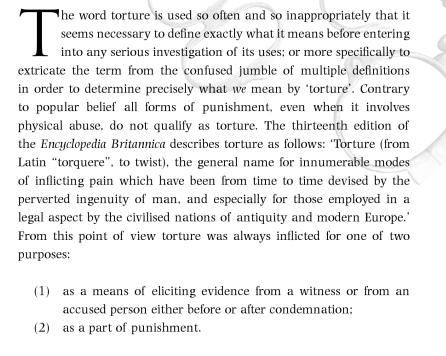
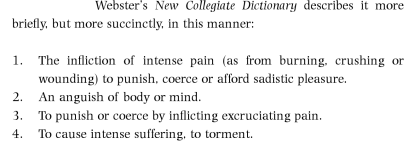
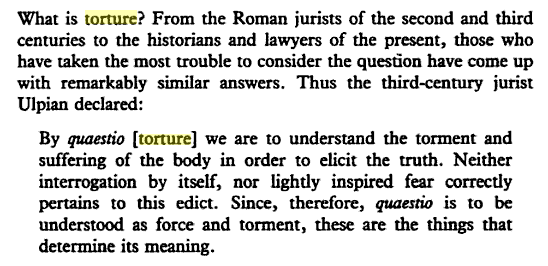
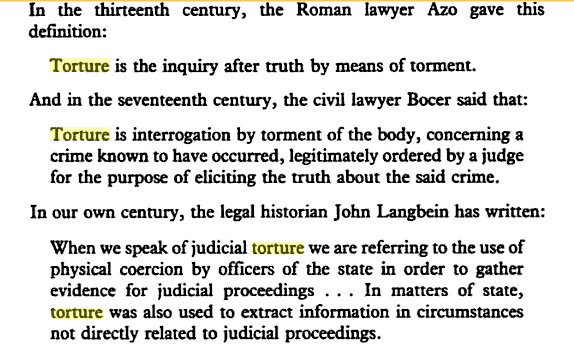
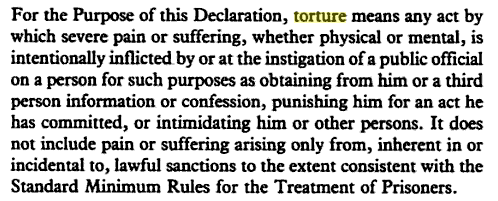


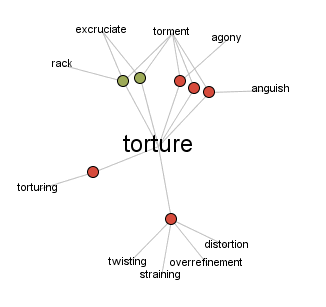
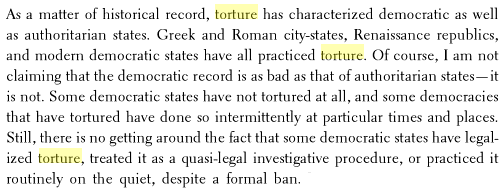
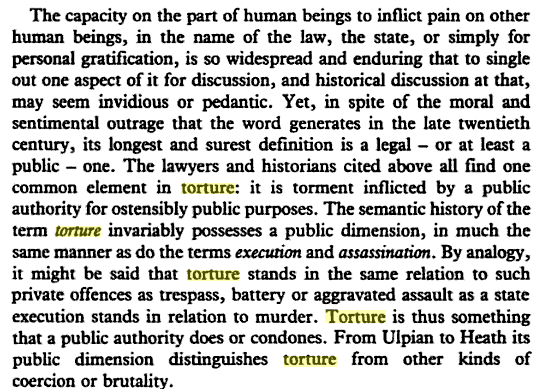

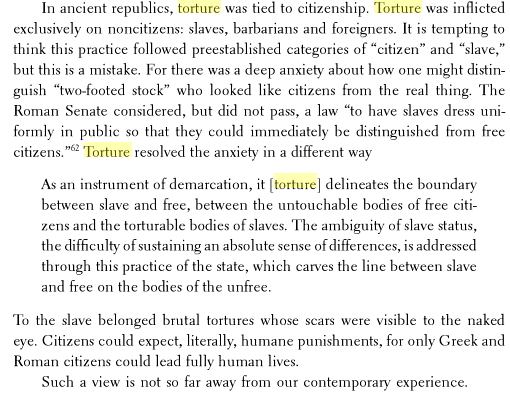
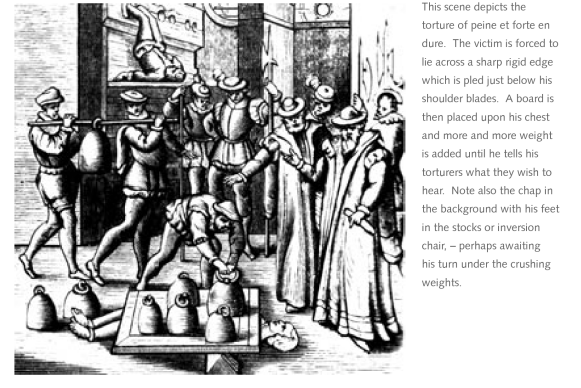


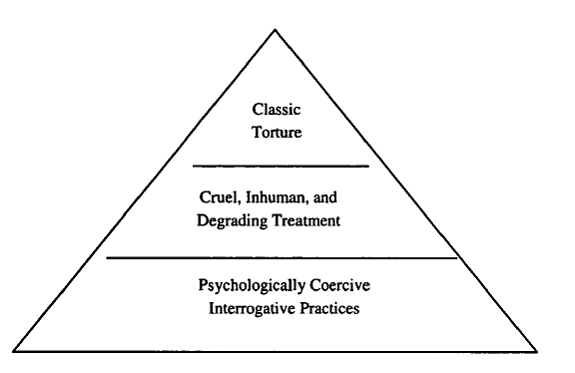
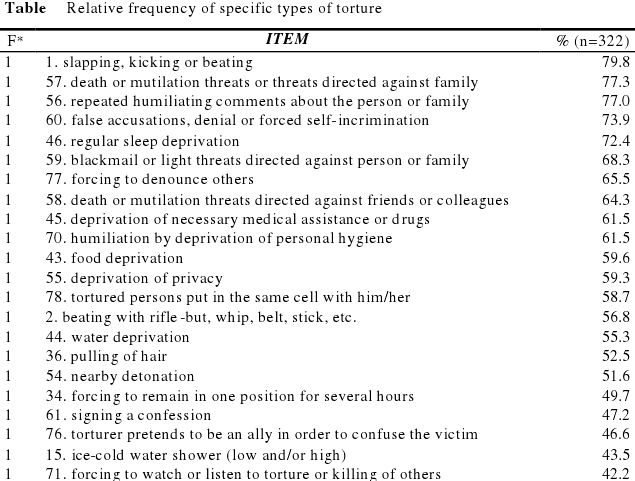
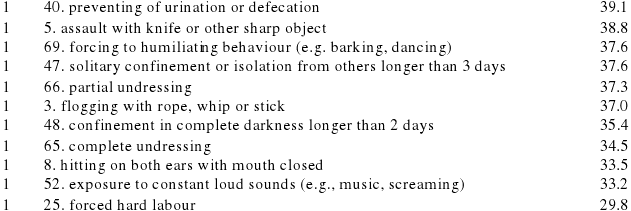
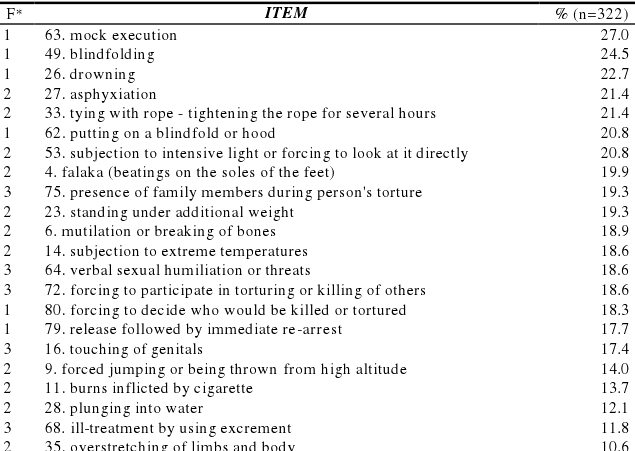
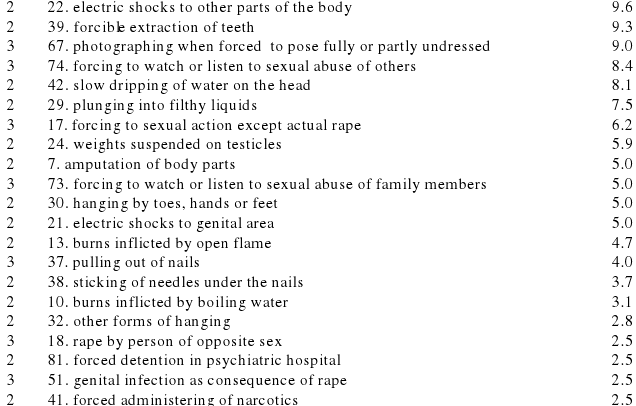

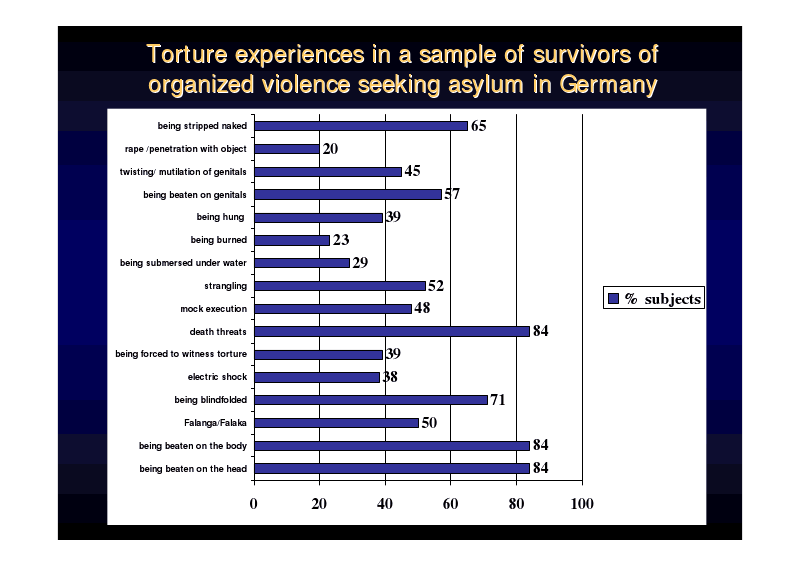







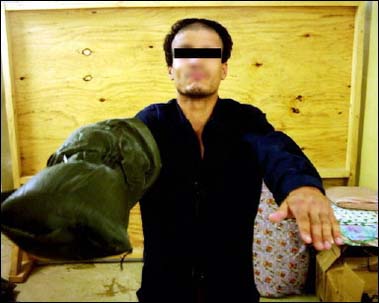




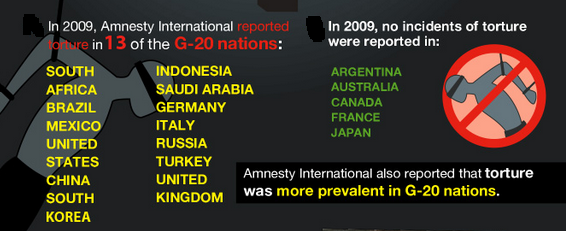
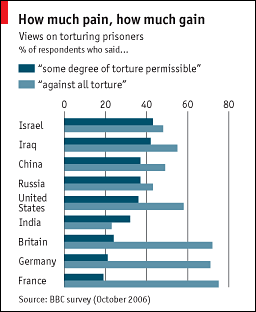
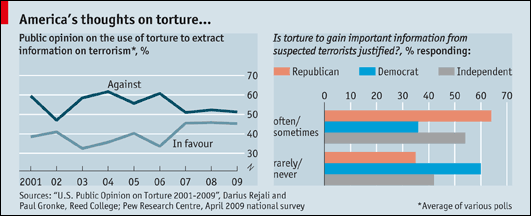
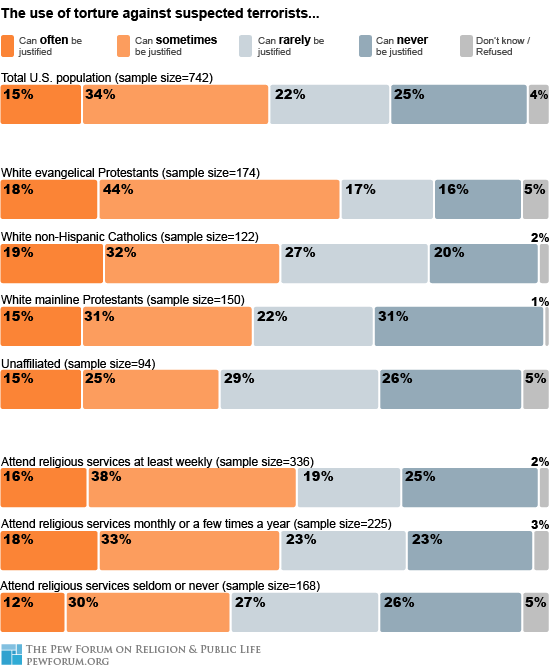
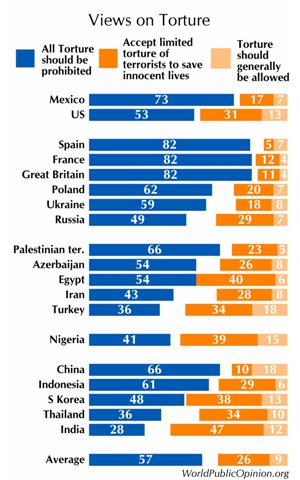

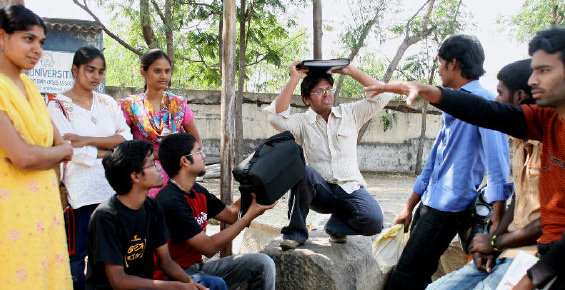
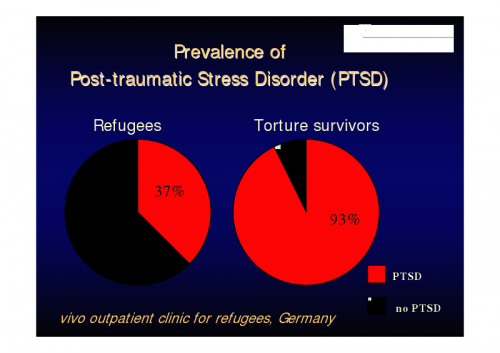

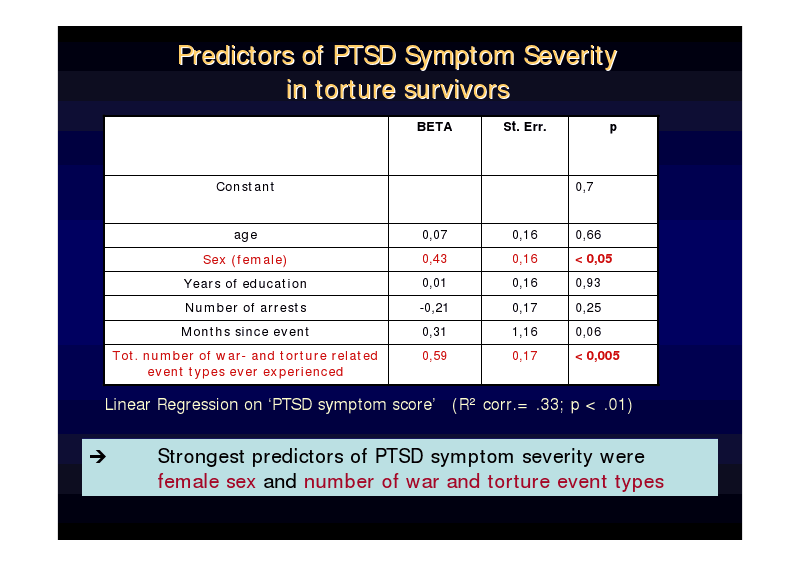
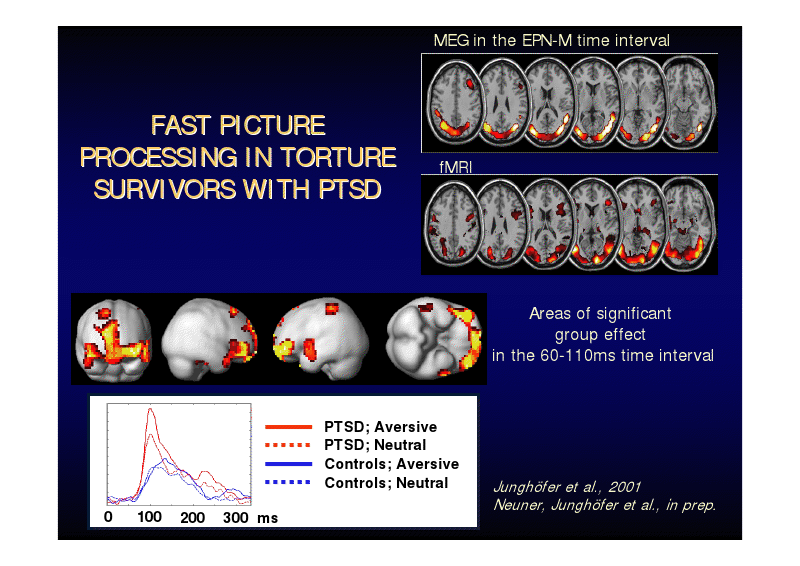



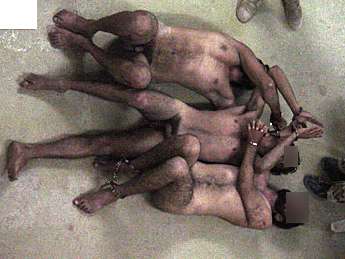



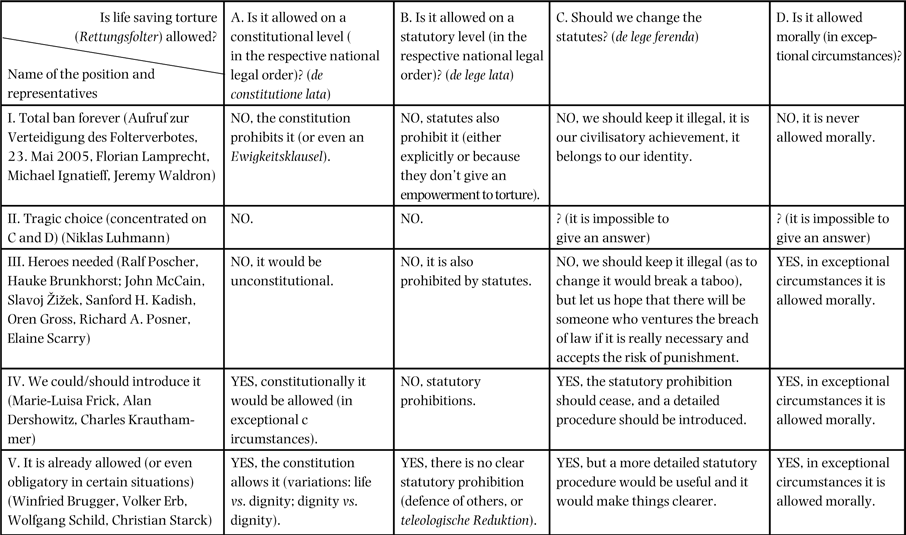

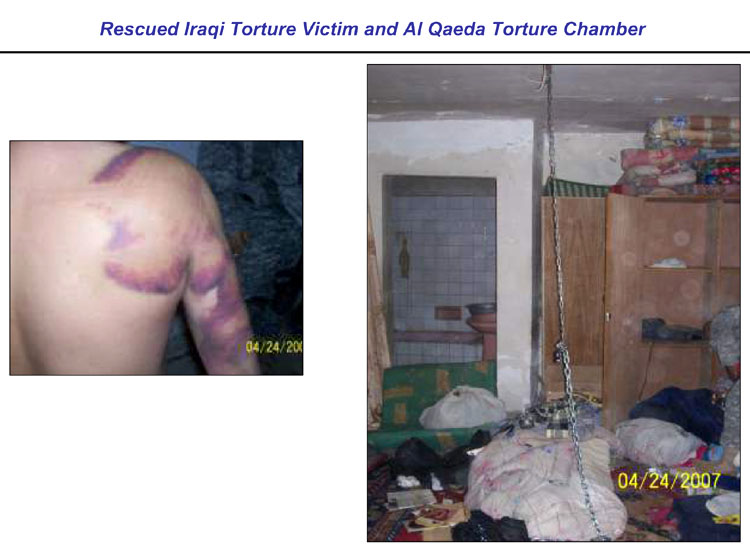
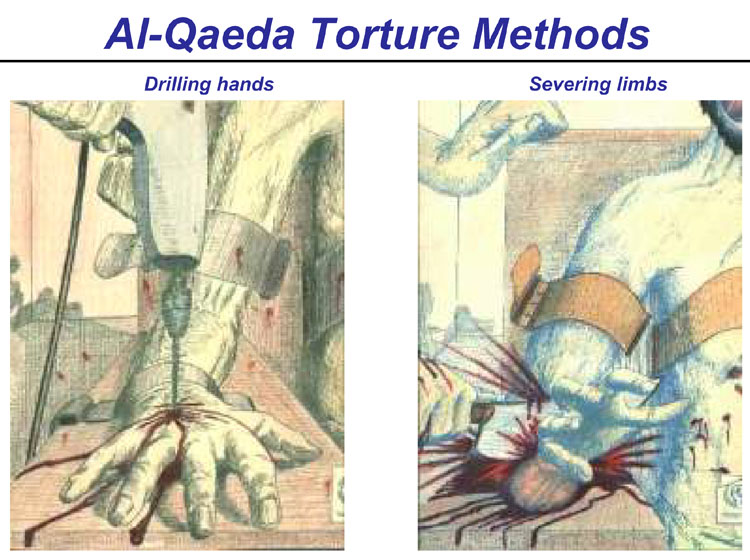

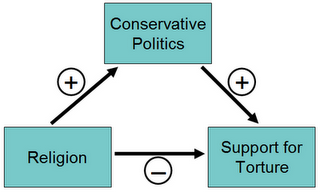

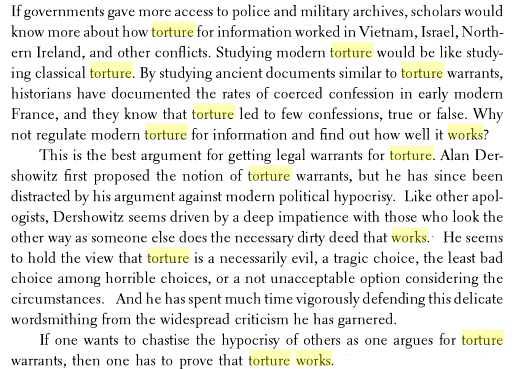

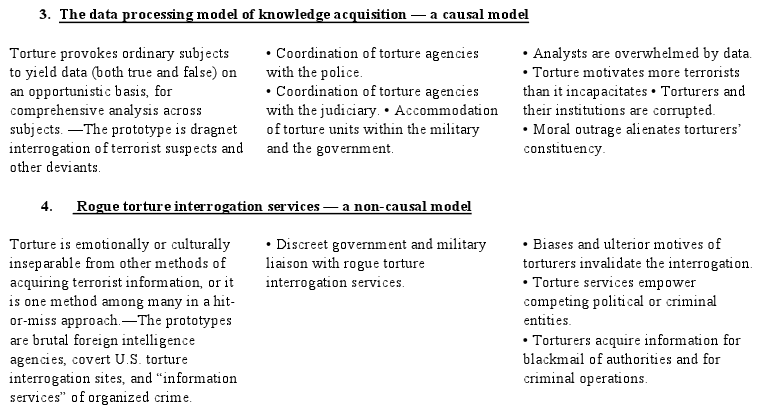

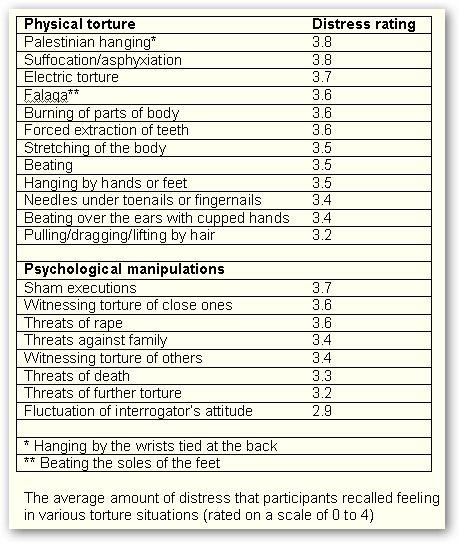



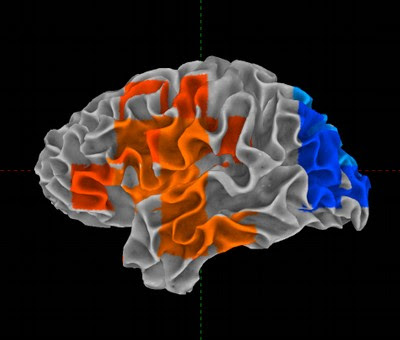


I blog often and I really thank you for your information. This great article has truly peaked my interest. I will bookmark your blog and keep checking for new information about once a week. I opted in for your RSS feed as well.
Remarkable is the one quit option for a more effective and healthy life.